

Best Women’s Safari Clothing for Africa Overland Travel
Africa Packing Lists , Packing Lists , Travel Packing Lists
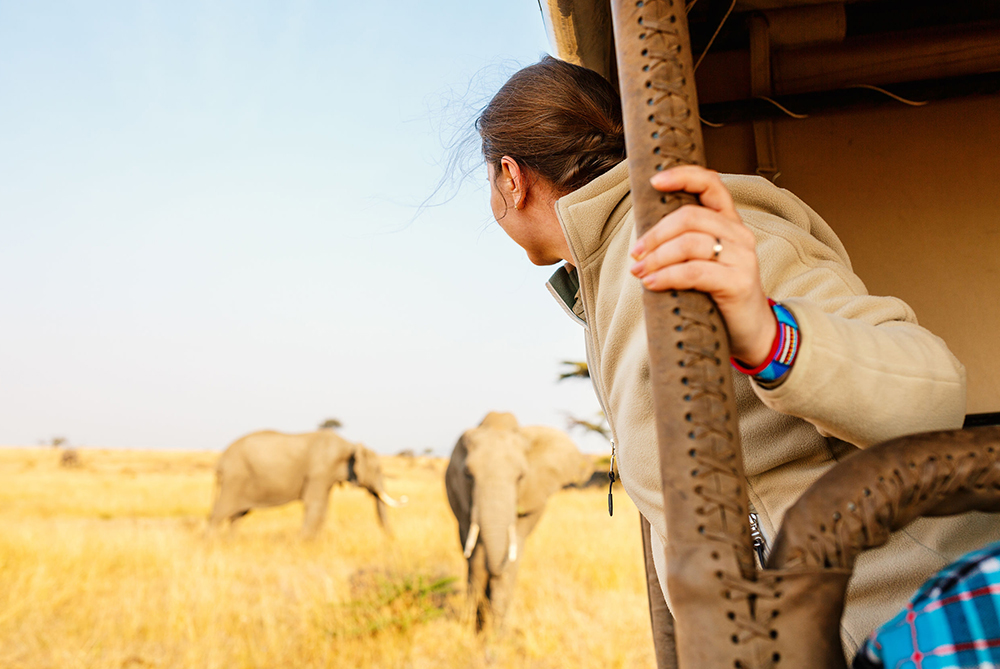
Support TFG by using the links in our articles to shop. We receive a small commission (at no extra cost to you) so we can continue to create helpful free content. We earn from qualifying purchases made to the featured retailers. Thank you, we appreciate your support!
Planning a safari or overland tour through one of Africa’s incredible game parks? This is the best womens safari clothing for your trip. Read our complete guide to find out exactly what to wear on safari!
Women Safari Clothing
Table of contents.
An African safari is one of the most exciting trips you can take as a traveler. Roughing it in the wilderness surrounded by the Big 5 is truly a thrilling experience. There are several things to keep in mind when you choose safari clothing for this type of adventure.
How should I dress for an African safari?
The focus of your safari attire should be on comfortable safari clothing in neutral colors and light fabrics. If it’s not something you would feel comfortable wearing something on an overnight flight, it’s best to keep it out of your safari gear.
Safari clothes for Africa should be relaxed, so you can enjoy the experience to the fullest. The drive time on overland trips can vary anywhere from 6 to 12 hours each day. Making comfort key on those long-haul journeys — the distances in Africa are massive!
Expect your safari clothing to be covered in dust and keep in mind that you won’t have much time to do laundry. Your safari clothes should feature synthetic fabrics that are hard wearing, quick-dry, easy to wash, and won’t show dirt or dust.
What to Wear on Safari
When it comes to options for what to wear on an African safari, womens travel brands tend to feature technical fabrics focusing primarily on khaki and olive colors. But unless you’re planning to live in the bush or are taking a Gorilla trekking trip to the jungle, it’s likely that this type of clothing isn’t necessary.
The majority of Africa safari tours will see you viewing animals within the confines of a vehicle, whether a giant overland truck or 4×4 car. This means that the khaki safari shirt or safari pants that you purchased will tragically go to waste.

Safari Clothing Essentials Packing Guide: An Overview
Before we get into the nitty-gritty of your clothing options, let’s take a look at an overall view of what your safari gear for your travel capsule wardrobe should consist of. Here’s a quick snapshot of the amount of what should be on your bag when you’re planning what to wear on an African safari.
TFG Recommended Clothing List
4 sleeveless or short-sleeve tops 2 long-sleeve tops 1 dress or skirt 4 pants 1 shorts 1 windbreaker jacket 1 fleece or warm jacket 1 swimsuit 3 bras (sports bras are recommended) 3 socks 7-10 underwear 1 jacket 1 scarf 1 sunglasses
TFG Recommended Shoe List
1 pair comfortable sneakers 1 pair flip-flops
What is the Best Women Safari Clothing?
Whether you’re looking for what to wear on safari in Kenya or are camping in the Serengeti, you need the best of the best when it comes to your safari clothing. Our selections offer you a nice range of safari pants, tops, dresses, and even safari jackets. That way you can be confident and comfortable on your jaunt in Africa!
Best of all? You can avoid the head-to-toe khaki safari outfits that somehow became the must-have on an African safari. Here are some realistic clothing pieces you’ll love carting along with you:
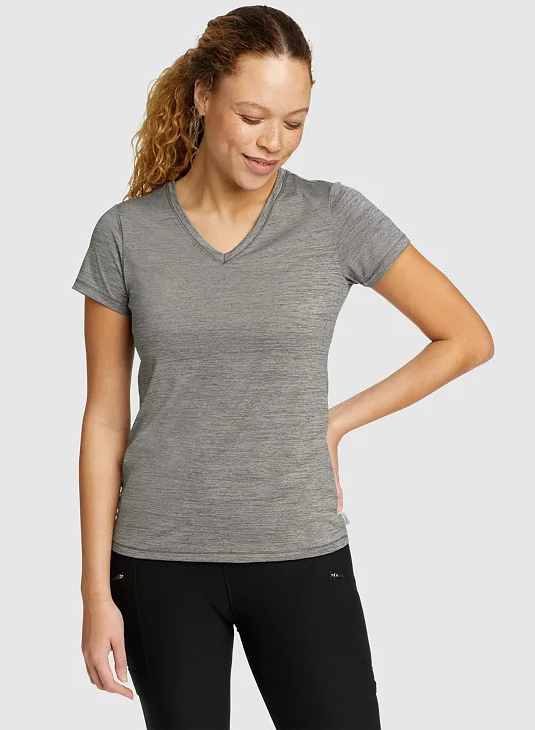
Shop Sizes XS-3X: Eddie Bauer Resolution T-Shirt
Best Safari Shirts for Women
As you plan what safari clothes to pack, make sure to bring a variety of tops and include sleeveless tanks, short sleeve tees, and long sleeves that you can layer!
The best safari shirts for the day time and warm weather are sleeveless or short sleeved breathable, moisture wicking tees in neutral colors.
For really hot days or to layer underneath warm items if cold, add a couple of casual tees. These also will be beneficial for those long safari travel days (read more on this in the Pants section below).
Stay cool with these moisture wicking shirts !

Shop Sizes XS-4X: Smartwool Merino Short Sleeve
Merino wool tops are some of the best safari shirts because they are both practical and can be re-worn without washing. This is particularly important on longer safari trips when you won’t have access to laundry for extended periods of time.
However, If you plan to hand wash your merino wool tops you’ll have to wait until you spend two or more nights in one location to allow time for the clothes to dry. This is why either quick-dry or long-lasting items are the best as safari clothes.
While merino wool is more expensive, you can get away with bringing just a few tops and then re-wearing them every few days. This is key for packing light!
Merino wool Icebreaker tops like these have a higher price point but are excellent for safari trips because they’re practical and you can rewear them (for weeks) without washing.
Learn more about how to hand wash while traveling !

Shop Sizes XS-XL: Icebreaker Merino Women’s Siren Tank
If you are traveling in hot weather, you might prefer a sleeveless top like the Icebreaker Merino Women’s Siren Tank one pictured above (perfect safari shirt). Like the short sleeve tops, the ideal fabrics are from performance brands with quick dry 100% cotton, merino wool, or synthetics.

Shop Sizes XS-XXL: Columbia Cades Cape Tank
If you’re looking for a sleeveless safari shirt that’s less body hugging, then one like the Columbia shown here is perfect.
A sleeveless top not only helps to keep you cool on your safari days, but it can also be dressed up when you’re visiting the city! Pair it with a cute skirt and you have an instant evening outfit. Double-duty top!
Plus, it also looks the part of an African safari shirt!

Shop Sizes XS-3X: Columbia Quick Dry Sun UV Protection Convertible Long Sleeve
For the sunny days you’ll want to bring one light but practical womens long sleeve safari shirt to protect you from the sun’s beating rays. This will be a piece you’ll want to re-wear, so we advise choosing a quick dry fabric so that when you wash it, it will dry relatively quickly!
The dark khaki convertible womens long sleeve safari shirt (pictured above) is not only quick dry, but it’s specifically designed for UV protection. Plus, with it being convertible you can make the sleeves longer and shorter based on your preference.
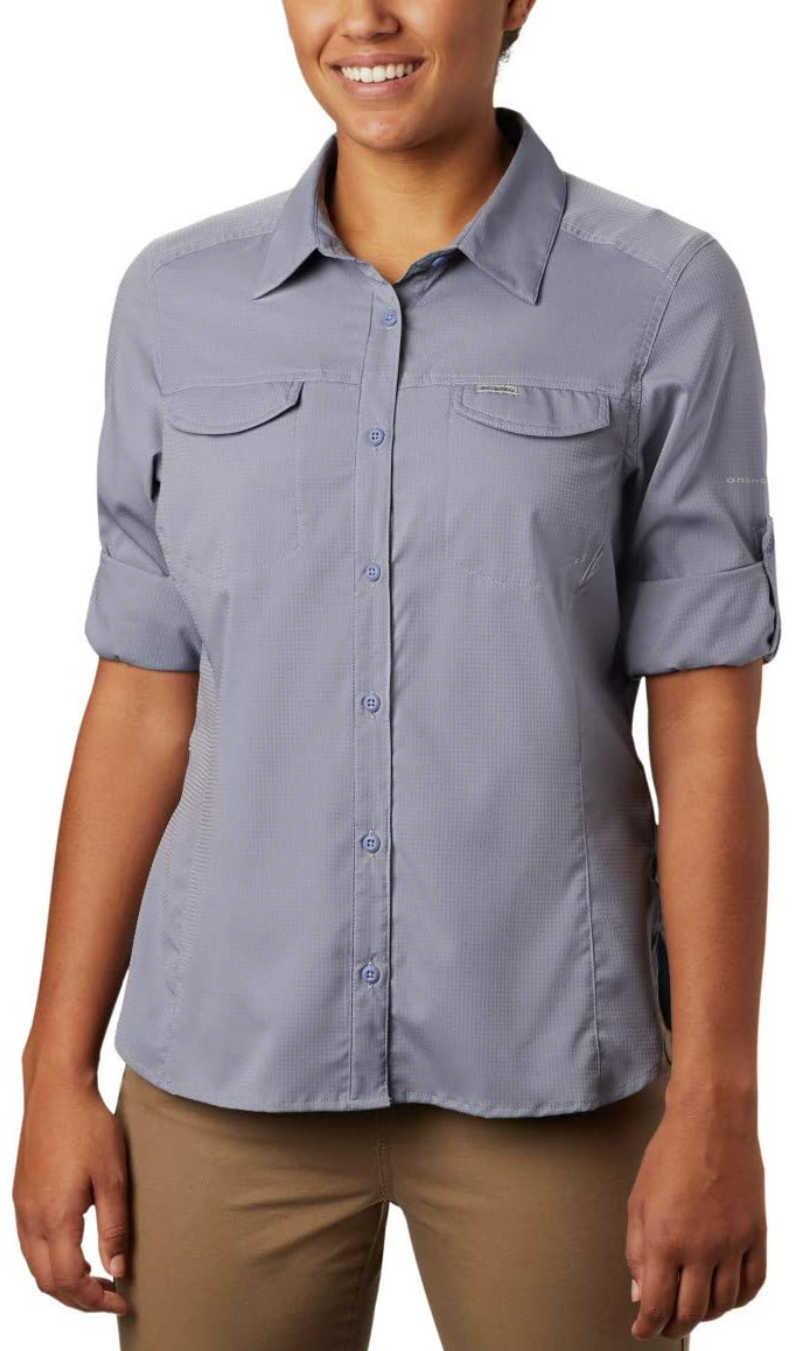
Shop Columbia Silver Ridge Lite Long Sleeve : Amazon | Columbia (Sizes XS-3X)
Can you wear grey on safari? Grey is a great color choice for safari clothes along with other medium to dark neutral colors like khaki. These colors are good choices due to the fact that your clothes are likely to collect a lot of dust, especially the ones you use for the outer layers, and the darker neutral colors are able of masking it.

Shop Sizes XS-XL: Unbound Merino Long Sleeve
When you’re planning what to wear on a safari, make sure to bring at least one warm long sleeve or thermal top . You should also include a long-sleeve blouse you can use to cover you from the winter sun and to wear in the cities.
Depending on the time of year you’re headed on your safari and the region in Africa that you’re going to, you might need to add a few extra long sleeve tops to your safari wardrobe to layer at night. It can get pretty cold!
Safari Packing Tip : You’ll want to keep your safari attire as light as possible. To keep your packing light, make sure to include six to eight safari shirts. Any more and you’ll be overpacking!
Best Safari Pants for Women
When you are actually on a safari, you are much more likely to be going inside of a vehicle — walking safaris aren’t the norm. Being inside a vehicle allows for the undisturbed observation of the wildlife in a natural setting. Perfect for safari adventurers!
Of course, it’s best not to assume. So if you aren’t sure that you’ll be in a vehicle, double-check with your tour operator (if you have one).

Shop Sizes XXS-XXL: Zella Live In High Waist Leggings
It might surprise (and excite you) to find out that some of the best pants for safari are leggings. Seriously! This is specifically the case when you are taking a driving safari tour, NOT if you are getting out of the vehicle and walking in the bush.
Leggings are the perfect safari pants choice for comfort. Avoid choosing thick fabrics that will take too long to dry if you are hand washing them.
Leggings are also great for travel days. If you’re looking for leggings to take on your safari, TFG readers voted for the best leggings for women , so you’re bound to find a pair you like! We also really love these leggings from Zella (which are also available in plus size ).
Leggings are the most comfortable, packabe safari pants. So they’re definitely a good choice to wear on safari. While you can easily wear a pair of black leggings when you’re inside the vehicle, you might want to consider a lighter color to wear outdoors by the campfire (you’ll thank us later).
Safari Packing Tip : Make sure to choose a legging color that you can easily re-wear in-between washes!

Shop Sizes XS-XL: Scuba Mid-Rise Pant
If leggings aren’t your thing, a good alternative is casual joggers. Lululemon — a much-loved brand by yogis and travelers alike — makes a great pair of chic joggers which are great safari pants. They also make some pretty nice leggings too!
The travel-friendly fabric in these safari pants makes them easy to clean and de-wrinkle. Plus, with four-way stretch and a drawstring waist, you can wear them comfortably on the longest of overland safari rides!

Shop Sizes 2-24: Amazon | Columbia | Zappos
When you first think about what to wear on African safari, you might imagine an outfit consisting of a khaki button down shirt and convertible trousers. But generally speaking, convertible pants are not a necessary item to add to your safari attire (unless they make you comfortable and confident, that is).
We recommend a modern-yet-functional pair of travel pants like Saturday Trail Pants by Columbia . Not only are these safari pants versatile, but more importantly they’re comfortable! They also pack light, dry quickly and don’t stain easily — what more are you looking for in your safari pants?
As an added bonus, they have a stretchy pull-up waist band that’s sitting down for long periods of time. It’s also easy to remove for quick bathrooms stops on an overland trip.
Here are 16 best hiking pants for women that are lightweight and practical!

Shop prAna Halle Pant: Amazon | prAna
If you’re looking for both more traditional and budget-friendly safari pants, these prAna travel pants are for you! Both safari pants are ideal for walking safari tours or trips that will incorporate both extensive time outdoors and inside a vehicle.
If you are going to be trekking through the bushes, we highly recommend making technical womens safari clothing part of your wardrobe.
When you’re planning on what to wear on safari, make sure you always pack a pair of safari shorts! Safari shorts are casual and easy-to-wear on hot days.
You might also want to consider including a breezy long skirt or sarong. Both make it easier to “pop a squat” on the side of the road without baring it all to your tour mates!
Travel Tip : There aren’t usually bathrooms along the long roads, and stops are typically infrequent.
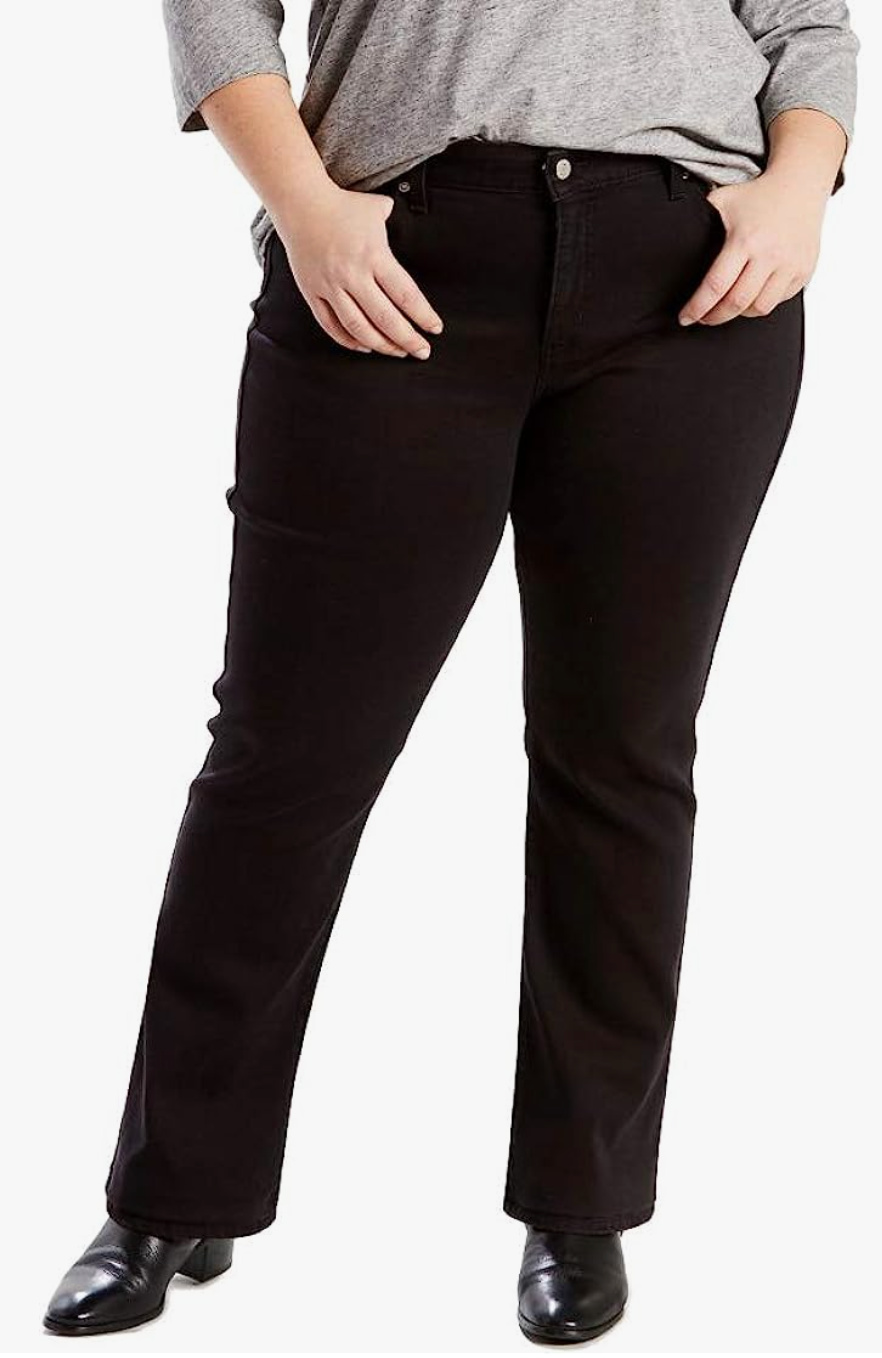
Shop Sizes 26-40: Levi’s Classic Straight Jeans
Can you wear jeans on safari? Jeans are a must, especially if you’re traveling in the winter! Sometimes the best women’s safari clothing isn’t necessarily the most technical travel gear. Jeans are not only practical, but they’ll provide you with warmth disguise dirt, and also give you a bit of style if you make a top in a major city like Cape Town!
But make sure not to hand wash your jeans! They’ll take way too long to dry. Denim is practical because you can re-wear it constantly without washing it. Denim designers make them specifically for multiple uses, and it’s one of the main reasons that modern travelers pack jeans. Jeans are a must-have when it comes to what to wear on safari !
You’ll also want to have a comfortable pair of pants that you can wear around the campsite at night.
Safari Packing Tip : Make sure you’re packing light. You should need no more than 5 pairs of safari pants.
Best Safari Dresses

Shop Columbia Freezer III Dress: Amazon | Columbia (Sizes XS-3X)
A dress may sound like the exact opposite of safari clothing. But, it’s always good to have at least one dress that you can sport on the beach in Zanzibar or wear out to a nice dinner at Victoria Falls.
The best safari dress is a little black dress that you can dress up for restaurants or a fun night out in the city. This one by Columbia features wicking, cooling, and sun protection fabric. Plus it’s available in sizes up to 3XL.
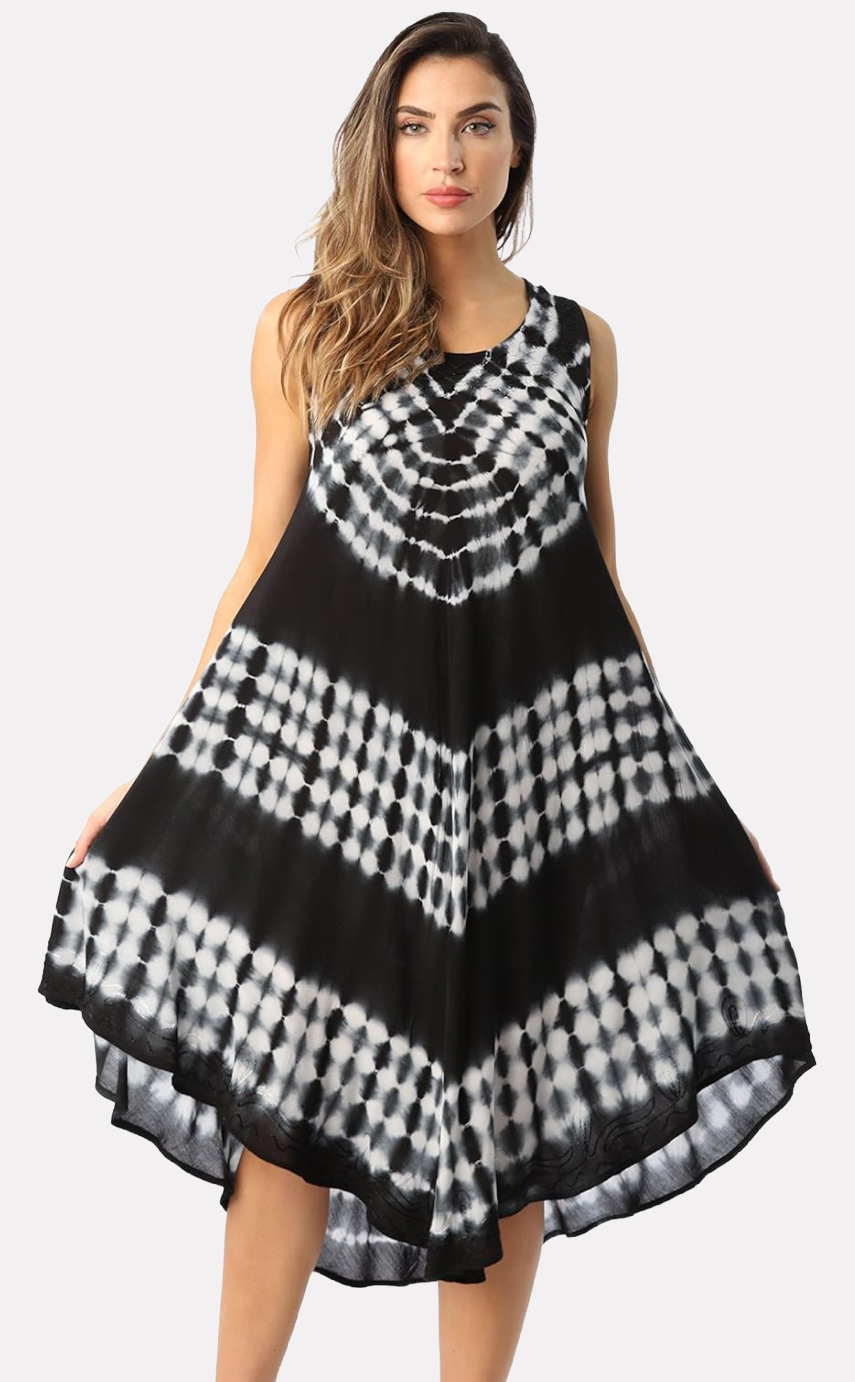
Shop Sizes S-3X: Riviera Sun Tie Dye Summer Dress
When it’s hot, a loose and lightweight safari dress is also ideal for those long overland trips. In fact, dresses are more practical than pants — especially when you need to stop on the side of the road for a quick bathroom break in the bush along with your fellow tour mates!
When it comes to picking the best safari dress, choose something both versatile and comfortable. When it comes to choosing what to wear on safari, you’ll want a dress that can be worn on the beach and doubled for dinner and night on the town!

Shop Sizes XS-3X: WEACZZYLoose Trapeze Dress
If you aren’t a person that’s comfortable in dresses, you simply don’t like them or you’re going to be traveling when it’s colder, a long tunic top that covers your backside cans also do the trick for those safari roadside bathroom stops.
Long tunic tops can be versatile just like a safari dress — you can wear it in the camp after a shower, on the beach over your bathing suit, loosely over a comfy pair of safari pants or tick it into your shorts for a cute but casual safari outfit!
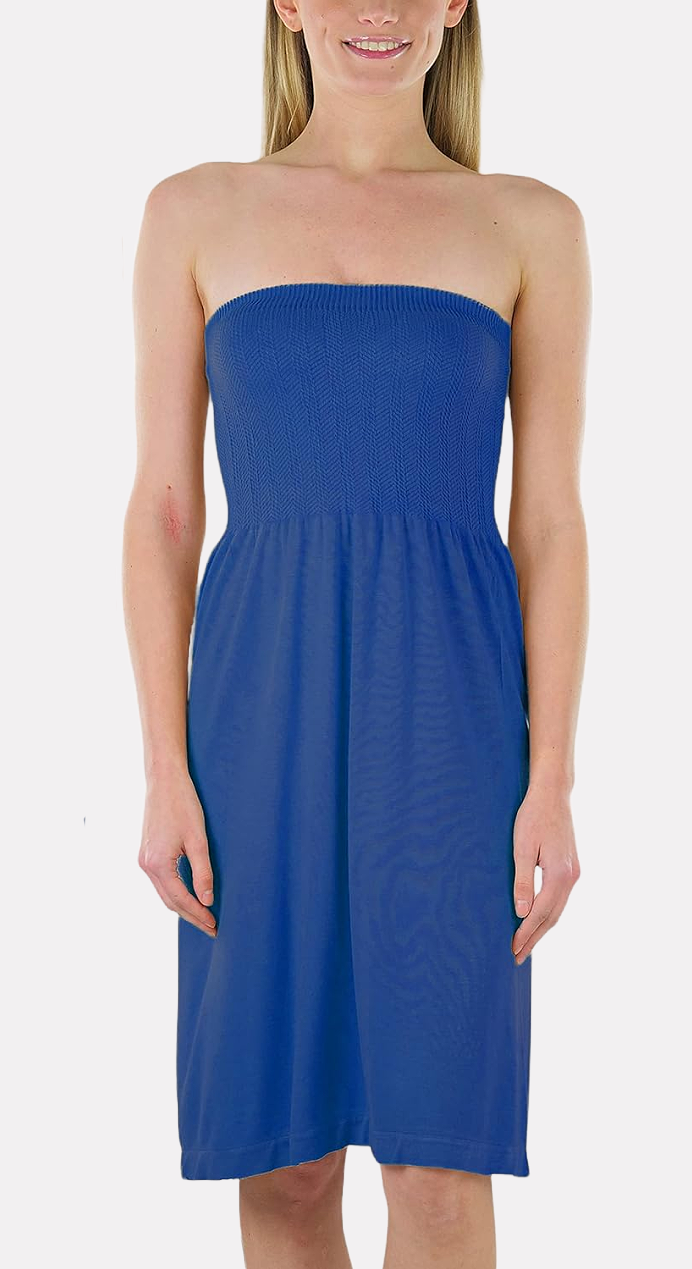
Shop One Size: ToBeInStyle Strapless Dress
REALLY IMPORTANT TRAVEL TIP : WHEN PLANNING WHAT TO WEAR ON SAFARI, AVOID ROMPERS. ESPECIALLY ON AN OVERLAND TRIP FOR TRAVEL DAYS . YOU DON’T WANT TO HAVE TO PULL OFF YOUR ENTIRE ROMPER TO USE THE BATHROOM ON THE SIDE OF THE ROAD. NOT COOL .
If you’re something that has the same comfy and lightweight feel as a romper, opt for a strapless sundress like the ToBeInSty Strapless (seen above). You can wear it as a safari dress during the day for those long safari travel days or layer it over your leggings if it gets cold outside.
A strapless dress can also be worn as a safari skirt. Simply pair it with a cute top and dress it up with some jewelry that you find at a local shop during your travels!
Remember to avoid choosing bright colors on a safari so you don’t draw attention away from the safari (or frighten away any animals!). But if you pack bright colors in your safari wardrobe, you can wear them on travel days when you’re not on a game drive.
If you’re looking for maximum versatility, one of these convertible travel dresses might be perfect for your safari attire!
Best Safari Clothing for Cold Weather

Shop Sizes XS-XL: Terramar Silk Undershirts | Terramar Silk Thermal Pants
Contrary to what you might think, it does get cold in Africa. That means that layering your safari clothes is key to surviving those cold African days. We’ve previously written about how to layer for cold weather , we’d highly recommend you take a peek before you start packing!
Regional climates in Africa vary throughout the season, so be prepared to encounter both hot and cold temperature. Make sure you always check the weather forecast before you go so you’re dressed right!
If you happen to be traveling during the cold season, from May to August, you might want to consider packing a set of thermals for women with your safari clothes so you can stay warm. You can wear them up to two weeks (or longer) without having to wash them!
Safari Packing Tip : For maximum warmth, pack one set of merino wool thermals. Especially if you’re camping in the winter!
Best Women’s Jacket for Safari
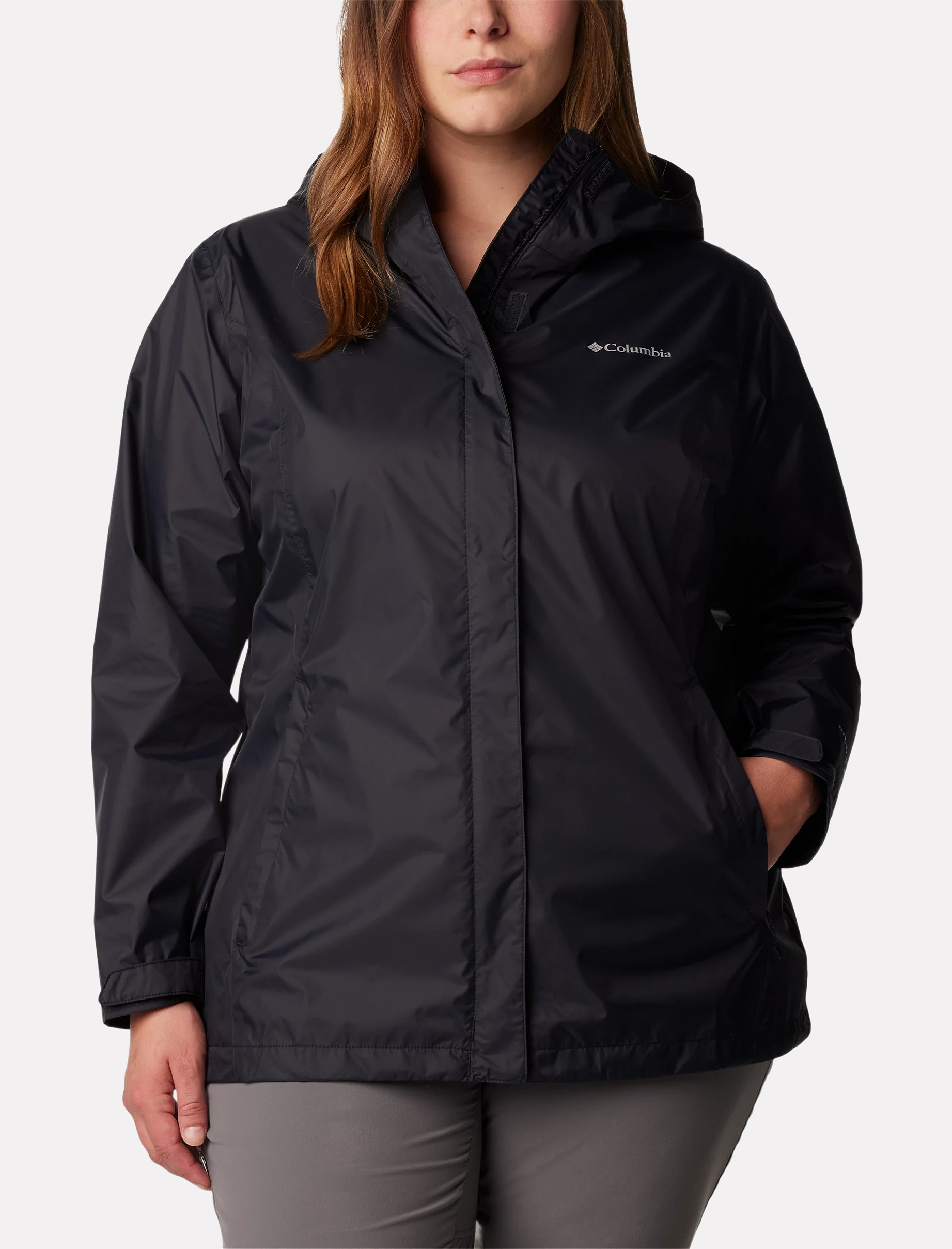
Shop Sizes XS-3X: Columbia Womens Arcadia II Rain Jacket
As you’re preparing your safari clothing checklist, make sure you pack a good jacket for safari. The roof and windows of some safari vehicles are open as you drive around the parks. With those open windows it can get quite chilly both at dawn and during night drives.
When you’re looking for the best jackets for safari, you should look for a good, quality jacket that can also serve as a windbreaker. You’re sure to feel a chill in the air with an open window first thing in the morning!

Shop Columbia Full Zip Fleece Jacket: Amazon | Columbia (Sizes XS-3X)
A travel fleece or rain jacket for safari are most needed when you’re doing an African overland trip that crosses various countries. When deciding what to wear on safari, make sure you don’t underestimate how cold it could get in Africa on your trip!
While it might be hot and sunny during the day, when the temperature drops at night you’ll be glad you packed a rain jacket and fleece in your safari clothes. TFG has a list of the best windproof jackets and fleece jackets for your travels.
When you’re packing your safari wardrobe, make sure you pack both a windproof jacket and a merino wool or fleece jacket for safari clothes.
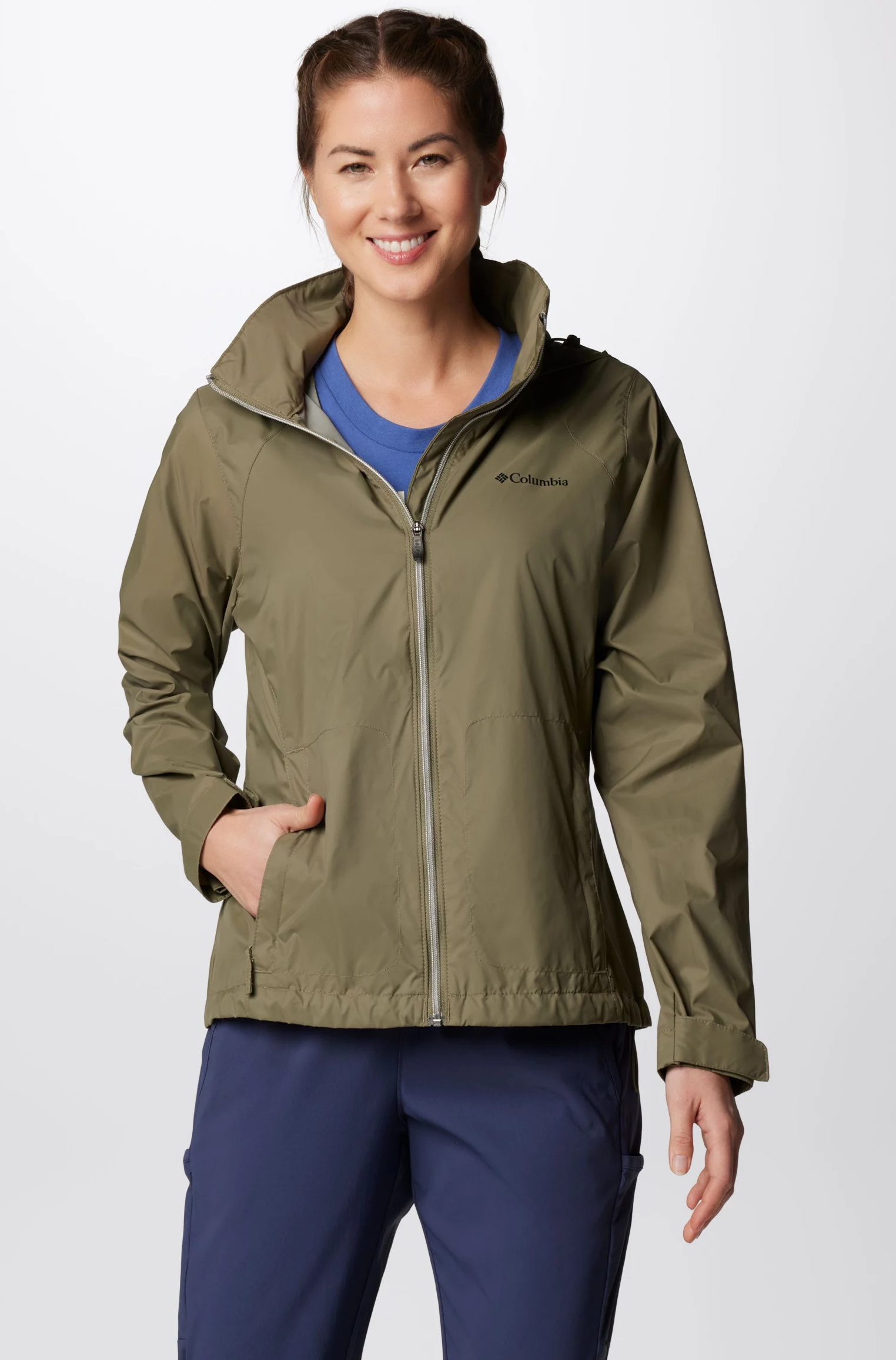
Shop Columbia Switchback Jacket: Amazon | Columbia (Sizes XS-3X)
Remember to choose neutral tones for your safari clothing. This is especially the case for items that are highly visible such as your jacket for safari.
Trust me on this one. If you’re head is hanging out of a vehicle at 5:30am, you’ll feel the crisp morning air and wish you had a warm jacket — it happened to me!

Shop Sizes XS-XXL: Style & Co Safari Jacket
For a stylish jacket for safari option that you can wear as part of your safari outfit, the Style & Co Safari Jacket is both chic and practical. When it comes to choosing a jacket for safari that’s neutral, easy-to-clean and will hide the dust, go for the grey, khaki, or olive green color!
Best Safari Shoes

Shop Merrell Moab 3 Shoe: Amazon | Zappos
Now that you’re packed and ready with your safari clothing, it’s time to plan your safari shoes! This is probably going to be much easier than you think!
We recommend taking only two pairs of shoes. When it comes to picking those safari shoes, go with a pair of sneakers and flip flops (for camps, shower, and beaches). Your sneakers should be something comfortable you can wear on the truck, for occasional safari walks, and at the campsite at night if it’s cold.
However, if your safari itinerary includes walking safaris, you’ll need substantial sturdy safari shoes. For multi-day treks through the jungle, you’ll want to bring sturdy hiking boots . But for the occasional day trip, regular all-terrain sneakers or hiking shoes will work as safari shoes.
Ideally, you’ll want your safari shoes to be waterproof and easy to clean in case they get muddy or otherwise dirty.

FitFlop Iqushion Super-Ergonomic Flip-Flops
Flip-flops may seem like a random item to add to this safari packing list. But it’s nice to air out your toes if you’ve had them in sneakers all day. Flip-flops are also great safari shoes as they’re convenient to wear in camp showers. And don’t forget about the beach!
Not a big fan of flip-flops? Try one of these slip-on beach sandals as your second pair of safari shoes instead. Throw in a pair of cute ankle boots or stylish slip ons if you’re traveling in Cape Town .
But make sure not to add too many shoes to your safari wardrobe!
Best Safari Socks
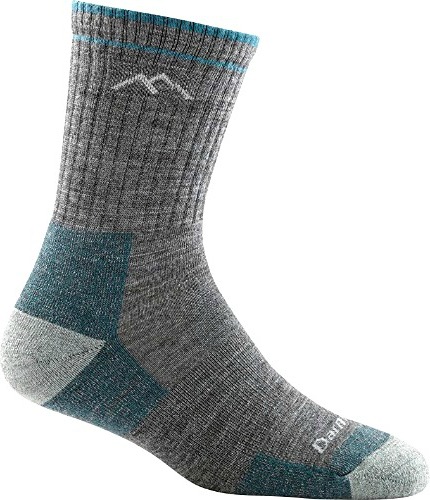
Darn Tough Crew Socks
Whether you need to pair your socks with safari boots or sneakers, make sure they are moisture wicking socks ! This is particularly important so you can keep your sock numbers down.
I know we’ve mentioned merino wool a lot, but just as with the rest of our suggested safari clothing, merino wool socks are perfect to pair with your safari shoes because you can rewear them multiple times without having to wash them.

Kirkland Signature Trail Sock
Several TFG readers agreed that Kirkland’s merino wool socks are a great pick to add to your safari wardrobe. One reader says, “I wash them in cold water and hang them to air dry, but they have held up really well and keep my feet warm, too.”
If you’re camping, you can bring a pair of Kirkland socks (like the ones shown above) to keep your feet warm at night. If you choose dark colors or prints they won’t show the dust as easily.
Best Bras and Underwear for Safari

Panache Underwire Sports Bra
Last but not least for your safari travel checklist, make sure to pack a good sports bra for the bumpy journey! Vehicles in Kenya, and other countries, often cover all terrains including deeply rutted roads and huge potholes.
Make your ride more tolerable by wearing a sports bra whenever you are being transported. Also, take some motion sickness meds beforehand if you are prone to car sickness.

Shop Sizes XS-XL: Icebreaker Siren Merino Wool Bikini
Also, quick dry travel underwear helps you easily do laundry without having to wait ages for it to dry!
Because you may be moving locations every night, you won’t have much time to wash your safari clothing, so it’s best if you bring fast drying fabrics or clothing you can re-wear easily.
Safari Travel Tip: Most of the time, you’ll be popping a squat on the side of the road, so a female urinary device or even a flowy skirt might be helpful if you’re not crazy about the idea of flashing your goods. Don’t forget your antibacterial hand wipes!
Other Safari Gear

UPF 50+ Sun Protection Quick Dry Baseball Cap
TFG has a great post on what to pack for African safari tours that we’d highly encourage you to check out so you know what other safari gear you’re going to need on your trip!
To go along with your safari clothing choices, you’ll need a few accessories.
Hats are great because they can help shield you from the sun and hide unwashed hair. But while hats are a definite must, but that doesn’t mean they have to be unattractive.
When it comes to your hair, you will want to keep it covered and pulled back in a ponytail or bun so it doesn’t get tangled in the wind and full of dirt from the road. We have a few suggestions for some hair accessories that will help keep high maintenance hair on the down low during your safari tour.

Compass Rose Secret Bra Wallet
Sunglasses are also a must-have, they offer shade and protection from the sun which is really important considering how close to the equator you’re going to be! A few other safari necessary accessories include a bathing suit and scarf.
Don’t be a target for unwanted attention. When you choose what to wear on safari, make sure you don’t dress too flashy or showy. Make sure you don’t bring any of your expensive jewelry and leave your designer handbags at home (or another safe place).
Finally, conceal the majority of your money and extra credit cards for extra safety. This bra wallet is a great way to do that!
We’ve got some great anti-theft tips for you so you can protect your valuables during your safari travels.
Essential Packing List for Safari

Shop Osprey Fairview 55L: Amazon | Osprey
Which luggage should I choose for safari?
When it comes to choosing luggage for safari, check out the Osprey Fairview 55L . It’s kind of perfection.
I found it easier to lug a soft bag than a suitcase, as everyone’s gear gets piled up under the truck. I personally use it with the Compass Rose packing cubes to stay organized and fit in everything!
Don’t worry so much about the baggage weight. My bag never goes over 30 lbs using the guidelines suggested on the site. If you aim to pack light, you shouldn’t be overpacking!

Left: Compass Rose Medium Packing Cubes (13″ x 8.5″ x 2.8″) | Right: Compass Rose Slim Packing Cubes (13″ x 5″ x 2.8″)
Should I use packing cubes on safari?
Yes! You should definitely use packing cubes on safari. Packing cubes will help keep you organized, keep your bag light, and help you avoid over packing.
Many readers use our packing cubes for this task. The Compass Rose Packing Cubes are now offered in two sizes: slim and medium. The slim size cubes measure 13 x 5 x 2.8, and the medium size cubes measure 2.8 x 13 x 8.5. Both fit an international carry-on suticase and can help you organize and compress clothing items. The medium sizes is great for bulkier items.
Watch this video to learn how to pack light thanks to packing cubes!

pStyle Urinary Device
What should I pack for toiletries on safari?
When it comes to what you need to pack for toiletries on safari, there are a few things you’re definitely going to need.
You definitely will want to have a female urinary device , because the only bathroom breaks you get are in the bush. Finding adequate coverage can be a challenge, so you might also need to get comfortable with flashing your bum at other women on the trip!
You’ll want to bring a travel towel so that it can dry quickly when you’re constantly on the go. You should also pack any prescriptions you might need along with mosquito repellent … don’t forget that! And while it’s not exactly a toiletry, you’ll want a collapsible water bottle , too!
If you’re going to go the carry-on only route, make sure you cut back on your toiletries. It’ll help with TSA if you put all of your liquids in a Ziploc bag, following the 3-1-1 rule !
Learn all about packing toiletries with this guide !

Travelon Anti-Theft Cross-Body Bag
What should I take for a purse on safari?
You’ll want to choose a bag that can fit into your carry-on when it comes to the perfect purse for safari. TFG recommends taking a crossbody travel purse with anti-theft features like the Travelon Anti-Theft Cross-Body Bag bag or other similar purse.
See our picks for the best anti-theft purses for travel .

Lewis N. Clark Deluxe Neck Stash
What anti-theft accessories do I need on safari?
We recommend you make sure your purse is built for security. Other great anti-theft accessories for safari might include a secret bra wallet , neck wallet , or even a money belt.
Read about popular anti-theft accessories !

International Travel Adapter
What electronics do I need on safari?
A headlamp will be a lifesaver when it comes to camping at night during your safari.
A few other things that might come in handy include a travel adapter , portable battery charger , and your headphones . Plus, if you’re planning on taking any pictures, you’re going to need your camera and gear!
Printable Travel Checklist

Don’t forget to download the TFG Printable Travel Checklist
The Dos and Don’ts of Safari Clothing Packing
Packing for your African safari can seem overwhelming, so let’s finish off by going over our main dos and don’ts when it comes to getting together your safari gear and planning your safari attire!
What should you not wear on safari?
What you shouldn’t wear for an African safari depends highly on the actual trip type that you’re participating in. An overland trip that touches on a variety of countries is going to mean different must-haves from a short safari to Kruger Park that’s smack in the middle of a longer trip.
If your African safari trip is long, you’re going to want to focus on making comfortable, practical safari clothing a priority. But if you’re headed on a short three-day trip, you can definitely get by with wearing regular clothes.
But for both trips, we highly recommend that you DO NOT wear a romper on a safari — three days, seven days or otherwise. We know that we’ve mentioned this before, but it’s such an important note that we want to talk about it in a little more detail!
When you’re on an overland safari trip, it’s common place to simply pull over on the side of the road to go to the bathroom — in public — as there really aren’t bathrooms along the way. The reason why we stress that you shouldn’t wear rompers is due to the fact that going to bathroom in a romper means taking all of your clothes off to go to the bathroom.
While you might be able to find a somewhat “discreet” spot in the pushes to pop a squat, you’ll still be pulling off your entire romper in public and it’s much harder to attempt to conceal the top and bottom half of your body at the same time. It’s much easier to focus on covering your backside.
We know you’ll thank us for this advice later!

What colors should you wear on safari?
As exciting as it is to experience nature in its rawest form, you don’t have to immerse yourself to the extent that your safari clothing completely blends in with the foliage and desert itself. We can leave that for the Hollywood movies!
With that in mind, the best colors for safari clothes include:
- Olive green
A tip for picking the best color for your safari clothing is to go with colors that are inspired by nature. Measure your clothes with the image above, if they’re in the same tone, intensity and relatively the same color they’re good to go. You’re looking to blend in, but you don’t have to look like Crocodile Dundee or wear full tactical gear!
What color should you not wear on safari?
If you’ve done your safari clothing due diligence, chances are you’ve come across something that tells you not to wear bright colors. It seems like a strange request, but it’s recommended that you choose neutral colors because you don’t want the animals to see you — if they do they might be scared off!
Stick to neutral colors but avoid white because your safari clothes are bound to get very dirty, especially if you’re camping, and white will show it all!
Can you wear black on safari?
Wearing black on safari is not recommended. Black clothing attracts mosquitoes, and you’ll want to avoid that as much as possible to keep your trip its most enjoyable!
If you do end up bringing some black pieces, keep them to a minimum and opt for lightweight fabrics wherever possible!

What are your tips on choosing the best womens safari clothing? Share and comment below!
For more Africa packing lists, please read:
- What to Pack for Safari: South Africa to Zimbabwe
- What to Pack for Africa: Safari and Beaches
- Africa Travel Packing Tips
- 10 Essential You Absolutely Need for Safari
Suggested Travel Resource:
- Lonely Planet Tanzania
- Lonely Planet South Africa
- Lonely Planet Africa on a Budget
LIKED THIS POST? PIN THIS PIC TO SAVE IT!
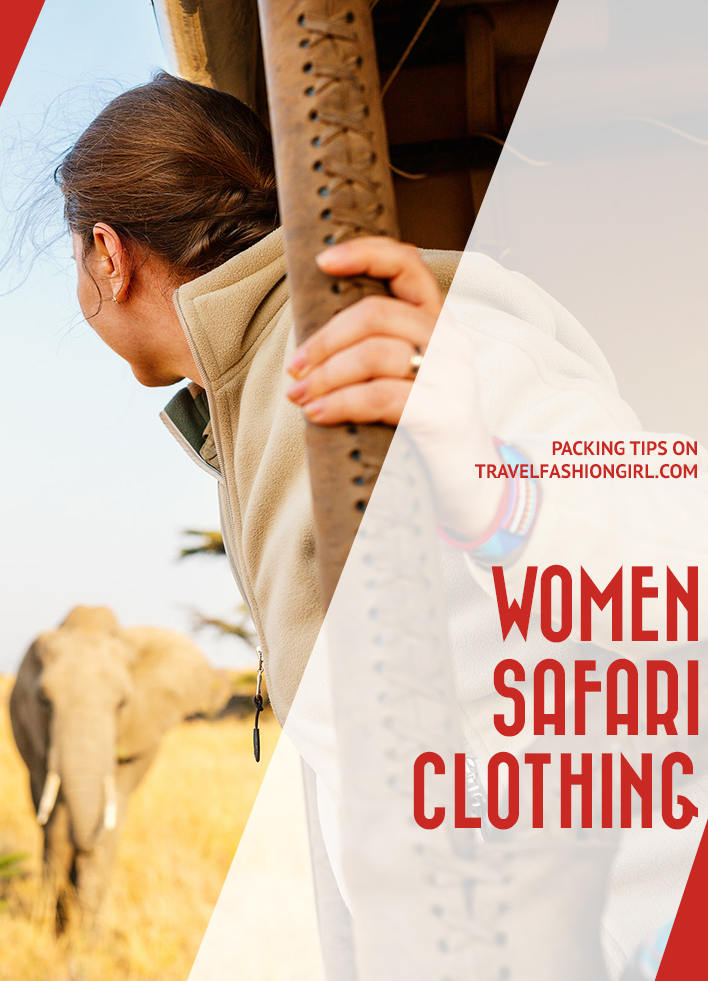
Hope you liked these safari clothing women’s tips. Don’t forget to share this post on Facebook, Pinterest, or Twitter. Thanks for reading!
63 comments.
I’m going on a safari next week, and the packing list looks like it would be a lifesaver, but I’m getting an error that the page is unavailable when I click on it. Anything I’m missing? Thanks!!
Hi Amy, I am so sorry about this. Please can you email us at [email protected] so we can send it over to you.
Have a wonderful time on your Safari!
On August 2, 2022, Just got back from South Africa; Cape Town, Cape Winelands, then off to safari at Kruger; Victoria Falls, Zimbabwe; Botswana, Okavango Delta! It was a great 12-women trip, Women, Wine and Wild. I researched and looked at this site for everything from suitcases, carry-ons, cross-body bags, packing, lists of clothes, shoes, jackets, underpinnings, toiletries, hats, scarves, etc.; for varying types of travel, city, winelands, safaris, and Travel Fashion Girl came through on all fronts – I was ordering things left and right even in the last few days and got it all together and had the most wonderful trip. I may have taken a little too much, but I really used most everything I brought so it all worked out. But as they say, less is more; I wouldn’t bother even with a little heel for dinners out if it’s only a few night in a city. I wouldn’t take as many pants as those can be interchangeable pretty easily, especially if you bring a few blouses/tops. For chilly mornings or evenings, a lightweight puffer jacket was perfect. And scarves are perfect to help mix it all up and really be able to wear the same things with different scarves. TFG is an amazing place to go for everything travel; I love it!
Just got back from our 3 week honeymoon on safari in Kenya and Tanzania including a week in Zanzibar – these packing lists from TFG were so helpful for knowing what to expect and helping to minimize how much luggage to bring. Definitely recommend carry on backpack for this trip to fit in the small trunks of the land cruisers and for small airplanes (we took one with only 12 seats!)
This recommended packing list was just what I needed for a 10-day safari in Tanzania.Thank you 🙏
Someone recommended we take soft travel bags to fit onto the small airplanes which I would NOT do again. Due to their weight, it made the grueling trek through airports a painful experience 😣 Instead, we would have preferred rolling, carry-on luggage. My two-cents, but unless you travel lightly, soft bags aren’t the way to go for this type of trip. Anyone else?
Thank you for sharing your own feedback with us Tracy, this is really helpful to know. Hope you had an incredible time!
It was an incredible time, thanks Alex! Would love to go again 😀
Loved this packing list! I only went on a two day safari but this was immensely helpful with helping me choose the right clothes to pack for a conference plus my safari outing.
We’re just back from a Safari in Zimbabwe , Botswana and Zambia And I found previous posts on Safari clothing on this site invaluable! And def no all in ones ! We stopped for loo breaks whenever needed and took it in turns to go round to the back of the truck so it was totally private and discreet! I took very thin summer dresses for the middle of the days and was really glad of these . And we definitely needed warm things for early morning … I had a cashmere snood I was so thankful for … I could pull it up over the back of my head . Also silk gloves ! And it was the best holiday we have ever had !
Thank you so much Julia, so glad we were able to help you with your packing. And thank you for sharing your packing insights with us, these are all super helpful.
So pleased to hear you had such an amazing time!
Just came back from a trip that included: Capetown; The Winelands; Vic Falls; Chobie game drive in Botswana; self drive through Kruger; and a luxury resort/safari game drive; — oh yeah and we had a two day stop over in Doha (!) So we had temps that ranged from 50-65 degrees in Capetown/Winelands; 55-85 in Kruger, and 98-112 degrees in Doha (!)
So one big thing to consider is that the weather is vastly different depending where you go: Capetown in July is Winter, which is chilly and drizzly, can be windy and stormy, BUT because it’s their winter, it was the best time to go on Safari on the other side of South Africa, which was Great Kruger National Park, so just remember, your season might not be their season. Best safari pants I brought was North Face Hybrid Yoga/cargo pants in olive — stretchy, quick dry, had tons of pockets, but felt like leggings. Also the lululemon “Smooth Departure” packable rain coat. Ultra light, and looks good while on safari or in the city. Lastly, even if you go during a “light bug” season, I would recommend at least one Insect Shield SPF long sleeve top (that can be also rolled up) and at least two pairs of their socks. Long sleeve shirts that have SPF can keep you cooler than a t-shirt because the African sun is HOT!! And even if you come from a sunny state (Like CA, as I do) your arms can get really get burnt. Also, a first layer underlayer (for cold) can do double duty. I wore it over my bathing suit while I was going into Devil’s Pool (Victoria Falls), and it really saved me because the water was COLD!! Because it was dry-wicking, it dried almost immediately. Also, just a note: our safari guides would NOT have recommended wearing that bright turquoise jacket that’s pictured in the photo (especially on a walking safari) — maybe it was more “neutral” looking in real life?
Hi Victoria, thank you for sharing your trip report with us and all your great travel tips! This is really helpful. Hope you had an incredible time on your trip! ?
Thank you for the advice! I am looking to travel to Togo, Africa at the end of January 2020 for roughly 2 months. I think the best take away for me I hadn’t really considered is laundry and drying time! I tend to get hot, sweat a lot and very easily. I will let you know how it goes!
Hi Mari, so pleased you found this atricle helpful. Looking forward to reading how you get on. Have the most incredible time! ?
Hello, we are going to Ezulwini Lodges in the middle of March. I have struggled over what to wear and what essentials I should take. I have loved reading all of your comments over the years and am finally taking a 7 night trip there. We are also going to spend 2 night in Maritime Bushveld Estates. Any thoughts on attire?
Hi Jody, thank you for your lovely comment, so pleased you enjoy reading our blog!! 🙂 For other tips to help with your packing for your safari, have a read of this article: https://www.travelfashiongirl.com/what-to-pack-for-african-safari-tours/ You may also find this article interesting, its about how one TFG reader packed carryon for her African safari and how she also was able to keep the weight to below 10lb: https://www.travelfashiongirl.com/safari-packing-list/ Also our readers have the best advice and tips, so I have gone ahead and posted your question on TFG’s facebook page. Keep your eyes out for our readers replies from Wednesday: https://www.facebook.com/TravelFashionGirl/ Hope this helps. Have an incredible trip!!
Hi Jody, here is the FB thread with our readers replies to your question: https://www.facebook.com/TravelFashionGirl/posts/2240284559328533 Hope this helps! 🙂
Thanks so much for sharing this Alex! It’s really helpful . Well, I’m going to Tazania in mid of December. Plan a week in there, there are 2 days will be soft hinking with group. Any tip of packing for specific December weather. Please advise! Thanks in advance,Tracy
What shades of blue need to be avoided? Just dark blue or also aquamarine/baby blue and royal blue? How about lavender? Thx!
thank you for this very inclusive list. I appreciate all the work and effort to provide this resource.
YES it gets COLD, even in summer! Keep in mind that some local flights out into the bush have a weight limit on luggage so double check on this- they’re strict! Also, some safari’s do laundry daily so that helps cut down on what you need. I survived a 2 week trip with 2 pairs of leggings, 1 hiking pant from Athleta (cute!), 1 pr of shorts, 5 shirts, (mix of button ups, tanks and athletic type t’s) a fleece and a windbreaker. Don’t overdo the shoes either! One pair of sneaker types and one pair of sandals is fine!
Great tips Megan, thanks!
Great article! Having lived in Africa for the past nine years, I might also advise against wearing shorts. Most of Africa is significantly more conservative than many Western countries, and the only people I ever see in shorts are the tourists and, at times, wearing anything cut above the knee can attract unwanted attention from males- an unfortunate but true reality
Hi Emily, thank you so much for your comment! Thank you for sharing your travel advice 🙂
Hi Alex, Emily’s comment about shorts also might include strappy tank tops and leggings. Your comment about wearing sports bras was right on. Safari trucks have lousy shocks and you will be bounced around. A scarf is useful for keeping dust out of you eyes and mouth.
This really helped me on my recent trip to Kenya and Tanzania. Thank you! 😊
Love your posts! What kind of shoes do you recommend? Are light nike trainers enough or do you need sturdier shoes that are waterproof? I am going on an overlanding trip to South Africa, Namibia and Botswana in July, not to many walking safaris scheduled. Thanks!
I found my regular cross trainers worked well as we only had one walking safari. A few more tips here: https://travelfashiongirl.com/what-to-pack-for-african-safari-tours/
We are going to Tanzania Zambia staying in lodge accommodation at the end of November,we are on the older side but are fairly fit. What clothes should I take..?we have a black tie do to attend in Zambia.I like clothes with sleeves
Try this: https://travelfashiongirl.com/what-to-pack-for-kenya-and-tanzania/ and https://travelfashiongirl.com/what-to-pack-for-africa-serengeti-zanzibar/
We are going to Cape Town for 4 days then winery for 4 days, safari for 5 then victoria falls. Will it look silly if I wear kaftans for dinners? And what about days for shopping and touring in towns? I can’t imagine having only a carry on and not a variety of clothing.
If you’d normally wear kaftans to dinners at home then you should wear them while you’re traveling too 🙂
No blue clothing, as it (like black) attracts mosquitos. Bring decent underwear, something you won’t be embarrassed for camp staff to wash by hand, as I found one fellow doing. You’ll wear the long-sleeve shirt in the jeep during the afternoon so you don’t get sunburned. Unless you’ll hike, closed-toe sandals are good for everything. I wore clogs for the plane and around camp. Glad I brought a fleece jacket for cold mornings. I brought older clothing and left it. In Tanzania, I left sneakers with a camp staffer who was extremely grateful, even though they were one size too big for him. To my safari driver went my bathing suit and robe (someone will wear them), fleece jacket, and old Tevas. I suggest a headlamp, which you may need (tents and hotels were short on light).
Thanks for your feedback Emmy, great tips!
I would add one trash bag to the packing list. In the morning game drive on our last day of the safari, it rained cats and dogs on us, and we got soaked (we all had rain ponchos on but they didn’t help much). Thankfully, someone had trash bags to spare, so we could put the wet clothes in the bag and put in the luggage without everything else getting damp.
That’s a really great tip Midori! thanks for sharing!
Is there a printable safari packing list so I can have it with me shopping, in my closet and when I am actually packing? Thanks
No printable option, maybe take screenshots of this post to help? Happy travels!
I have been to Tanzania (with way too many clothes) and am heading back to Africa for a trip to Cape Town, Namibia, and Victoria Falls. Your packing list suggestions are very helpful as I tend to grossly over pack! Thank you!!!
Thanks for reading Cathy! Sounds like you have an incredible trip planned! We are happy that you have found the packing suggestions helpful! Less stuff is less stress! Happy travels!
Great tips! What size bag did you pack? We’re going mid-July for 3 weeks, and will be spending several days on Mauritius at the end of our trip, so I’ll need to take a few things to dress up a bit.
Hi Cynthia, glad you like the post! This was before I traveled carryon only so I had a 65L backpack. However, I was on a round-the-world trip and had been traveling for nine months before I got to Africa.
Currently, I would never travel with anything larger than a 22″ or 46L suitcase since that’s what I use on my long-term travels now 😉 All the luggage styles Ive used throughout the years can be found here: https://travelfashiongirl.com/best-osprey-backpacks/
This post will help you downsize your suitcase as much as possible: https://travelfashiongirl.com/10-step-packing-guides/10-step-guide-to-packing-in-one-suitcase-for-any-trip/
You can find more tips here: https://travelfashiongirl.com/africa-packing-lists/
Have a great trip!
Can you tell me the name of the hiking shoe in the above pic? Thanks
Hi Jennifer, the shoe is the Merell Calia found here http://amzn.to/1Abb4Js
For more ideas, please take a look at: https://travelfashiongirl.com/best-hiking-boots-for-women/
Could you tell me what brand of hiking shoe is shown above? Thanks
Just got back from an Africa safari, and here is my recommendations: 1.) Take Sunscreen! I burned one half of my face sitting in the safari vehicle one day…so I switched sides to burn evenly the next. 2.) A hat would help combat problem #1. 3.) Don’t waste space on hair dryers or makeup etc. No one in the bush cares. 🙂 Bring soap, shampoo, toothpaste and call it done. 4.) I only brought hiking tennis shoes. I longed for a pair of flip flops on the long days in a car. 5.) It can get quite chilly at night. Bring long pants for sleeping if you are staying in a tented camp. I was on my honeymoon so pajama’s wasn’t a top priority when packing…wish it had been! Lol! 6.) Bring a clean outfit for the plane ride home and put it aside. Coming out of the bush after a week of bucket showers you feel dirty enough. 7.) Last and most important: Don’t pack anything that resembles food in a tented camp. I had a granola bar in my bag and we had a honey badger break into our tent while we were gone. It ate the granola bar, chewed up all my underwear, and then took a big poop in my husbands suit case!
Great tips Kate, thank you! Hope you had an amazing experience 🙂
At least one knee length skirt or dress is a must if you are going to be exploring outside of the parks at all. A sarong also goes a long way and I have a nice knit hat I alway bring along in the winter. Also, the first time I traveled to Tanzania I made the mistake of thinking I would only need camping gear and spent the whole time wishing I had a cute top with me. I highly recommend bringing an outfit you can wear to dinner or a club. Overall, great tips! Thanks!
Great add! Thanks 🙂
Thank you so much for this post! I have been searching everywhere for something like it and it’s perfect! I’m off to fashionable Dubai & Iran after overlanding in Africa, so I’m trying to figure out a way to keep my suitcase light AND have enough clothes that are fashionable and practical! I reckon a few colourful scarves may be the way to go, and one long black skirt as well as the above.
That sounds about right! You can always buy a few new things upon arrival. This post might also be helpful: http:/travelfashiongirl.com/how-to-dress-for-conservative-countries-modest-clothing-essentials/
I am not sure if you have already gone trekking or not, but I might consider changing your black skirt to tan, beige, grey or even light pink. I spent two years in and out of Dubai and Afghanistan….you will constantly be trying to clean your black skirt, the sand is more like a talcum powder and sticks to everything, also the dark colours are hot! You will definitely want something feminine/girlie though and the scarves are an excellent idea! Have a wonderful time! 🙂
great tips!
I love all your posts! One question, do the outfits go in addition to what you will be wearing or do you wear one of the outfits in the photos? Thanks!
Hi Catherine! Sorry, which outfits specifically? Thanks for commenting 🙂
I think she means are the clothes pictured above ALL of the clothes for the trip, as in, are the clothes that you would be wearing on the way there and back included in the picture.
yes they are
As always, love, love, love the lists! In all parts of Africa, it’s best to always err on the side of modesty and cameo prints should always be avoided. On safari, it would be worth spending the extra money for clothing that is sunscreen rated/treated with bug repellent.
Thanks Vanessa!
Love that you show a sports bra – those African roads can be amazingly bumpy!!
Yes and painful without support! Ouch!
I always bring gloves with me when I’m in Africa. The morning game drives are always cold.
Oooh that’s true! Forgot that one…thanks for the reminder 🙂
Submit a Comment Cancel reply
Your email address will not be published. Required fields are marked *
Save my name, email, and website in this browser for the next time I comment.
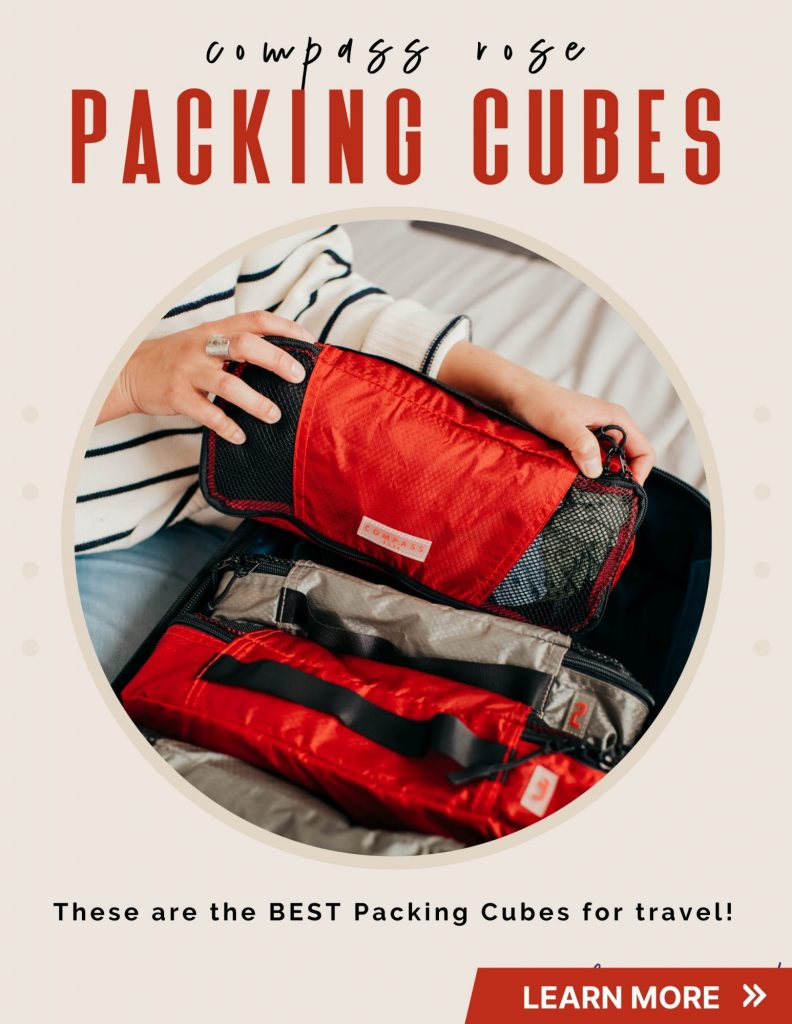
Best safari clothing: brands, clothes & tips for African safaris

You’re off on safari! You’ve done all the research , purchased the guide books , and the tickets are hot in your hand.
But most importantly, you’re getting ready to pack your ultra-light bag with everything you’ll need for your trip of a lifetime.
You’ve read all the advice you can handle (perhaps even this post on how to pack for safaris for your African bush adventure).
But when it comes down to the line, you still have no idea whether your favorite sweater is going to be a help or a hindrance, if you should pack jeans, how many pairs of socks are enough, and what on earth to expect once you are out in the wild.
What to wear on safari is something of a conundrum , the answer to which is entirely dependent on whether you are a complete slave to fashion and constantly worry about your appearance.
Or whether you don’t care if your trousers absolutely match your shirt and if your shoes co-ordinate properly with your camera bag.
So, in a bid to help sort the wheat from the chaff when it comes to safari style, this guide aims to highlight the best safari clothing brands and tips for your next trip to Africa .
African Safari Clothes: 7 Useful Tips
The African savanna has seen virtually every take on both the best and worst dressed safari goers , including some of the most practical and impractical safari gear around.
This includes everything from haute couture animal prints hot off the Milan catwalk, to Prada stilettos getting stuck in between the slats of wooden decks, and $300 silk scarves ripped to shreds by thorn bushes.
There are also tales of wild baboons getting hold of Victoria’s Secret lingerie and leaving it draped for all to see high in the branches of an acacia tree.
There are plenty of stories about complete wardrobe disasters—but to ensure you’re not one of them, here is a list of useful tips on how to dress for safaris .
1. Leave the luxury safari clothing at home
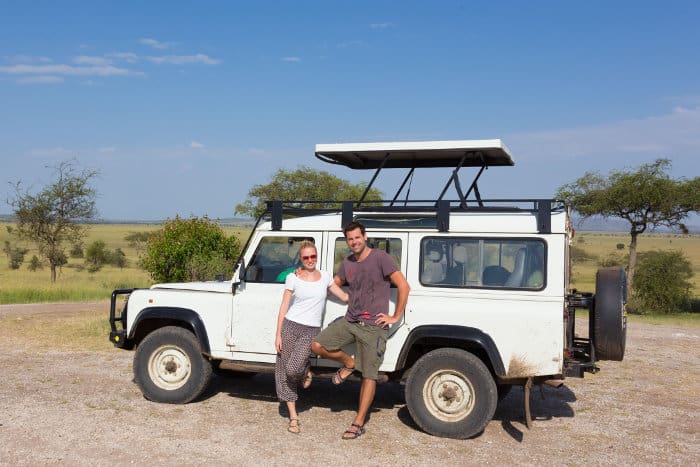
Lesson 1 in safari style is to NEVER take your best clothes into the bush .
If you find a pair of shorts, trousers, or a top you love and know that it would break your heart to have it ruined on safari, it’s probably best to leave it at home .
Instead, look for clothing that is specifically suited for the wild . And if the item comes in different colors, buy the range!
This way, over the years, you’ll acquire a variety of clothes which come everywhere with you. Look out for clothes that you can team together to create practical yet stylish outfits.
2. Keep your clothes for safari simple
Lesson 2 is learning how many of each item you will need . As a rule of thumb, always go with four of the basics.
Four pairs of shorts , four pairs of cut-off pants , four string vests , four t-shirts , four pairs of long pants , four button-through shirts (two of which are long-sleeved), four sets of underwear , four pairs of socks … you get the drift, I am sure!
When traveling in winter or during the colder months of the year, add to this scenario two lightweight long-sleeve t-shirts and two knitted sweaters , plus two fleeces or warm jackets , thermal long johns , gloves , a scarf , and a beanie .
When considering your safari apparel, ALWAYS pack a swimsuit and a couple of sarongs/kikoys . Even in the winter, it’s usually warm enough to suntan during the day and sometimes even swim.
3. Your safari wear should include comfortable shoes
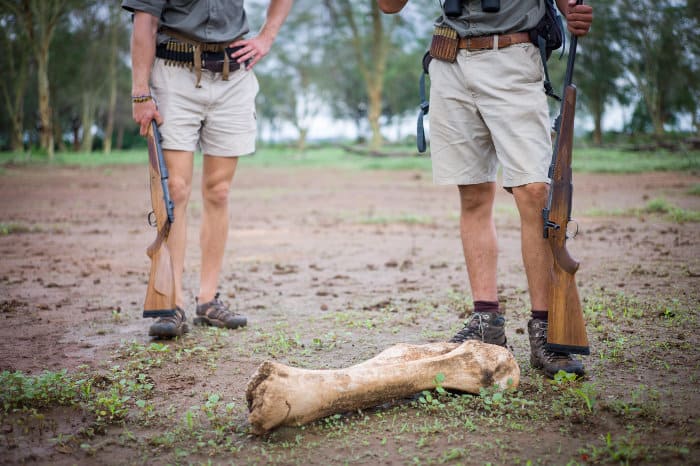
Lesson 3 concerns footwear . In the heat of the summer, it is best to pack at least two pairs of “bush slops” – flip flops (thongs) which are heavy-duty, waterproof, and good enough to handle walking in the light bush for game drives.
You may also need two or three pairs of fashionable flip-flops or sandals for around camp and evening meals, and a pair of good walking shoes ( Merrells ) for walking safaris.
In the winter, replace the walking shoes with walking boots and add a pair of lightweight faux-fur lined “trendy” flat boots for evening wear.
4. Safari fashion: accessories
Accessorize – that’s the key to lesson 4 – it’s the difference between a good safari wardrobe and a bad one. Two or three lightweight colored scarves and/or wraps are a must in any safari bag .
Usually, they have beadwork or applique of some description on them. These are useful for dressing up even the most conservative safari outfit—great if you’re looking to add a dash of glamor to your evening meals. Team them up with a couple of great “ethnic” bead necklaces and earrings .
Another essential item to include with your safari attire is a hat —and these can most certainly be fun. Pack in a couple of lightweight, floppy straw sun-hats, as these are great for game drives or tiger fishing.
Another good option is the usual peak baseball-style caps.
5. What to wear on safari – quality
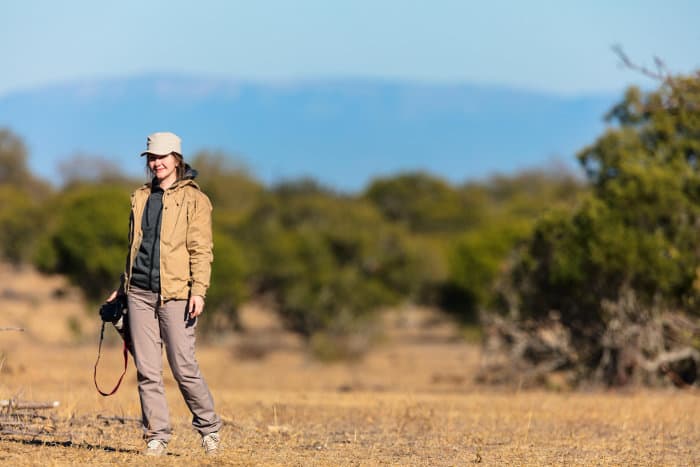
Lesson 5 is all about quality . Everything you take into the bush with you needs to stand the test of time.
This includes the elements of the African wild, the rigors of hand-washing, and bumping and grinding in the back of a safari vehicle halfway across Africa.
So it’s important to check your clothes before you pack to make sure they can be hand-washed, aren’t going to fall apart the first time you wear them, and are not likely to fade too drastically when hung in the sun to dry.
The material of your clothing is also important. When out in the wild, it is best to stick to strong natural materials like hemp , linen , leather , and wool .
Nylon and polyester also tend to provide adequate protection against the elements.
6. Best safari clothing brands
Wondering where to buy safari clothes? Most of the high-street fashion chains carry good quality fashionable safari clothes which will stand up to the average safari conditions.
As such, you may be able to avoid the need to go to specialist outfitters and camping/outdoor stores where things tend to cost a lot more.
And, of course, the big brands like Jeep (a favorite with safari goers because their clothes are practical, hard-wearing, and pretty at the same time) and Cat always have some great clothes for safaris—including some of the best safari shirts.
In addition to these, here are several more reliable brands to consider when buying safari clothes:
- Columbia — this is a good option for those seeking affordable safari clothing that is still good quality.
- First Ascent — if you’re buying safari clothes in South Africa, keep an eye out for this brand as it offers some excellent quality clothing.
- Patagonia — while the brand is more expensive, they provide some of the highest quality outdoor clothing and gear on the market.
- REI — if you’re shopping online, REI is often the go-to for outdoor gear. Their house brand is affordable and offers many items that will serve you well on your safari.
- Ruggedwear — proudly South African, it is an official partner of the Field Guides Association of Southern Africa (FGASA).
- Sapmok — footwear for every adventure. Comfy. Durable. And stylish.
7. What color clothing for African safaris

Finally, lesson 7 concerns white . Do you take white clothes into the bush with you? Hell yes.
As long as you don’t expect them to remain white for long and can accept the fact that no matter where you wear them, they’re bound to get a little dirty. It’s more or less a bush essential in my book because it reflects sunlight , keeps you cool and goes with everything .
Everyone says, “don’t wear white on a safari vehicle,” – but this is far from the truth. However, white isn’t the only color that’s good for safaris.
When dressing for safaris, the basic color range is simple: khaki , beige , white, and brown (or variations thereof).
Avoid black and blue during the day because they attract tsetse flies .
But do occasionally take these colors for evening wear when the tsetses have gone to bed.
What to Wear on an African Safari: Checklist
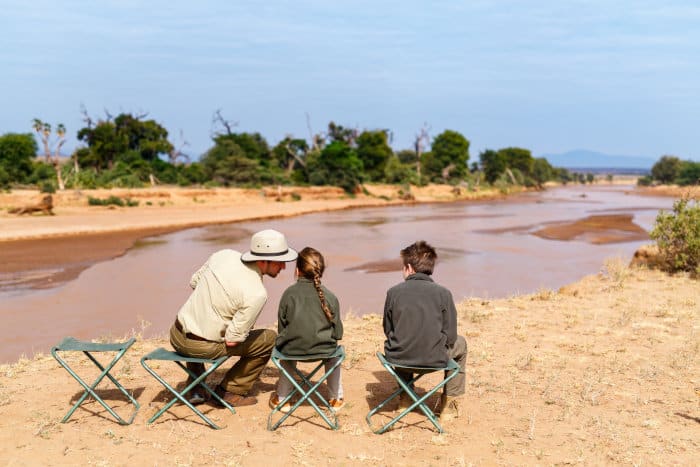
Now that you’re all clued up with what to consider when deciding what clothes to wear on a safari, it’s time to pack.
Here’s a checklist to ensure you don’t miss anything.
Africa safari clothing list
Below are some of the most essential pieces of clothing to bring along on a safari:
- 4 safari shirts
- 4 casual t-shirts or vests
- 4 safari pants or shorts
- 4 pairs of blister-proof socks for safari walks
- 3 pairs of pajamas
- 2 warm fleece tops or jackets (good for a summer or winter safari outfit)
- 2 pairs of flip-flops or sandals (one for the wild and one for at the lodge)
- 2 safari dresses (for at the lodge)
- 2 swimming costumes
- 1 waterproof jacket
- 1 kikoy or sarong
- 1 wide-brim hat or baseball cap
- 1 pair of safari shoes or boots
Safari gear and accessories list
In addition to clothing, you should include the following items when packing for a safari:
- 4 pairs of anti-chafing tights (good for walking safaris)
- 2 pairs of garden gloves (useful for gorilla trekking safaris)
- 2 pairs of ankle gaiters
- 1 pair of sunglasses
- 1 bottle of sunscreen
- 1 safari belt
Start Packing Your African Safari Clothing
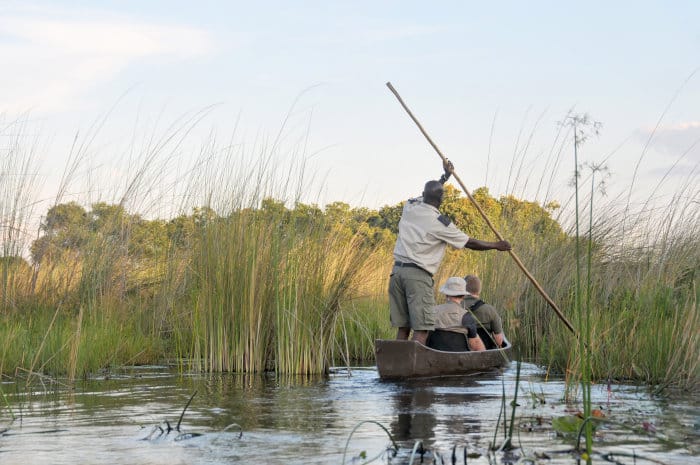
There’s nothing quite like getting down and dirty on an African safari. Whether you’re going on a game drive or a walking safari, you’re sure to come in contact with the various elements of the wild—and not to mention the wildlife, too.
For this reason, having the correct clothing is important . This will protect you during excursions and allow you to blend in better with the natural environment.
So next time you’re contemplating what to wear on African safaris, review the list above . These useful tips will guarantee you have a pleasant experience, both at the lodge and in the bush.
So what are you waiting for? Check out these incredible African safari deals and start packing!
About The Author
Sharon van Wyk
Related posts.

African safari packing list – What to bring on a trip to Africa
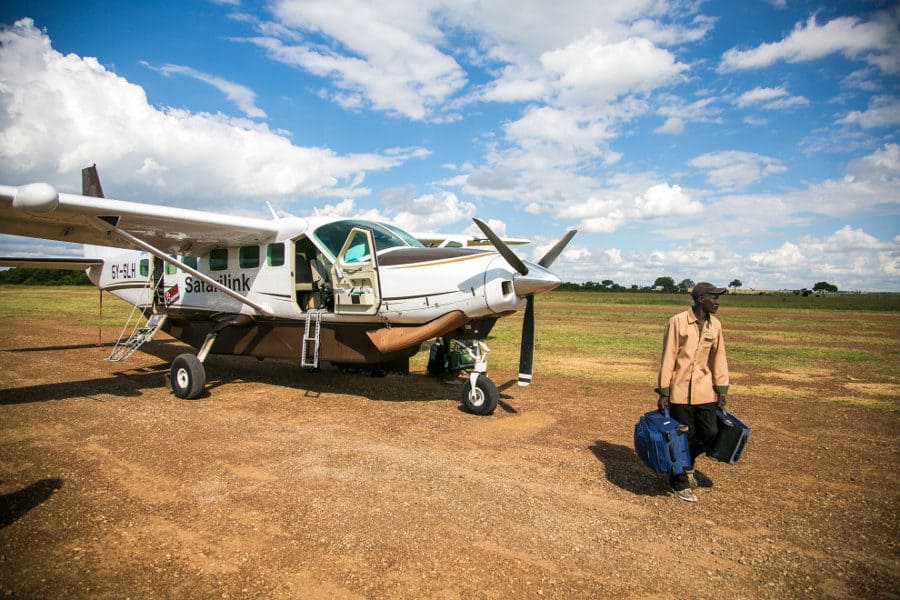
Best safari luggage – Duffel bags & backpacks for African travels
Leave a comment cancel reply.
Your email address will not be published. Required fields are marked *
- Best Safari Clothes for Women: Outfit Examples + Where to Buy
by Nichole | Last updated Jul 25, 2024 | Safari Packing List , South Africa
Images of khaki pants and an Australian outback hat immediately come to mind when I think of the safari outfit. As a first-time safari-goer, I had no idea what to wear. Now that I have done two safari experiences, one at Lion Sands in South Africa and one at Chobe National Park in Botswana , I can now share my travel pearls of what are the best safari clothes for women.
* Some of the links in this post contain affiliate links. If you make a purchase through these links, we may receive a small commission at no extra cost to you. All recommendations are from first-hand experience that I feel will deliver value to you! Thank you for your continued support.
FOLLOW & SHARE WITH A FRIEND!
Best Safari Shirts for Women
#1- orvis open air caster shirt, #2- orvis chambray shirt, #3- kuhl arriva shirt, best safari pants for women , #1- prana halle pant, #2- anatomie kate cargo pants, #3- l.l. bean vista camp pants, #4- kuhl freeflex roll-up pants.
- Women's Safari Outfit Examples
Best Safari Shorts for Women
#1- prana double peak short, #2- prana elle short, best safari hats for women, #1- orvis packable felt hat, #2- j.crew packable straw hat, best safari jackets for women, #1- anatomie kenya safari jacket, #2- rei 650 down jacket, best safari shoes for women, #1- saucony peregrine trail runners, #2- rothy's slip on sneaker, #3- blundstone chelsea boots (walking safari), bathing suit, fleece or sweatshirt, safari dress alternative.
- Best Women's Safari Accessories
MULTI-COLORED SCARF
Polarized sunglasses, 9 safari clothing tips, #1- where to buy safari clothing, #2- pick lightweight clothing, #3- pick breathable fabrics, #4- pick upf 40+ rated clothing, #5- avoid these colors, #6- dress in layers, #7- khaki not required, #8- pack light, #9- be aware of luggage weight limits, final thoughts, related content.
OPTION A : Ahh, too much khaki! Please tell me there are other options.
OPTION B : Gorgeous, but are you seriously going to wear this sitting in a jeep in the heat with dust and bugs flying around you?
When I first started my search for the ideal safari clothes for women, I thought there has to be more choices than options A and B as seen from the photos above.
I despise khaki (and I’m fair-skinned which does not mix well with skin-toned colors), and I crave feminine, well-fitted, PRACTICAL clothes (that do not look like you are only wearing them for a dramatic Instagram shot).
Is there an option C?
But it took me a lot of purchases and returns later to find the best safari clothes for women. I hope my trial-and-error clothing discoveries can help you as you pack for one of the most epic experiences of your life … the African safari!
By the way, if you are still trying to figure out what to pack, don’t miss my ultimate safari packing list below (#23 will surprise you!).
There are three features you want to look for when selecting a safari shirt:
→ Lightweight
→ Breathable fabrics
→ UPF 40+ rating
All these features are discussed more in detail at the end of this blog post. Click here if you want to read more about these features and tips first.
You do not have to stick to beige and browns for your safari drive that look like the color of your skin. Instead, I opted for colors such as light blue, grey, olive green, white, rust, and soft pink.
Here are my top recommendations on the best safari shirts for women that are stylish and feminine but also practical.
Orvis Open Air Caster Shirt in White
WHY I LOVE THE ORVIS OPEN AIR CASTER SHIRT :
- Lightweight
- UPF 40 rated
- Built-in Odor Control
- Roll-tab sleeves
- White is a versatile color that will pair with any pants
Orvis Chambray Shirt in Alpine Lake
WHY I LOVE THE ORVIS CHAMBRAY SHIRT :
- Dries quickly
- Super breathable
- Wrinkle resistant
Kuhl Arriva Shirt in Olive
WHY I LOVE THE KUHL ARRIVA SHIRT :
- Ultra lightweight
Quick drying
- UPF 50 rated
Moisture wicking
I admit it.
I overpack and like to plan for all possible outfits I may need. If you are taking a small plane to your safari destination, you will likely have a weight limit for your luggage.
That means you have to make smart choices of what clothing to bring.
Pants take up a fair amount of space in your luggage, so it’s very important to pick pants that are LIGHTWEIGHT and versatile.
Let’s go through some of my favorite picks to make your trip enjoyable and comfortable.
Prana Halle Pant in Sedona Fields
WHY I LOVE THE PRANA HALLE PANT :
- Stretch performance with durable water-repellant (DWR) finish
UPF 50+ rated
- Roll-up leg feature
- Comes in a lot of great colors
Kate Skinny Cargo Pants in Army Green
WHY I LOVE THE ANATOMIE KATE CARGO PANTS :
Stretchy material
- Quick-drying
Anatomie pants vs. Jeans
L.L. Bean Vista Camp Pants in Granite
WHY READERS LOVE L.L. BEAN VISTA CAMP PANTS :
- Durable (made from rugged nylon)
* I haven’t tried these pants yet, but I had to include them because readers keep raving about how great these pants are for safari drives. I can’t wait to try them out on our next trip!
Kuhl Freeflex Roll-up Pants in E ucalyptus
WHY I LOVE THE KUHL FREEFLEX PANTS :
Roll-up pants
Water-resistant FREEFLEX
Women’s Safari Outfit Examples
My husband hates taking personal photos, so you’ll only see a few personal safari photos of us in this blog post.
Since I did not have photos of every single safari outfit I wore while in South Africa and Botswana, I took a few photos back home to demonstrate what I wore on our 4-day trip.
Safari Outfit Day 1
Safari Outfit Day 2
Safari Outfit Day 3
Safari Outfit Day 4
I strongly advise wearing pants on your safari drive because of the dust, sun, and bugs.
However, back at the safari lodge, you may want to slip into something clean and comfortable to walk around in.
Here are my recommended versatile performance shorts:
Prana Double Peak Short in Mud
WHY I LOVE THE PRANA DOUBLE PEAK SHORT :
Prana Elle Short in Rust
WHY I LOVE THE PRANA ELLE SHORT :
Comes in fun colors
4-way stretch
Lots of pockets
Wearing a safari hat and taking photos of elephants in Chobe National Park in Botswana
Bring a hat!
The African sun is strong and hot. If you want to avoid skin cancer and wrinkles, be sun smart. This saved my skin!
One other feature you may want to consider in a safari hat is a chin strap.
It was not very windy when we were in Sabi Sands in South Africa. I can imagine though if you are traveling by jeep on an open plain in Tanzania, there may be more wind that could steal your hat away.
Orvis Women’s Saddle Packable Felt Hat
WHY I LOVE THE ORVIS PACKABLE FELT HAT :
- Super packable!
- Water-repellant and stain-resistant
- Adjustable interior band
J.Crew Packable Straw Hat
WHY I LOVE THE J.CREW PACKABLE STRAW HAT :
- Super squishy and packable!
Depending on the time of year, you will need a light to medium jacket.
Remember, those mornings can be chilly!
Layer, layer, layer!
Anatomie Kenya Safari Jacket
WHY I LOVE THE ANATOMIE KENYA SAFARI JACKET :
Super stylish and slim fit
Versatile- wear it on safari by day and city by night
Performance stretch
Wrinkle AND wind-resistant
Machine washable!
REI 650 Down Jacket in Saragasso Sea
WHY I LOVE THE REI 650 DOWN JACKET :
- Water resistant
- Great for layering up on a safari and for city exploring
Wearing my light down jacket on a safari drive
A lot of the blogs will suggest hiking boots. I strongly disagree IF you are only doing game drives.
If you are doing a walking safari, then please bring those heavier mid-rise hiking boots! You may be walking in tall grass, navigating around rocks, or accidentally stepping in lion poop. Sturdy boots are essential for protection and keeping those dainty ankles away from biting insects.
Otherwise, lightweight trail runners work perfectly. They provide a little grip just in case you jump out for a quick walk or to enjoy a sundowner.
Plus, remember those little planes taking you to your safari destination have weight limits. Pack light!
Saucony Peregrine Trail Runners
WHY I LOVE THE SAUCONY PEREGRINE TRAIL RUNNERS :
- Lugs for good traction
- Variety of fun colors to choose from
Rothy’s Slip On Sneakers in Sand
WHY I LOVE THE ROTHY’S SLIP ON SNEAKER :
- Doubles as a great “transit” shoe for travel days on/off the airplane
- Do not wear on a walking safari but perfectly fine if sitting in a jeep for 3 hours
- Super comfotable
- Machine washable
Blundstone Chelsea Boots in Cocoa Brown
WHY I LOVE THE BLUNDSTONE CHELSEA BOOTS :
- Cushioned midsoles
- Leather uppers are weather-resistant
- Vibram Megagrip outsoles
- Immediately comfortable
- Great for walking safaris
Swimming in Devil’s Pool at Victoria Falls on the Zambia side
Athleta super soft sweatshirt
Remember the mornings and evenings in Africa can get chilly. Layers are so important!
My favorite is my Athleta sweatshirt due to its super soft material.
Anatomie Louisa Skinny Jean Pant in Black
I had brought a few dresses with me because prior to the safari portion of our trip, we had the opportunity to dine at some of the best restaurants in Cape Town including The Test Kitchen!
We had also visited numerous wineries in South Africa wine country , so I did end up bringing a few “dressier” items.
I love wearing dresses, but I found a safari lodge is really not the place people wear them. Everyone was super casual.
Of course, wear what you want, but I would have felt a little out of place wearing a dress.
If you do wear one, a long maxi dress probably makes the most sense to keep your legs protected from mosquitoes.
So instead I opted to wear my Anatomie Luisa Skinny Jean Pant in black with a flowy top and sandals.
Then I just alternated tops since black goes with everything. Remember, there are no tsetse flies in South Africa, but if you are in another country that has them, no black or dark blue!
Sorry, no photo from the safari trip, so I took a photo of the Anatomie pants I wore for dinners at the safari lodge when I got home.
Best Women’s Safari Accessories
Wearing a multi-colored scarf at Chalkley Treehouse at Lion Sands River Lodge
Morning safaris can be chilly depending on the time of the year you go. Layer up.
One way to do that is to bring a scarf. Not only does it provide warmth, but it also fends off the sun and dust.
I opted for a multi-colored scarf I could wear with multiple outfits. Orvis usually has some great colorful options.
Wearing my Ray Ban sunglasses in Chobe National Park in Botswana
They reduce eye strain and cut down the glare and help as you are staring into the distant bushes trying to make out if you just saw a leopard.
I did not care for all the khaki boxy clothing options I was discovering when I Googled where to buy safari clothing.
I found the best clothing for a safari is from travel, camping, hiking, and fishing stores. They sell clothing that is performance-performing, lightweight, and durable. My favorite stores include the following:
→ Anatomie
A lot of the safari lodges will offer laundry service. However, if you need to wash an article of clothing by hand, pick something lightweight that dries quickly.
By far, my Anatomie pants are the quickest-drying clothing I have ever encountered.
There have been a few occasions where I have had to wash them in the sink with a little soap, and they literally air-dry within a few hours.
Pretty impressive!
According to Anatomie’s website, they can be dried in under 8 minutes using a hairdryer (but I have not tried that yet).
Wearing breathable fabrics is so important especially when you are sitting in a jeep underneath the scorching African sun!
Cotton, rayon, and linen are very breathable but not moisture-wicking.
Nylon and polyester wick moisture, but the breathability depends on the weave.
Merino wool is not just for winter but is also used for summer clothing because it breathes well and wicks moisture. For me, it’s a little itchy even with the fine weaves, but I have super sensitive skin.
For shirts, specifically look for a vented back with mesh lining, which allows for breathability. Also, another great feature to look for is roll-up sleeve tabs.
To stay cool, some pants are convertible where you can zip off the pant legs or roll them up and snap them in place.
Most people know what an SPF number means for sunscreen, but they may not be familiar with UPF ratings for fabrics.
The Ultraviolet Protection Factor (UPF) number shows how much UVA + UVB radiation a fabric permits to penetrate your skin.
Look for a UPF 50, which blocks 98% of the UV radiation. Also, look for shirts where you can pop the collar up. Your neck will thank you.
For some reason, Americans always think (myself included!) to wear less when it is hot; whereas cultures in Asia and the Middle East tend to cover up in the heat.
I know it seems counterintuitive to wear long-sleeved shirts and pants, but you will be glad you did when you are baking in the sun and fighting off mosquitos and tsetse flies.
Tsetse flies love black and dark blue, so do not wear those colors while on safari. Otherwise, you can get a nasty bite and possibly African sleeping sickness if the fly has been infected with a parasite.
I asked my safari guides about the tsetse fly while we were in South Africa, and they had no idea what I was talking about. I found out later that is because this fly is not present in South Africa!
If you are in Tanzania or any other country, do not wear dark blue or black clothing/shoes and keep those ankles covered.
South Africa though has NO tsetse flies, so it is okay to wear black and dark blue there. However, dark colors absorb heat, so you may feel hotter if you choose to wear them.
Never wear camouflage since that type of clothing is identified with the military.
Also, a lot of guides will say not to wear white because it will get dirty quickly.
This may be true in other countries when driving out on wide-open plains, but honestly, I wore a white shirt twice while in Sabi Sands in South Africa and had no problems with getting really dirty.
I would avoid white though on a walking safari because it does make you stand out.
When we went to Sabi Sands at the end of September, the weather was VERY cold for the morning safari (I was layered up) and hot for the afternoon safari (I was stripping down).
If you are like me whose body does not regulate temperature very well, you will be happy you have layers to account for all temperature situations.
You really do NOT have to wear khaki for your safari outfit UNLESS you are doing a walking safari, and then by all means wear those browns/tans to blend in.
Most lodges offer laundry services. Take advantage, so then you can pack less. I’ll be honest, I am horrible about “packing light.”
That is one reason why I love Anatomie clothing! I can bring more because it weighs hardly anything.
Remember you need room for all of that lovely South African wine you are going to bring back! We toured multiple wineries in the Cape Winelands before we headed to Sabi Sand and stored them in wine sleeves in our luggage.
Wine or clothes? Wine always wins.
There you have it.
My top safari clothes for women.
Most articles I have read just provide another generic list. I hope my more detailed explanations of what I personally wore will make your safari experience more comfortable and memorable.
Unique Travel Gifts for Couples: 22 Seriously Cool Gift Ideas
by Nichole | Last updated Jul 24, 2024
Why trust our expertise in suggesting travel gifts for...
Our Self-Guided Wine Tour in Stellenbosch & Franschhoek
by Nichole | Last updated Jul 25, 2024
South Africa is known for some exceptional wines,...
How to Choose an African Safari Lodge: 11 Things to Consider
How to choose an African safari lodge that’s right for you...
7 Top Safari Destinations in Africa: Pros & Cons
Your first trip on an African safari will seep into your...
REACH OUT, FOLLOW, OR SHARE THIS POST WITH A FRIEND!
Any other safari clothes for women that I missed or that you would recommend?
Let me know in the comments below!
2 weeks in zambia. I brought 2 prs of these https://www.llbean.com/llb/shop/86735?page=vista-camp-pants and lived in them Every Morning!!!! I had to have the neutral color so went with toasted almond. I had to wash a pair once because I forgot to put them in the laundry. and they were dry within a couple of hours. Crazy comfortable, good pockets for extra camera batteries, lens cover, etc. Vista Camp Pants. Love them.
Thanks so much for sharing! I’m excited to try those out. They look super comfortable!!!
Submit a Comment Cancel reply
Your email address will not be published. Required fields are marked *
Submit Comment
What to Wear on Safari: 20+ Things You Absolutely Must Pack
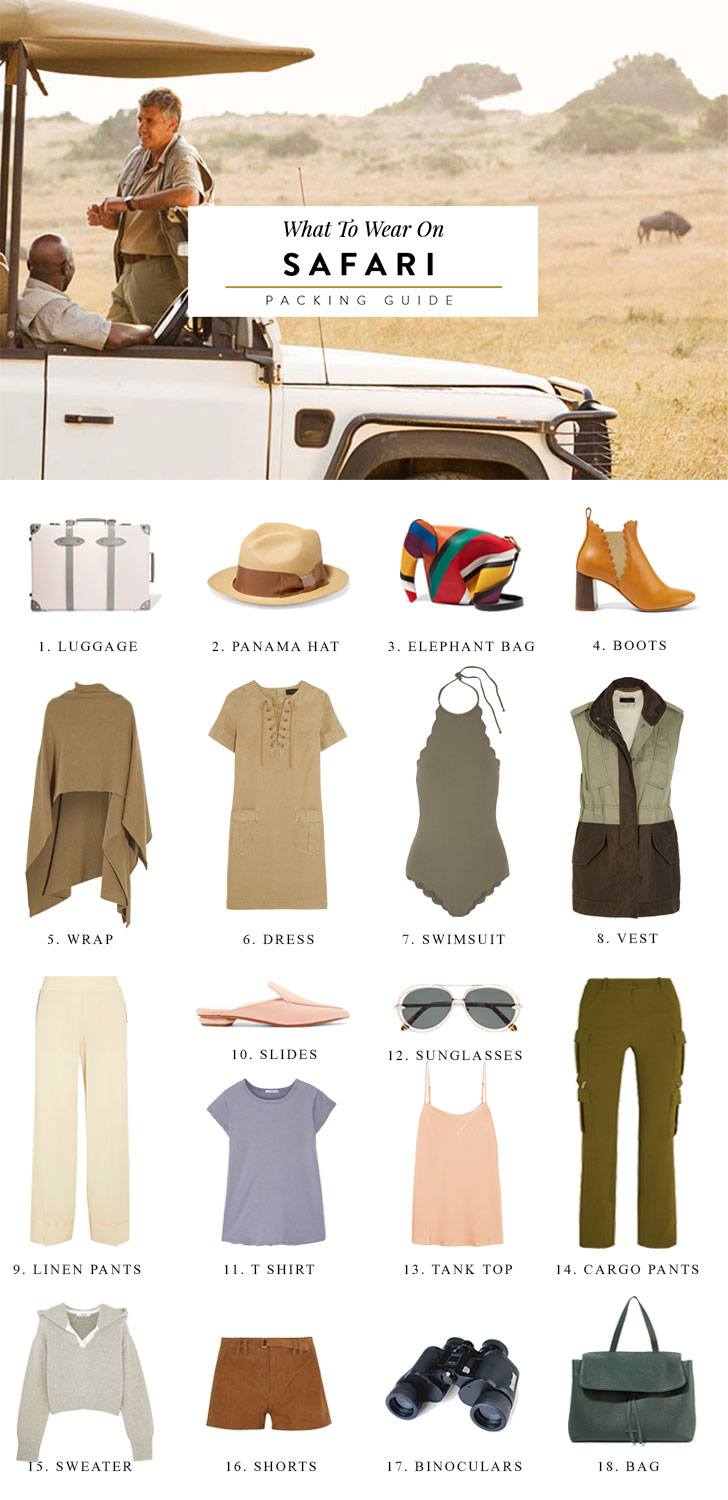
Safari Packing List
I visited Kruger National Park in South Africa and was so excited to see the big five animals. It was a once in a lifetime trip and so unique!
Because of the dusty roads and early morning / late evening game drives, there are some special things to keep in mind when packing. Today I’m covering all the essentials to bring on an African safari.
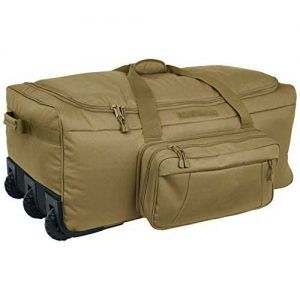
1. Soft Duffel Bag
First things first, the bag! It’s important not to over pack when going on safari since you’ll likely be flying from a major city to the camp’s local airport. Africa uses very small jet planes for remote areas, where there are strict weight limits regarding luggage.
Check your itinerary and flight confirmation for the exact weight limit – it can be as restrictive as 20 – 45 lbs of luggage per person so if you are a photographer carrying heavy gear, this is something to keep in mind.
The best thing to bring is a soft canvas or leather duffel bag with a carry on bag. If you have bigger hard luggage, you can store them in locked airport baggage areas. The safari camps typically offer laundry service if you have need.
Read more : The Best Travel Duffel Bags
Code Alpha Travel Duffel Bag with Wheels
Available on Amazon here for under $125
See all colors and read more reviews here
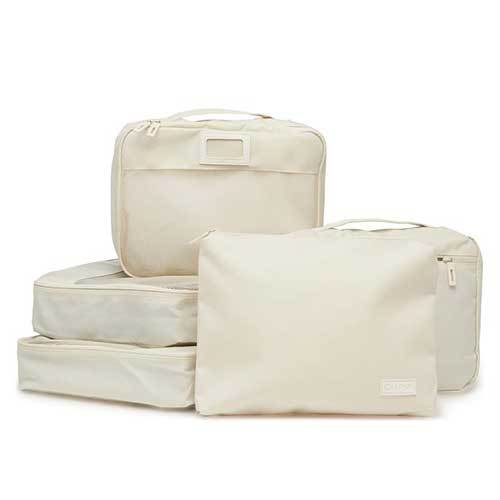
2. Packing Cubes
To keep everything organized, I swear by packing cubes ! You can roll or fold your clothes into separate cubes, organized by outfit, clothing type or color and keep everything fresh and contained. I typically keep an extra empty packing cube for all my worn clothes throughout the trip.
Amazon has their own inexpensive 4 piece packing cube set and I love this set from CalPak , which is perfectly sized for their CalPak luggage and machine washable for easy cleaning
Read more: Do You Need Packing Cubes?
Packing Cubes
Available on Amazon here for under $16
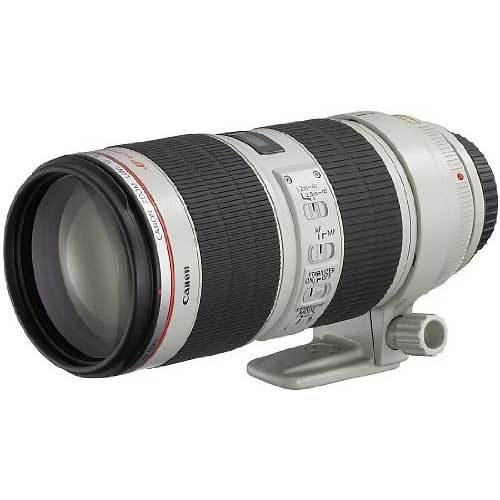
3. DSLR with Zoom Lens
I highly recommend a DSLR to capture the safari experience! I brought a Canon 5D Mark III with three lenses: my all around 24-70mm , a 70-200mm zoom lens and a 10-22mm wide angle.
For each game drive I kept the spare two lenses in my backpack at my feet. It’s also helpful to wear a jacket or vest with pockets so you can keep all your extra memory cards, lenses and lens caps quickly at hand. The animals won’t wait for you!
You can see my complete camera gear list here .
Safari Photography
Canon 5D Mark III with 24-70mm , 70-200mm zoom lens & extension tubes
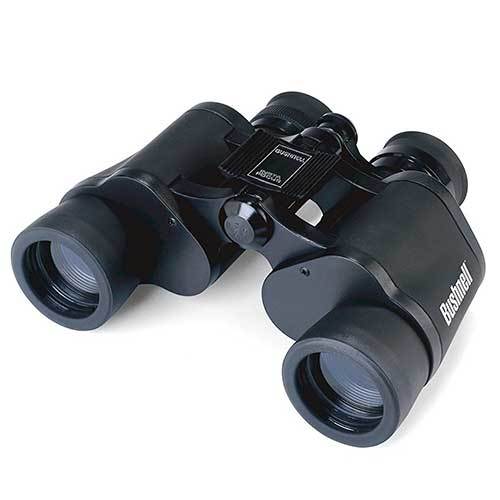
4. Binoculars
To see birds and smaller creatures you’ll get a much better view with binoculars – we didn’t but a nice man on the trip let us use his and he had this pair . Some top luxury safari companies will provide these but most don’t so bring your own.
Large animals like lions, elephants and giraffe will come within an outstretched hand’s length from the jeeps but animals like rhinos, leopards, hippos and warthogs maintain their distance.
Available on Amazon here for under $35
Read more reviews here
What to Wear on Safari
Safari attire should be breathable, neutral and adjustable for both sunny and chilly temperatures. I recommend packing a capsule wardrobe of neutrals, greens and browns and mixing and matching since there are strict luggage weight maximums. Here are some things about African safaris that you should keep in mind when packing:
Shifting Temperatures: You’d think that the African bush or savannah would be hot all the time but I found it to more closely resemble desert temperatures, where the early mornings and evenings can be chilly and cold while the afternoons are blazingly hot.
Safari game drives are typically timed to the natural lifestyle of the animals – there will be one early morning game drive to see the animals as active as possible before the lazy afternoon sun hits and another around sundown to see evening activity. Some safari reserves also linger on after dark to see night animals like hyenas. Because of this, you’ll want to dress in layers.
I recommend packing a sweatshirt or light jacket for the morning drives and wearing tanks or tee shirts underneath. Luxury safari camps will include extra blankets on the jeep, which I used to cover my legs. For the evening drive, I brought along heavier layers as the safari I was on would extend for an additional hour at night and temperatures got cold.
Colors: Opt for neutrals, khaki and green colored clothing to ‘blend in’ with the bush. The key to spotting animals in their natural environment is to mimic the African bush colors, which tend to be drab.
Avoid red which predators identify as “wounded animal” and avoid black or dark blue , as you’ll find yourself an attractive target for African Tsetse flies, which bite! Apparently lions in East Africa are known to shy away from people wearing red as they instinctively identify red as a Masai warrior.
White can easily get dusty and dirty in the bush and are the most noticeable to animals, so best to avoid if possible.
Casual: We stayed a gorgeous luxury resort but didn’t feel the need for formal attire or fancy dress at dinner times. I’d recommend linen pants or a dressy blouse for evening meals and a wrap or extra large scarf for the cold at night. Leave the heels at home.
Clothes to Pack for Safari
5. fleece pullover / rain jacket.
A cozy pullover will be good for the morning game drive.
6. Long Sleeved Tops & Comfortable Long Pants
Layers for chilly mornings and evenings.
7. Shorts & T Shirts
Lightweight summer clothes for the hot afternoons!
8. Swimsuit
Luxury safari camps will have a swimming pool so pack a swimsuit. At the camp we stayed at, local elephants and giraffes would use the pool as their watering hole, which was so fun to see. I wonder if they could taste the chlorine?
9. Comfortable Sneakers & Sandals
Within the jeep I wore both sneakers, boots and flip flops and it honestly didn’t matter at all since you are required to stay in the vehicle for the drive. There will typically be short breaks – we stopped for hot chocolate and drinks – where you can get out to stretch your legs.
The bush can be slightly dusty so they recommend hiking boots or covered shoes but I felt fine in flip flops as well. One afternoon we also opted to do a bush walk. I would definitely pack a good pair of sneakers for that… just in case you need to run suddenly. Only kidding.
10. Sunglasses, Hat & Light Scarf
If you bring a hat or sunglasses, make sure it has a string to tuck around your neck. The jeeps drive decently fast and my hat flew off at one point, oops.
11. Sunscreen
A must have wherever you go, I like to bring both a facial sunscreen and all over body sunscreen. For the face, this Japanese brand is my hands down favorite – it’s non greasy, affordable and non-tacky without any scent. For the body, I love this broad spectrum sunscreen which smells like coconuts and leaves your legs nice and glowy.
I also recommend a great lip balm, since the bush is dusty and dry. My favorite day balm is Lanolips , and my heavy duty must have is by French brand Aquaphor .
12. Bug Spray
This depends on when you’re going. I went on safari in South Africa in late August and early September during their winter time, so there was no rainfall and no mosquitoes or bugs. However, if you’re going on safari during the summer season (perhaps to see the new baby animals or during the migration) you’ll need bug spray . This is a great all natural brand.
Certain sections of South Africa, including Kruger National Park, are in the malaria zone and it’s extremely important to protect yourself. There are also times of the year when the bugs are so bad they give you googles because the air will be so thick with flying bugs you’ll inadvertently eat or get hit by one.
Other Safari Travel Necessities
Toiletry Bottles | If I know I’m going somewhere tropical, I prefer to pack my own hair products since my hair tends to dry out from the sun and chlorine. I currently like these for shampoo and conditioner .
Portable Charger | I currently use an iPhone 6S and this Anker portable charger to keep it fully charged at all times. This charger is small and sleek with enough life to fully charge an iPhone 2x. Also I really love Anker’s products since they have great customer service. I once bought a product that ended up dying and they quickly sent me a replacement free of charge, so I highly recommend them!
Electric Converter | I have a global converter but for some reason it didn’t work in South Africa and I ended up buying a South African specific converter. I definitely recommend you buy this before your trip as I paid $24 for the little plug! Also pick up a travel sized power strip so you can charge multiple devices in one go.
Medications | South Africa required a ton of shots and I went to see a travel doctor specifically for a complete list. One thing I hadn’t expected was malaria pills – there are a couple different versions on the market.
You should talk to your doctor for the latest, accurate information but I remember that I took the kind which required consuming anti-malaria pills both before, during and after the trip (I think it was malarone). Consult with your doctor about potential side effects!
The Best Camera for an African Safari
I highly recommend a DSLR and a zoom lens. Safaris in Africa aren’t cookie cutter so the lenses you’ll want to bring will vary depending on the place.
- For example, gorilla treks are popular in Rwanda and involve heavy hiking where you carry all your own gear to get close enough to the apes. In that case, you’ll want light weight lenses with minimal zoom.
- If you’re headed on safari during the great migration , some of the best shots to get are panoramic views that capture the sheer amount of animals on the move – so bring a wide angle like a 35mm.
- Jeep vehicles differ by country as well so in some cases open vehicles mean clamps and bean bags won’t be of any use and you’ll need a monopod .
Below are my gear recommendations for a typical South African safari in Kruger National Park:
If you have two camera bodies, it’s helpful to load one lens on each to avoid swapping lenses during the game drive. The African bush is extremely dusty and changing lenses can potentially ruin your gear with dust.
The 70-200mm was my go-to lens and worked well for about 70% of the shots. Sometimes the animals would appear right next to the safari vehicle in which case the 24-70mm would have worked better but I knew that in the time to swap, it would likely have moved on. An iPhone can be handy for these instances!
Camera Accessories
Along with the camera, I brought my spare battery , battery charger and extra SD and CF cards . I now shoot with just SD cards since I realized you can insert them in your laptop to easily offload, but I keep all my cards in this wallet to keep them organized and easily reachable. When I kept my SD cards loose, I would lose them all the time – even if they were in a zippered pocket. The memory card case fits both SD and CF cards and was under $7 so it’s a no brainer purchase.
Other things you might want to bring include a monopod and extension tubes . A monopod is a tripod with just one leg and if you keep it between your legs you won’t disrupt other passengers while still stabilizing your shots. I didn’t bother bringing one since I was near the weight limit but this monopod is an affordable, solid choice .
If you are worried your lenses won’t pack enough zoom, bring along extension tubes. I bought this set of 3 by kenko which essentially sits between your camera body and the lens and helps to magnify the power of your zoom.
If you have a crop body camera, this will further magnify. It can be slightly trickier to focus so just check the back of your camera to make sure your shots are coming out well. What I did was re-evaluate all my photos after each game drive so I could adjust my gear and camera equipment accordingly. In total, I spent 5 days on safari with 3 days of 2 drives so a total of 6 game drives.
Where to Sit on a Safari Game Drive
Most experienced game drive leaders are either photographers themselves or familiar with photographers on their drives and they’ll do their best to position the vehicle to get the best shots, which is extremely helpful.
In South Africa, drive vehicles are predominantly open Landrovers with 10 passenger seats (1 next to the driver, then 3 rows which can seat 3 people each). Either of the two rows behind the driver are good for photography. I would avoid the last row which is above the jeep wheels, as it’s quite high off the ground and can be a little too high for the best shots.
Our game driver was excellent at slowly moving the jeep forward or backward so that each “row” could get the “perfect” shot.
What should you not bring on safari to South Africa?
Well, chances are your vehicle will be an open land rover so stabilizers like a bean bag or tripod clamp won’t have any ledge to sit on. Skip these. Unless you plan to shoot birds, a zoom over 400mm is not really necessary. If you do want to shoot birds, you’ll need something like a 600mm lens which is not only extraordinary expensive but quite heavy.
If this all sounds excessive to you.. consider that you’re already spending a small fortune to go on safari, so why not do your best to capture the glory? Going on safari and visiting Africa remains my all time favorite travel experience to date.
The Best Souvenirs from Africa and Safari
Africa has so many great things for sale that you’ll want to bring home. For the interior design lover, there are faux animal printed hides, pillows and decorative wooden carvings. Ostrich eggs (usually painted or carved) are popular as are sculptures of giraffes in various heights.
Local markets will sell carvings, figurines, gems and jewelry. There are lots of kitschy tourist market places but you can ask your guide for an authentic marketplace in a local village if you want true unique souvenirs. A friend of mine brought back a really unique, hand made tree with amethyst gemstone leaves.
South Africa is also well known for its wines so I brought home bottles of red and after going wine tasting in the Cape Town winelands . If you fly South Africa Airways they give out mini bottles on the plane, even in coach! Always a nice treat.
If you like tea, make sure to try some rooibus!
South Africa Vacation Planning Articles
The Best Thing to Do in Colorful Bo-Kaap : Learn to Cook Cape Malay Food
The Complete Cape Town Beach Guide
The Best View Over Cape Town: Head to Table Mountain
Staying in Downtown Cape Town at the Cullinan Hotel
South Africa’s Answer to Napa Valley: The Cape Town Winelands
Here’s How You Can Swim with Penguins in a Cape Town sea kelp forest, no less!
The World’s Most Scenic Road Trip : Cape Town, South Africa
The Most Adorable Way to Spend an Afternoon : Penguins at Boulder Beach
Don’t forget to explore Johannesburg after your safari . It’s a short flight from Kruger and chances are, you’ll fly into Johannesburg first anyway since that is the city of South Africa’s international airport. Love outdoor travel? Then make sure to check out this post for what to pack for Macchu Picchu!
You may also enjoy:
The most comfortable bras that feel invisible (2020), 8 swimsuit trends you should know for 2020, coffee, tea or me 6 travel mugs to …, the 12 best athleisure outfits to dominate your …, 12 comments.
- Pingback: What to Pack for Morocco: Outfit Ideas & Packing List » Sher She Goes
- Pingback: What to Pack for New York in Winter » Sher She Goes
- Pingback: What to Bring to Cuba: Packing List, What to Wear & Essential Tips » Sher She Goes
- Pingback: What to Wear in Cancun, Mexico: Packing List, Souvenirs & More » Sher She Goes
- Pingback: Here’s Your Ultimate Packing List for Europe » Sher She Goes
Heels on safari is a no-no…
Hey Estelle – ha, good point! Looking back I’m not quite sure why I put a booted heel in that collage but I will say most of my older outfit collages are meant as inspirational, high fashion ideas and below in the text I have more real world examples. Definitely don’t recommend high heels on a dusty safari! :)
- Pingback: Here’s Your Essential Business Trip Packing List » Sher She Goes
Wow thanks for your blog. I was wondering if i should bring my black down coat and black ankle boots during july to africa. They take up lugguage space but i m scared of cold. Could u pls advise?
It gets about 50 degrees in July, so up to you. I usually wear my bulkiest items on me instead of packing them!
- Pingback: What to Pack for Jamaica: Outfit Ideas & Packing List
Just wanted to say loved all the information given for safari trip as I’m being treated to one by my daughter for a 70th birthday gift very helpful. Thanks
Leave a Reply Cancel reply
What To Wear On Safari: My Detailed Safari Packing List With Photos
Written by BELLA FALK
You’ve all seen the brochure photos: a smiling family is sitting at a camping table in the middle of the African bush. Behind them, the sun is setting, and perhaps a giraffe is crossing the savanna landscape.
Contents (click to view)
What are they wearing? I’m sure you can picture it: lightweight designer safari gear, all matching, in indistinguishable shades of beige, taupe and camel. Maybe the dad is wearing khaki chinos and the mum has a floppy-brimmed hat (colour: putty) on her head. They all have sand-coloured lace-up boots on, and from head to toe all their clothes are pristine, clean, and crease-free.
If it’s your first time figuring out what to wear on safari, it might feel like this is the model you have to follow. Like, having booked the blindingly expensive trip of a lifetime, you now have to go out and splurge hundreds more on the ‘proper’ kit, otherwise people will laugh at you and you may even get into trouble for not doing it right.
Well I’m here to reassure you: that’s rubbish.
What should you wear on safari?
I’ve been on five safaris (to Kenya , Botswana , Tanzania , Uganda and South Africa) and I still don’t own any ‘official’ safari clothes. I’ve always worn stuff I already own and been just fine.
That said, there are some dos and don’ts about packing for a safari, some things it’s a good idea to make sure you bring with you, and some stuff you should definitely leave at home.
So welcome to my complete safari packing guide. I’m going to go through a few points and FAQs, and then make a handy list at the end. Scroll down if you just want to skip ahead to that.
What happens on a safari?
Days on safari follow a similar schedule. You wake early and head out shortly after sunrise for a morning activity – usually a game drive but sometimes a boat cruise, guided walk, or scenic flight.
You return to the camp mid-morning for brunch and have some hours to relax in the heat of the day before heading out again for another activity later in the afternoon. Your afternoon game drive or boat cruise normally ends with sunset drinks in a beautiful location, before you head back to the camp for dinner.
After dinner you might sit round the campfire or boma enjoying a few drinks with your fellow guests, but most people go to bed fairly early, ready for another dawn start the next day.
Read more: Top 50 African Birds: A Safari Photo Guide
What to wear on safari during the day
The most important thing to note is that a safari is not a fashion show. It can be hot and dusty, or rainy and muddy, so it’s important to dress for comfort and practicality, so leave the designer gear, luxury fabrics and bling jewellery at home. Instead, bring stuff that washes easily, dries quickly and hides the dirt well!
You’ll also be coating yourself daily in suncream and insect repellent, so don’t bring anything that won’t mix well with those!
When I was in Botswana in December, some days reached 40 degrees C (104 F) with high humidity, so think lightweight breathable fabrics like cotton, viscose or sweat-wicking sportswear, or even linen if you don’t mind the creases).
T-shirts and shorts are your friends, but I’d avoid strappy vests for two reasons:
- Many African countries are quite conservative, and it doesn’t do to flash a lot of skin.
- The sun is extremely strong and the more skin you show, the more of you there is to get burned, even in a shaded safari car.
What to wear on a game drive or boat cruise
On wildlife viewing trips you’ll be sitting in a car for several hours, so it’s important to be comfortable. T-shirts and shorts are a great option.
Early mornings in Africa can be chilly, so bring a long-sleeved shirt, light sweater or jacket just in case.
Don’t forget your hat and sunglasses. Safari cars have roofs, but sometimes the roof rolls back so you can stand up, and when the sun is low in the sky it can shine in from the side very strongly. I was surprised by how much I ended up needing my hat.
Since you won’t be walking around much, light sneakers or sandals are fine.
Safari cars are open-sided, so if it rains you may get a bit wet. Most safari companies carry ponchos in the car, to hand out to guests when it rains, but you might want to bring your own light waterproof raincoat just in case.
What to wear on a walking safari
For a walking safari the principles are the same, but you should wear long trousers to prevent your legs being cut or scratched by branches, and closed-toed shoes to protect you from biting or stinging animals or insects.
Although walking safaris can sometimes last for three or four hours, you don’t actually walk that far because there’s a lot of stopping and looking at stuff. So you don’t need hiking boots; comfortable trainers or walking shoes are fine. If you’re travelling in rainy season you might want to bring waterproof or Gore-Tex ones.
Read more: 46 Amazing African Safari Animals – A Photo Guide
Do I need warm clothes on safari?
We think of Africa as being hot, and it is, but it can also be extremely cold. If you travel during the northern hemisphere summer, that’s winter in most of Africa, and temperatures can drop below freezing especially in desert areas, if you’re at altitude, and the further south you go.
In Botswana and South Africa during the winter, average nighttime temperatures can be 0 or even -2 degrees C (28-32 F), and remember that most safari cabins and tents are not heated!
Even in Kenya, which is much closer to the equator and therefore not as cold, nights and early mornings can definitely be chilly.
Staff in camps will provide you with hot water bottles and blankets both in your tent and on game drives, but you still need to bring warm clothes with you as well.
If you’re travelling to the southern African countries between April and October, I’d recommend bringing at least one pair of long trousers, one long-sleeved top, one jumper, and a packable down jacket.
But remember to dress in layers, as the day quickly warms once the sun’s up, and even if it’s close to freezing during the night, afternoon temperatures can ramp up to high 20s (70+ F) or more.
It’s very important to check the weather forecast before you travel, as different regions’ climates can vary.
What colour should you wear on safari?
It’s recommended that you wear plain designs in neutral, earthy or natural colours, such as shades of beige, grey, brown or natural greens.
Avoid vibrant, bright colours like orange, red and yellow, or vivid patterns. This is for two reasons:
- It helps to make you less noticeable to animals.
- You can get pretty dusty on safari, and natural shades don’t show the dirt so much!
Bright white and full black are also not recommended. This is not only because they show the dust really badly, but because many animals actually only see in black and white, and large gleaming white shapes or dark black ones are very noticeable to them.
With that all said, I wouldn’t worry about it too much, and you certainly don’t need to rush out and buy an entire new wardrobe full of khaki and beige. As I just mentioned, many animals only see in black and white, and when you’re inside the car, most only see the car as one large object, and not the people inside.
It’s more important to stick to the rules when you’re on a walking safari and don’t have the protection of the car.
But in general, if you pack plain, neutral-ish colours, you’ll be fine.
Why not wear blue on safari?
Some people recommend not wearing blue on safari. Apart from being a pretty noticeable bright colour, it’s said to attract tsetse flies, which are prevalent in some areas of southern Africa and can deliver a nasty bite and spread disease. They are also thought to prefer black (another reason not to wear it).
That said, my light down jacket is bright blue, and I also took a blue t-shirt and a pale blue cardigan to Kenya, and I wore all three with no problems.
Read more: An Epic Uganda Itinerary In 2 Weeks
What to wear on safari evenings
Most people like to dress up when they go on holiday, so you might think about throwing a few glamorous dresses, high heels or some party shirts into your suitcase.
But you probably won’t wear them. Even in the luxury camps, most people really don’t dress up for dinner, for four main reasons:
- At night it’s a good idea to cover your arms and legs to avoid insect bites, so floaty skirts and strappy tops are a bad idea.
- It can get quite chilly at night, so you’ll probably be more comfortable in trousers and a fleece anyway.
- You’ll be tired after a long day and an early start; you’ll probably find you can’t be bothered to dress for dinner as you’ll be going to bed soon afterwards anyway.
- Walking round camp after dark you may run into snakes or spiders, and paths can be muddy and uneven, so high-heels are a definite no-no.
When I was in Botswana in December (the height of their summer) it was still 30+ degrees (86 F) in the evening, so I wore lightweight trousers or a long casual dress and then liberally coated myself with insect repellent. In Kenya in September it was a bit cooler, around low 20s (70 F), so I wore trousers, a t-shirt and a light cardigan, and had my jacket handy for later in the evening as the temperature dropped.
Is it OK to wear jeans on safari?
It’s perfectly fine to bring a pair of jeans for the cooler evenings, especially if you’re travelling in winter when you know it will be chilly at night.
However jeans aren’t recommended for game drives as you’ll probably be too hot in them during the day, and if you need to wash them they’ll take ages to dry.
As a general rule I wouldn’t take jeans on safari but instead bring lightweight trousers. The convertible zip-off ones that turn into shorts are especially good as you can have long pants for cold mornings and safari walks, and convert them into shorts once the day’s warmed up.
Pro tip: Whatever you choose to bring, make sure you have some ‘room to grow’! The food on safari is usually really good and you won’t be doing much exercise, so stretchy waistbands are a good idea!
Can you wear leggings on safari?
Yes, absolutely. Leggings are a great thing to bring on safari because they’re lightweight, wash and dry easily, are comfortable, and protect you from bugs and the sun. Just stick to neutral colours and leave the snazzy activewear designs at home!
I always pack a pair of leggings for safari – and if there’s a gym in the hotel then I can also use them for a workout!
What are the best shoes to wear on safari?
As I mentioned above, high heels and smart shoes are definitely not the thing to bring on safari. For game drives it’s fine to wear sandals or light sneakers, and for safari walks you want closed-toed comfortable walking shoes. You definitely don’t need to buy special safari boots, no matter what the sales people might say.
If your lodge or hotel has a pool, you might want to bring some flipflops (also handy to have for walking around in your tent at night, or for nipping to the bathroom block if you’re staying in a campsite).
Can you wear trainers on safari?
Yes, absolutely. I always pack a pair of Asics Gore-Tex trail trainers that I wear for exercise, when it’s muddy or raining, and for walking or hiking. On game drives and boat cruises, and for walking around the camp in the evening, I have a pair of Skechers Go-Walk sneakers that are super comfortable and easy to slip on and off.
Read more: Kenya Vs Tanzania: Travel Experts Decide
What to pack for the beach in Kenya or Tanzania
Many people like to combine their safari with a few days on the beach, perhaps in Zanzibar in Tanzania, or at Diani or Vipingo in Kenya .
Here’s where you will get the chance to dress up a bit – as if you’re staying in a nice hotel or beach resort destination, there will definitely be opportunities to put on a strappy dress, holiday shirt, or some sparkly sandals.
If you’re planning to hit the beach for a few days at the end of your trip, you’ll definitely want to throw in one or two nice evening outfits. And don’t forget swimwear and a beach cover-up too!
Can you wash clothes on safari?
This is a very important question, and the answer is yes! Almost all safari lodges and camps offer a laundry service and most of the time it’s included in the price of your stay. So you can wash your clothes as often as you like at no extra cost – which means you really don’t need to bring huge amounts of luggage as you can wash and re-wear your clothes several times.
Note that in many places the laundry is done by hand by the hotel staff, dried out in the sun, and ironed using an old-fashioned coal iron. This is yet another reason not to bring anything too delicate or precious, as there’s a small chance it may get damaged during the laundry process.
What sort of underwear should I bring for safari?
Ladies: remember that you may spend many hours bouncing around over unsealed and bumpy roads in the back of a safari car. Being quite an athletic build, this is not something that’s ever bothered me, but I’ve been reliably informed by more curvy girls that a sports bra can be a life-saver in this situation. So if you’re particularly susceptible to bouncing, bring sports bras!
It’s also important to note that the people who handwash your clothes are usually male, and for cultural and hygiene reasons they won’t wash women’s underwear. Ladies will need to bring a small amount of hand wash (though sometimes laundry soap is provided) and wash your own pants and bras in the basin. For this reason it’s a good idea not to bring anything too fancy or delicate: lightweight, quick-drying microfibre underwear is best.
Read more: Chimpanzee Trekking In Uganda: A Breathtaking Wildlife Adventure
Other things to pack for safari
Of course, packing is not all about clothes. Here are a few other things you won’t want to forget (more in the complete packing list below):
Camera, spare batteries, chargers, plug adapters
Can you imagine going all that way on safari on the trip of a lifetime and then forgetting your phone charger or camera? I know, I’d die!
So definitely make sure you pack all your gadgets, and all the cables and plugs you’ll need to make them work! And then bring spares!
Often hotel rooms and safari tents only have a limited number of plug sockets, so if you have loads of gadgets, it’s a good idea to bring a multi-socket splitter. I recommend one with surge protection : power cuts can happen frequently and if there’s a surge when the power comes back, your devices can get fried. This happened to me the night before my Tanzania safari , so now I’m extra careful!
Medication and toiletries
Most of the places you’ll be staying will be out in the bush, with limited access to shops. Make sure you bring all the toiletries, medicines and personal items you’ll need, as once you leave the airport, opportunities to replace anything that’s missing will be very limited.
Do you need malaria tablets for safari?
Large parts of Africa have malaria, including popular safari countries like Kenya, Tanzania, Uganda and Zimbabwe, so it’s very likely that you may need to take malaria tables on safari. I usually take doxycycline which is cheaper than malarone, but may not be suitable for everyone so speak to your pharmacist or travel clinic.
You can check the malaria risk for the country you’re visiting, as well as any other vaccine requirements at the Travel Health Pro website here .
Some countries also require you to have a proof of yellow fever vaccination – you can check if this is needed on the website above as well. For example, places like Kenya and Tanzania won’t let you in without proof of vaccination if you’ve spent time in a yellow-fever-risk country before arriving. If you have already had your yellow fever jab, make sure you pack the certificate!
What to wear for safari in Tanzania
If you’re planning your safari in Tanzania or Kenya as part of a trip that also involves climbing Kilimanjaro (or any other mountain), then check out my essential Kilimanjaro packing list here .
Best suitcase for safari
This is important, so pay attention! Many safaris involve internal transfers by tiny plane or even helicopter. They all have pretty strict packing rules, with a maximum of 15 kg weight per person and no hard-shelled suitcases allowed. Luggage must be soft sided, and don’t overpack! You shouldn’t need to anyway, since you can wash everything when you’re there.
Wheels are OK as long as it’s a soft bag, so I recommend a soft holdall with or without wheels, or a wheely backpack like the one I have and love . This one came to Kenya and Botswana with me with no trouble at all.
Read more: Nature Vacations: 25 Amazing Places For An Outdoors Adventure
Packing for safari for photographers
If, like me, you’re travelling with 15 kg of camera gear , don’t stress. The little internal plane operators are used to photographers and will let you put your backpack of gear at the back of the plane. I travelled with 15 kg of hold luggage and another 15 kg of camera gear around Botswana and Kenya, and it was never an issue.
There’ll be more on safari camera gear in a separate post, coming soon!
Meanwhile, for safari photography tips, check out 40 Safari Photography Tips For Stunning Wildlife Photos .
What should you NOT take on safari?
Now I’ve told you all the things you should bring on safari, here are a few things it’s a good idea to leave at home.
Perfume: No one in your safari car will thank you for dosing yourself liberally with Eau de Whatever, and if you wear a very strong scent it may even allow animals to detect you sooner and run away faster.
Hairdryer: Many safari camps run on solar power and cannot support a hairdryer. Those that can (if they’re on the grid, or running off a generator), will usually provide one that’s suited to the electricity supply. As I said, no one really worries too much about their appearance or cares about what your hair looks like on safari anyway.
Camouflage clothing: This might surprise you, but wearing military-style camo print clothing is a no-no in many African countries, where it’s associated with the military. It’s actually illegal to wear camo gear in Ghana, Uganda, Zimbabwe and Zambia.
Plastic bags: Disposable plastic bags are banned in Kenya, Uganda, and Rwanda. You should be fine with the little zip-lock one for your liquids on the plane, and I’ve used reusable plastic packing bags many times with no problems, but try to keep plastic bags to a minimum or you may get a fine.
A drone: Unless you have special permission, drones are not allowed in most lodges and African National Parks.
Expensive watches, jewellery, and other valuable items: This doesn’t just apply to African safaris but to all travel. Jewellery can easily get lost, damaged or stolen, so if you care about it, leave it at home.
A hard-shelled suitcase: As mentioned above, all safari companies ask you to bring a soft bag or at most a wheeled soft holdall , as these are much easier to pack into the small luggage spaces on planes and in cars. You will not be thanked if you bring rigid-sided luggage.
Where to buy safari clothing
For the most part, you don’t need any specialist clothing for safari. You can wear your own normal clothes. However, there are some great companies that do excellent clothes for travel, in suitable colours, and made from practical fabrics that are sweat-wicking, comfortable and don’t crease.
My favourite brands for travel clothes are The North Face , Patagonia , Rab , Mountain Equipment , Arc’teryx and Craghoppers , and my favourite places to shop in the UK are Ellis Brigham and Cotswold Outdoor , which stock all these brands at competitive prices, have high-street stores where you can get advice and try stuff on, and often have good end-of-season sales too.
What to wear on safari: my Africa packing list
So now we’ve gone through the details, here’s what I would pack for a 10-day or two-week safari in Africa.
What to wear on safari: Clothes
- T-shirts in neutral or earthy colours x 5. The green t-shirt in the photo above is by Mountain Equipment . I love it so much I bought three!
- Long trousers x 1 pair. I really like my lightweight ones from The North Face .
- Shorts x 1 pair.
- Convertible trousers that zip-off into shorts, or a second pair of shorts . North Face and Craghoppers both do good convertible trousers for men and women .
- Leggings . I’m a big fan of Sweaty Betty.
- Long-sleeved shirt for covering up in bright sunshine.
- Lightweight jumper or cardigan for chilly evenings.
- Lightweight jacket , fleece or mid layer for cold nights. I have a fleece from Arc’teryx and a mine is a Nano puff from Patagonia .
- Waterproof jacket . I have two, a lovely Zeta LT by Arc’teryx and a packable Meridien jacket by Rab .
- Dress or smart shirt for the evening if you’re going to a city or the beach (x2). For packable jersey or lightweight viscose dresses I love Boden , Sugarhill Brighton and Joanie Clothing .
- Gym kit – if you think you’ll need or use it. But many safari camps don’t have fitness equipment and you can’t go for a run in the bush or you might get chased by a predator!
- Sports bras or comfortable wireless bralettes x 3.
- Underwear x 7. If you’re staying for longer you’ll need to handwash. I recommend something quick-drying and non-delicate like these microfibre ones from M&S .
- Swimwear . I get cute bikinis and swimwear from M&S , Next , or Pour Moi .
- Sarong or cover up (if you’re spending time on the beach)
- Sandals or flip flops . I love my walking sandals by Teva .
- Trainers or walking shoes for exercise and walking safaris. Mine are Gore-Tex trail trainers from Asics .
- Soft sneakers for walking round the camp, game drives and boat cruises. I’m a big fan of Skechers Go Walks .
Pro tip: if you’re going to the beach and plan to do a lot of snorkelling, pack a rash vest or t-shirt to swim in. The sun is super strong and we all got very burnt even though we were wearing Factor 50!
What to pack for safari in winter
If the forecast is for cold weather, I would add:
- Another long-sleeved top or baselayer .
- A warmer, packable insulated jacket .
- A pair of jeans.
- Beanie hat.
What to pack for safari: Accessories
- Baseball cap or hat. My cap is this one this one by Buff and I really like it.
- Scarf or buff to keep dust off (and you can dip it in water to cool you down on very hot days)
- Headphones or ear buds (for the plane), you won’t need them on the actual safari! I have these ones which are pretty good and much cheaper than Apple ones.
- Eye mask and ear plugs (if you’re a light sleeper).
- Camera, batteries, memory cards and charger
- Charger cables for all your devices
- Portable phone charger. Mine is this one from Anker .
- Plug adapter for the country you’re going to, or a universal plug adapter
- Plug splitter or 3-way adapter with surge protection
- Refillable water bottle (though some safari companies provide them, so check). An insulated water bottle will keep your water colder for longer on hot days.
- A padlock for your luggage to protect you from airport thieves
Safari packing list: Toiletries
As well as all your usual toiletries and medications, don’t forget:
- Suncream. I swear by Riemann P20 because it’s hard wearing and you only need to apply it once a day. Or for the best face SPF you will ever find, that’s non-greasy and non-orange (!), I love this one from the Body Shop .
- Insect repellant (though this is often provided in camp).
- Malaria tablets ( check to see if these are required in your destination )
Pro tip: Luggage goes missing more and more frequently these days, so pack your medication or anything else vital in your hand luggage.
My favourite travel tools and brands
To help you organise your trip, here’s a short list of some of the brands and tools I use over and over again when I’m planning my travels. You can see more on my Travel Resources page.
- Booking.com : A huge range of hotels to choose from, often with free cancellation. If you book hotels regularly you can earn discounts. I’m on Genius Level 3 which gets me 20% off!
- Expedia : Another great place to find hotels and Expedia also sell flights , car hire, and loads more all in one place.
- Skyscanner : The only place I ever go to search for flights and compare prices.
- Flight Centre : Booking a more complicated route? Let Flight Centre organise it for you (and deal with the drama when something goes wrong).
- Priority Pass: I love having access to 1600+ airport lounges when I fly, allowing me to enjoy my time at the airport. With my link you get 30% off a standard membership or 20% off standard plus .
- Airalo: Say goodbye to ridiculous mobile roaming charges. Did you know you can now buy an e-SIM , install it in your phone before you leave home, and then use data abroad at local prices? Game changer. Get US$3 credit with code BELLA5735 .
- TourRadar: If you prefer group travel and organised tours, TourRadar has a huge range of fantastic tours from respected operators. They’re very helpful and have 4.5 stars on TrustPilot.
- Viator: Part of the TripAdvisor brand, Viator is another great place to search for group adventures and day trips.
- GetYourGuide: A great place to find local tours and day trips in your destination.
- Wex Photo Video: The UK’s best camera gear store. Quote my name – Bella Falk – to get £20 off your first purchase.
- Ellis Brigham: Looking for good quality backpacks, travel clothes and other gear? Ellis Brigham is where I buy almost all of mine.
- Rentalcars.com: Part of the Booking.com family and the world’s largest online car rental service, with 24/7 customer service.
- World Nomads Travel Insurance: I never ever travel without travel insurance and nor should you!
Where to next?
If you liked this post, why not try some of my other safari and Africa posts?
- Leroo La Tau In Botswana: See The Incredible Zebra Migration
- Uganda Animals: The Amazing Wildlife of Uganda
- Ol Doinyo Lengai Tanzania – Climb the Terrifying Mountain of God
- Entebbe Zoo – Uganda’s Wildlife Education Centre
- An Epic Uganda Itinerary In 2 Weeks
Liked this post?
Social shares help support my hard work! You can share via the buttons at the bottom, or pin this handy Pinterest Pin. Thank you!
46 Amazing African Safari Animals – A Photo Guide
Is cardamom house in vipingo the best beach hotel in kenya.
Some of the links on this site are affiliate links. This means that if you click through and make a purchase, I will earn a small commission at no additional cost to you. Passport & Pixels is a participant in the Amazon Services LLC Associates Program. As an Amazon Associate I earn from qualifying purchases.
© 2024 Passport & Pixels. All Rights Reserved.
WORK WITH ME
- Search Please fill out this field.
- Newsletters
- Destinations
- Africa & Middle East
The Ultimate Packing List for Your African Safari
:max_bytes(150000):strip_icc():format(webp)/anoukmarrakech-56a373305f9b58b7d0d20299.jpg)
Packing for an African safari is somewhat different to most other trips you'll take. Navigating rural roads in an open-top jeep means that you'll get covered in dust, so you'll need clothes that hide dirt well. Because temperatures can change dramatically throughout the day, layers are essential (after all, pre-dawn game drives are often chilly even in the height of summer). If your itinerary includes flights in a bush plane between different parks or camps, you'll need to pack extra light to comply with charter flight baggage restrictions.
In this article, we provide a comprehensive packing list that should cover most 7-10 day safaris (while still leaving room in your suitcase for a few curios ).
Dressing for Your Safari
Safaris are generally casual affairs, so you can leave your evening-wear at home. The best clothes are loose-fitting and lightweight, so that they keep you cool and dry quickly if you get caught in a rain shower. Make sure to bring at least one good fleece or jacket for warding off the chill on early morning game drives. At night, there will usually be a campfire to keep you warm, but you'll want to wear long sleeves and trousers to protect yourself from mosquitoes . This is particularly important in malarial areas.
When it comes to colors, pick neutral tones over brighter shades for optimum camouflage in the bush. Khaki is a safari favorite for a reason: it's cool, camouflaged and hides dirt well. If you're in tsetse fly country, avoid wearing blue – it's an attractant for the disease-carrying insects.
Clothes and Accessories
- 2 long-sleeve shirts
- 1 sweatshirt or fleece
- 1 lightweight raincoat
- 1 pair of comfortable shorts
- 2 pairs of cotton trousers/pants
- 3 pairs of socks
- 4 pairs of underwear (cotton, so that you can easily wash and dry them overnight)
- 1 pair of sunglasses (preferably with UV protection)
- 1 warm woollen hat
- 1 swimsuit
- 1 pair of lightweight, durable walking shoes or hiking boots
- 1 pair of flip-flops or sandals (for wearing around camp)
- A supply of Ziploc bags to keep your dirty laundry separate from your clean clothes
Top Tip: Ladies, on the bumpy roads of Africa, a decent sports bra is your best friend.
Toiletries and First Aid
Every camp or lodge will have at least a basic first aid kit , and most safari vehicles will too (especially those operated by higher-end camps). However, it's always a good idea to bring your own small supply of hygiene and health essentials.
- Personal toiletries, including travel size shampoo, conditioner, soap, deodorant, moisturizer, toothpaste and toothbrush
- Sunscreen (minimum SPF 30+)
- After-sun cream
- Antiseptic gel (for washing your hands when there's no water around)
- Sanitary products for ladies
- Contraceptives (including a supply of the pill, if you're on it)
- Mosquito repellant (the most effective includes DEET)
- Malaria pills (if needed)
- Antihistamines for bug bites and allergic reactions
- Painkillers, e.g. aspirin or Tylenol
- Cold and flu medicines
- Diarrhea medication, e.g. loperamide
- Antiseptic cream
- Prescription medicines
- A spare pair of glasses for those that wear contact lenses (it's often too dusty to wear them comfortably)
Electronic Devices
- Camera (this can be a basic point-and-shoot or an SLR with detachable lenses and a tripod, depending on how serious a photographer you are)
- Spare memory cards
- Spare camera battery (consider a solar charger if you're going to be camping)
- Binoculars (if you have them, otherwise your safari guide will likely have a pair you can borrow)
- Spare AA and AAA batteries
- Electrical adaptor
- Small flashlight (to use inside your tent or to find your way around camp at night)
- iPad or tablet for storing e-books, photos and handy travel apps
Pack For a Purpose
Many safari camps and lodges now support local community initiatives in and around the wildlife parks, reserves and concession areas. If you want to make a positive difference during your time away, ask if you can bring any supplies that will help these projects (usually school supplies, medication or clothing). Check out Pack For a Purpose for lists of specific requests from lodges around Africa as well as suggestions on how best to pack the items they need.
Before you start packing, make sure to research your options carefully. If there are two parts to your trip, you may be able to pack a separate duffel or backpack for the safari section and leave your main suitcase with your tour operator or hotel back at base. This keeps things light for your bush flight to Ngorongoro Crater , for example, while still allowing you to pack your scuba gear for your second week on the beach in Zanzibar .
You should also try to find out ahead of time whether your safari camp or lodge offers a laundry service. If not, you can recycle clothes by packing a small bottle of travel detergent and a length of thin nylon rope to serve as a makeshift laundry line.
When choosing your suitcase, a soft-sided duffel is almost always a better bet than a rigid hardshell case. Duffels are easier to fit into narrow overhead compartments or into the back of a safari vehicle – and they're more likely to withstand the wear and tear of life in the bush. Because poverty and corruption lead to theft at many third world airports , we recommend plastic wrapping your bags before your flights and investing in a decent luggage lock. Always pack your valuables (and especially your camera with all your precious memories) in your hand luggage.
This article was updated by Jessica Macdonald on March 20 2019.
Related Articles
More related articles.

East Africa Packing List: What to Wear on Safari and Beyond in 2024
Looking for an East Africa packing list for an upcoming trip? Here’s everything I took on my own trip, along with packing tips and what to wear on safari.
East Africa is a spectacular part of the world. There’s so much diversity , from mountains to wildlife-filled savannahs, to forests and beaches.
But if you think about East Africa, I bet that the first thing that pops into your head is going on a bucket-list safari . Which can then lead to thinking about what to wear on safari . Khaki outfits, pith helmets, vests with a million pockets…?
Creating the perfect East Africa packing list doesn’t mean kitting yourself out like an adventurer or a 17 th century explorer, but it does require some careful planning to ensure you’ve got a few essentials and you’re respectful of local cultures and religions.
After spending a month travelling around East Africa, here are my tips for what to wear in Tanzania , Uganda, Rwanda and Kenya (although Kenya wasn’t on my recent East Africa itinerary, I do have an excellent Kenya itinerary ).
My trip was a mix of activities: a 3-day hike in Tanzania , gorilla trekking in Uganda , safaris, a multi-day bike ride along the Congo Nile Trail in Rwanda, visits to cities and beach time in Zanzibar.
This blog post may contain affiliate links, meaning if you book or buy something through one of these links, I may earn a small commission (at no extra cost to you).
What's in this article (Click to view)
Tips for packing for East Africa
Before we get into the details of what was on my ultimate Africa packing list , here are a few tips.
Packing tip #1: Choose comfy clothes
If you’re wondering what to wear on safari, it’s simple – comfortable clothes . You’re going to spend a lot of time sitting in a car , so I think the best clothes to wear on safari are super comfy items.
But that doesn’t mean sacrificing style! You can still wear fashionable clothes and be comfortable – and avoid looking like Dora the Explorer.
Packing tip #2: Pack light colours
Most East Africa packing list posts will tell you to avoid black clothing because they attract tsetse flies and mosquitoes. I’m not quite sure if that’s actually true, but the reason I was glad I didn’t bring dark clothing was because of the heat.
It gets hot sitting in a car on an African safari all day, and we all know that black clothes draw heat. I had a couple of black tops but most were lighter colours.
Pack light colours (khaki, grey, green) as well as fabrics that breathe and dry quickly. Avoid white clothes – it won’t take long to get dirty in the dust.
Packing tip #3: Be respectful with your clothing
The countries in East Africa all differ when it comes to culture and religion, so I like to dress appropriately. Avoid short shorts, skimpy tops and so on.
Wearing shorts and tank tops is fine on safari and in beach areas, but I’d avoid it in villages and cities.
For example, the majority of the population in Zanzibar is Muslim, so keep this in mind when packing and make sure you always have something you can throw around your shoulders and bare legs in Stone Town.
Packing tip #4: Don’t pack too much
This is advice I wish I’d taken myself! I ended up packing way too much stuff.
Packing light will make your trip so much easier. Plus, if you’re taking internal flights, there are usually weight limits (I had to pay for excess luggage on my flight to Zanzibar).
And don’t worry about running out of clothes: many lodges can do laundry overnight.
Bonus: If you want to download this packing list as a PDF guide that you can print, simply click here .
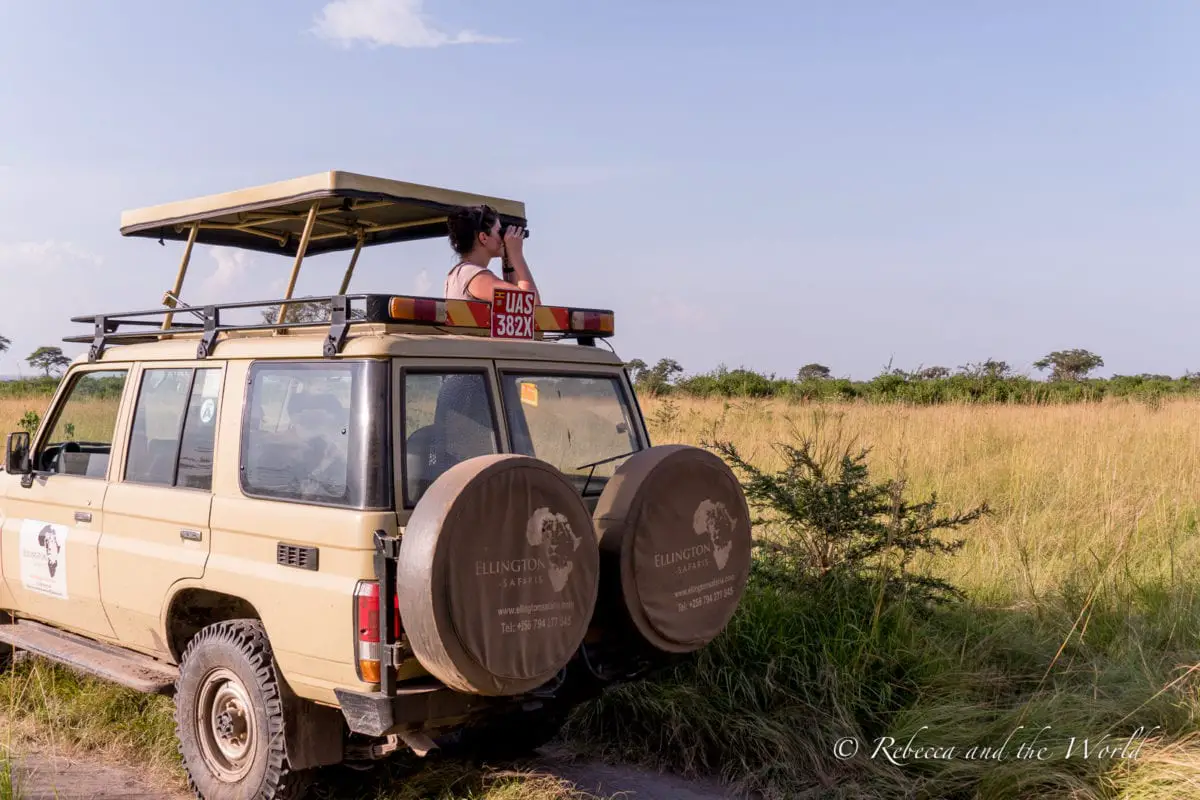
East Africa packing list
Here’s everything that was on my East Africa packing list – along with some extra thoughts on things I wish I’d brought with me, and stuff I should have left at home !
Keep in mind that my trip was a month long and was quite active, so you may not need as many changes of clothing as I packed. I mean, I didn’t even need this many!
I also have a guide specifically for what to pack for gorilla trekking , which outlines all the stuff you need to take for this incredible experience.
Bag – I ummed and ahhed over what type of bag to bring with me. Small airlines don’t accept hardshell suitcases, but I also didn’t want to bring a backpack because I preferred to have something I could wheel.
In the end, I settled on a soft-sided suitcase with wheels (similar to this one below ) that was perfect. The top unzips all the way around so I could easily access everything inside, and it has a separate zippered compartment on the bottom which was perfect for dirty shoes and stuff I didn’t access a lot. I could wheel it when I could, or pop it on back if needed.

- External grab handles for easy handling
- Locking pull handle
- End pockets for shoes and wet items
- Corner protectors guard against wear and tear at critical contact points
- Large u shaped main opening
Daypack – Bring a separate daypack that you can carry on the plane and also toss into your safari vehicle.
I took my husband’s GORUCK backpack with me because I wanted to be able to use my water bladder for hiking, and this backpack has a compartment for that.

If you’re not planning any hiking or major outdoor activities, a normal backpack will be fine. This Tortuga backpack is a game-changer. It’s got plenty of pockets, tonnes of space AND still counts as carry-on.
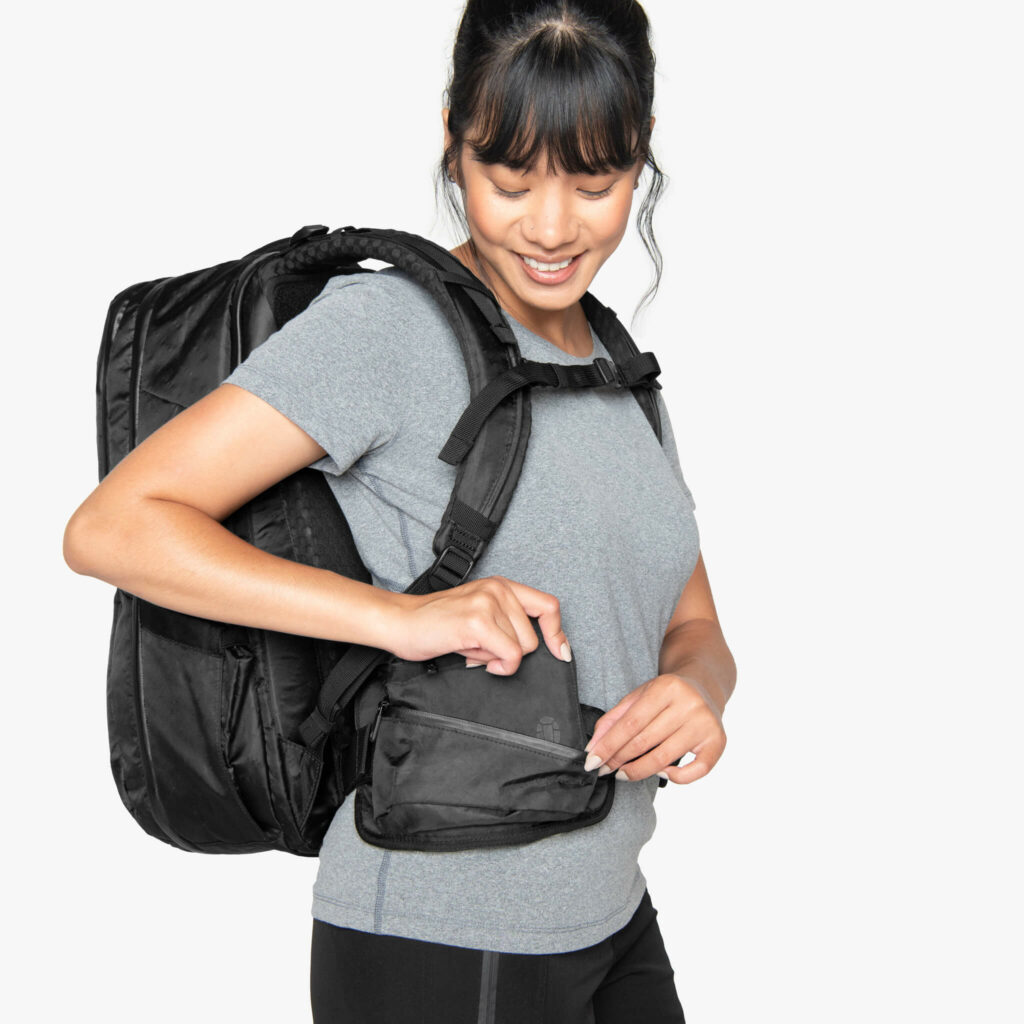
Small handbag – I also brought along a small handbag that could fit my camera, notebook and money when I was in cities or going to dinner each night at the lodge. It’s the white and black handbag in the picture below.
Packing cubes – If you don’t know about packing cubes by now, you’re missing out! These essential travel items help keep your bag organised. I took several Bagail packing cubes and had one for bottoms, one for tops, one for underwear/socks/bikini, and then another one for random odds and ends. It saves so much time rustling through your bag trying to find a specific item.

- Easy Travelling:Are you still worried about the chaos of packing for a trip? Introduce our packing cubes to join your travelling gear! They help to sort, organise and find items quickly. Let’s you start your trip with effortless organisation!
- Durable Fabrics: All packing cubes are made of 290D fabric. This fabric is strong and durable. We offer packing cubes with Precise internal stitching,smooth and durable zips for your everyday needs.
Reusable shopping bag – I always pack a foldable, reusable shopping bag. This is extra important in East Africa, because plastic bags are banned in many countries.
Bumbag – I packed this bumbag (that’s a fanny pack to Americans!) for my hikes and biking trip, so that I could easily access lip balm, hand sanitiser, my phone and other small items.
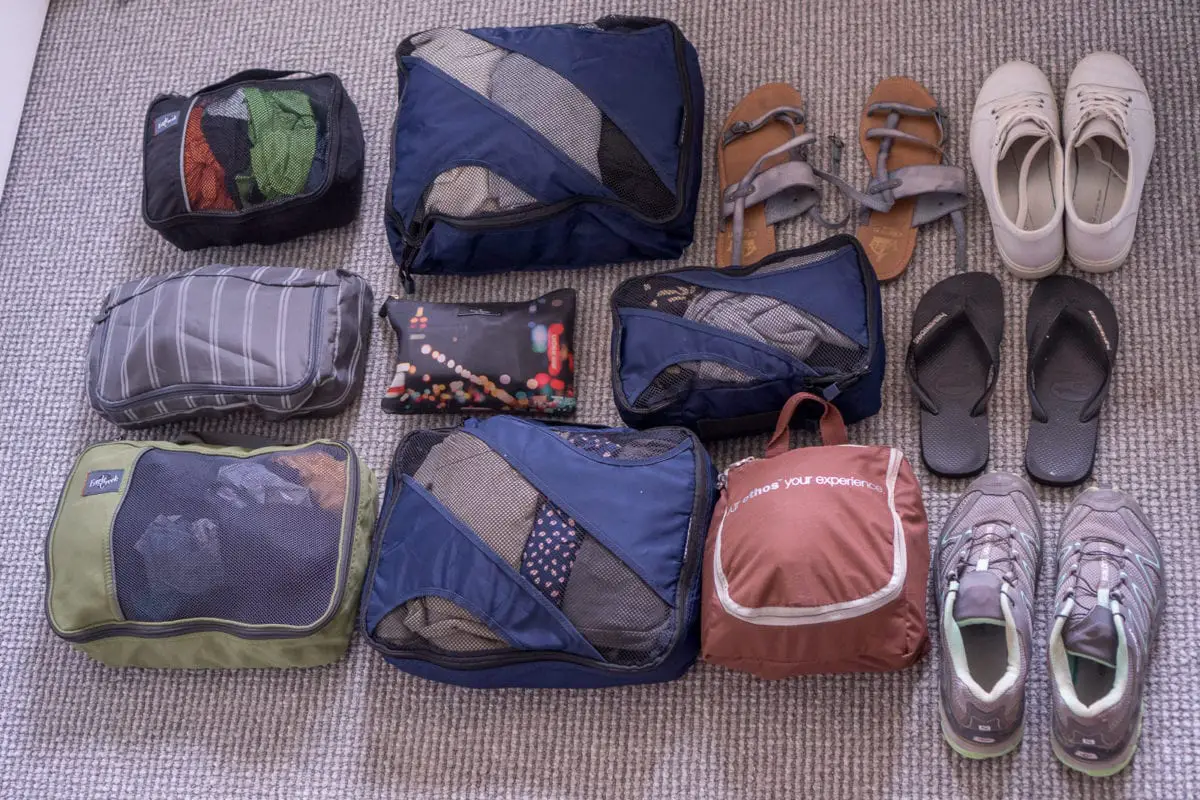
Pack 3 pairs of pants. I took a pair of lightweight joggers , black leggings and hiking pants (although I could have worn my leggings on the hikes).
Don’t even bother with jeans! I didn’t take mine and I didn’t miss them.
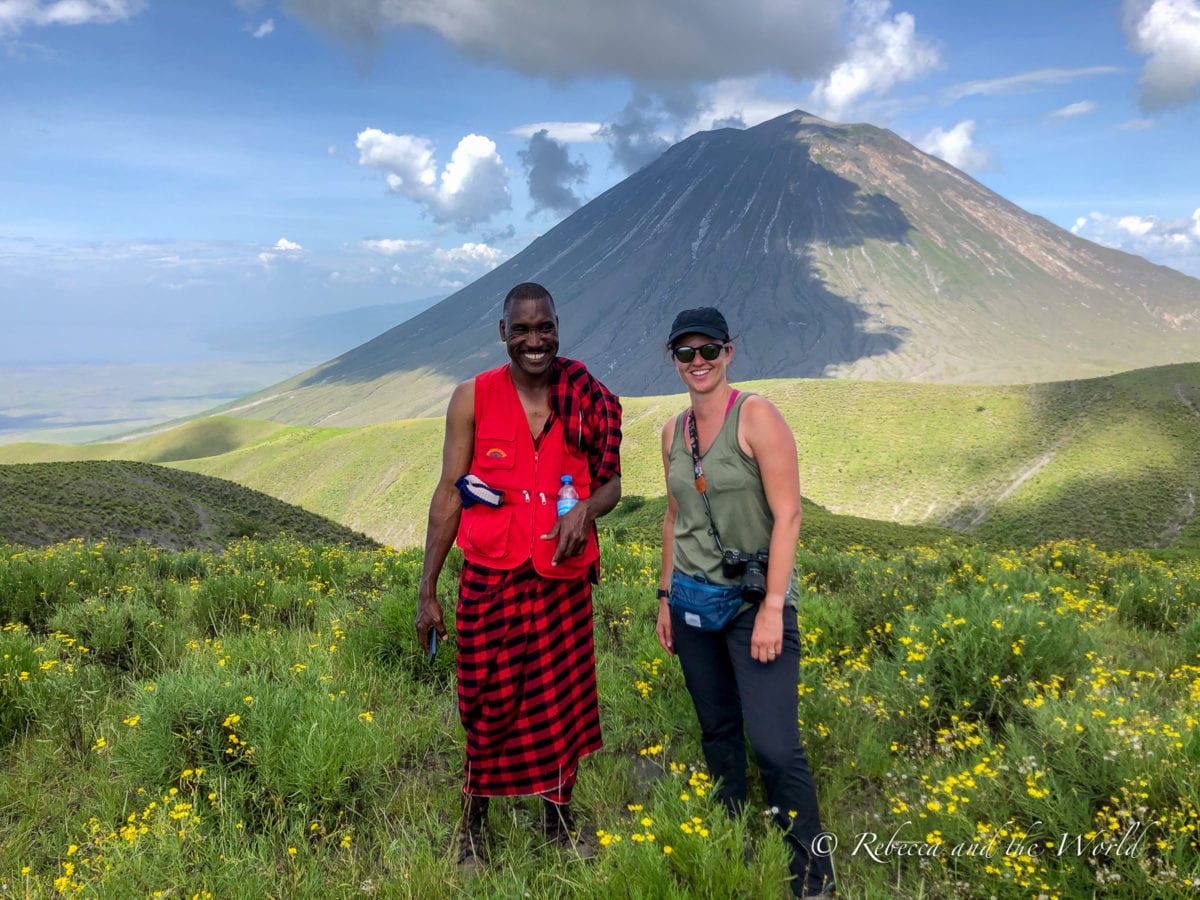
Skirts were the best things on my women’s safari packing list !
I took two midi skirts with me and found them to be so much more comfortable than wearing pants when I was sitting in a car all day. Skirts also proved far easier than pants when I needed to take a “bush wee”!
(Or you could pack a “ SheWee “! I’ve never used one but I have friends who RAVE about them!)

- ✅ THE ORIGINAL – Shewee Extreme Female Urination Device since 1999, accept no imitations! Made in the UK, sold to the world!
- ✅ DON’T SQUAT – Stand up and take control with our female urinal device, and avoid the filthy festival portaloos, and grim public toilets! Ideal for traffic jams, festivals, women in the military and MUCH more!
- ✅ DISCREETLY & EASILY – Have a wee whenever, and wherever you need to, without removing your clothing or underwear. She can pee stood up, simply unzip and go! Keep our pee funnel in your rucksack, handbag or glove box.
A midi travel dress is also a comfortable, stylish option. I love this lightweight merino wool travel dress , which you can easily layer.
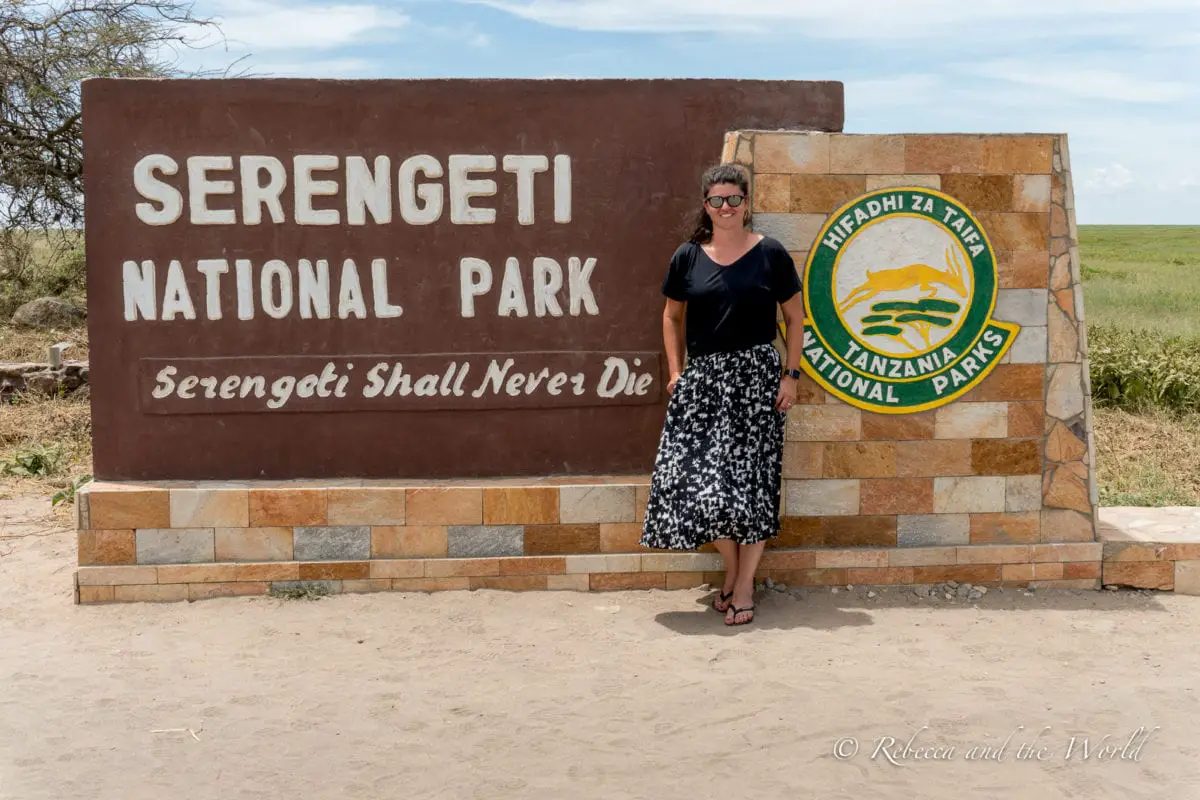
I packed one pair of paperbag-waisted shorts for my trip, and only wore them once when I was at the beach in Zanzibar (but I’m not a big shorts wearer anyway).
I also packed a pair of bike shorts to wear under my skirts. They were handy to stop chafing (aka the dreaded chub rub!). A definite must-have.
T-shirts and tops
I recommend packing a mix of t-shirts, tank tops (singlets) and sleeveless shirts , in a variety of colours (preferably lighter colours), as well as long-sleeved tops :
- 3-5 t-shirts, tank tops and sleeveless shirts – consider merino wool t-shirts because they won’t smell even after wearing them for days!
- 1 long-sleeved knit top or cardigan to wear in the cooler evenings – these merino wool tops are fabulous because they’re breathable and warm
- 1 long-sleeved sweater or button-up shirt for layering on cold mornings or while hiking
I took more tops than this and really didn’t need to! Don’t be like me – keep your safari packing list simple!

Along with your lightweight long-sleeve tops, consider packing an additional jacket for layering. I packed a denim jacket, which made me feel a bit more stylish when I was in cities. I actually rarely wore it.
However, despite what you may think, East Africa does get cold, so pack the right number of jackets for the season and region you’re visiting.
Whatever the season, this lightweight rain jacket is essential all year round.
I thought really hard about the shoes I brought with me – I wanted to minimise the number because they’re usually the heaviest things to carry.
In the end, I packed:
- These waterproof hiking boots that I wore on the gorilla trekking and during my 3-day Tanzania hike. If you’re not doing much hiking, you could swap these out for something that you could also wear during the day while on safari.
- Sneakers – I brought a pair of white leather sneakers . These may not seem to be the most appropriate colour to pack, but because they were leather I could wipe them down each night and keep them (relatively) clean.
- Sandals (or flip flops) – great to wear at night time and around beach areas, as well as in the safari vehicle. These Teva sandals are comfortable, hardy and look cute.
Other clothes on my East Africa packing list
Once you’ve got your bottoms, tops and shoes sorted on your Africa safari packing list , make sure you pack:
- Pajama pants and top
- Bra x 2 (black and nude – or whatever colours work best with the tops you’ve packed)
- Sports bra if you’re doing any active stuff – and to keep your ladies happy on bumpy African roads!
- Underwear x 7 pairs
- Socks x 5 – mix of ankle socks and hiking socks
- Bikini / bathing suit
- Swimming cover up and/or sarong
- Scarf – Bring a couple to mix up your outfits. They’re also great for covering up in more modest places like Stone Town
- Bandana or a cute head scarf to keep your flyaways in place while you’re speeding along rutted roads
- Hat – a must to keep your face protected from the sun
- Buff or something to put over your mouth for dusty roads (a scarf could also do double duty for this)
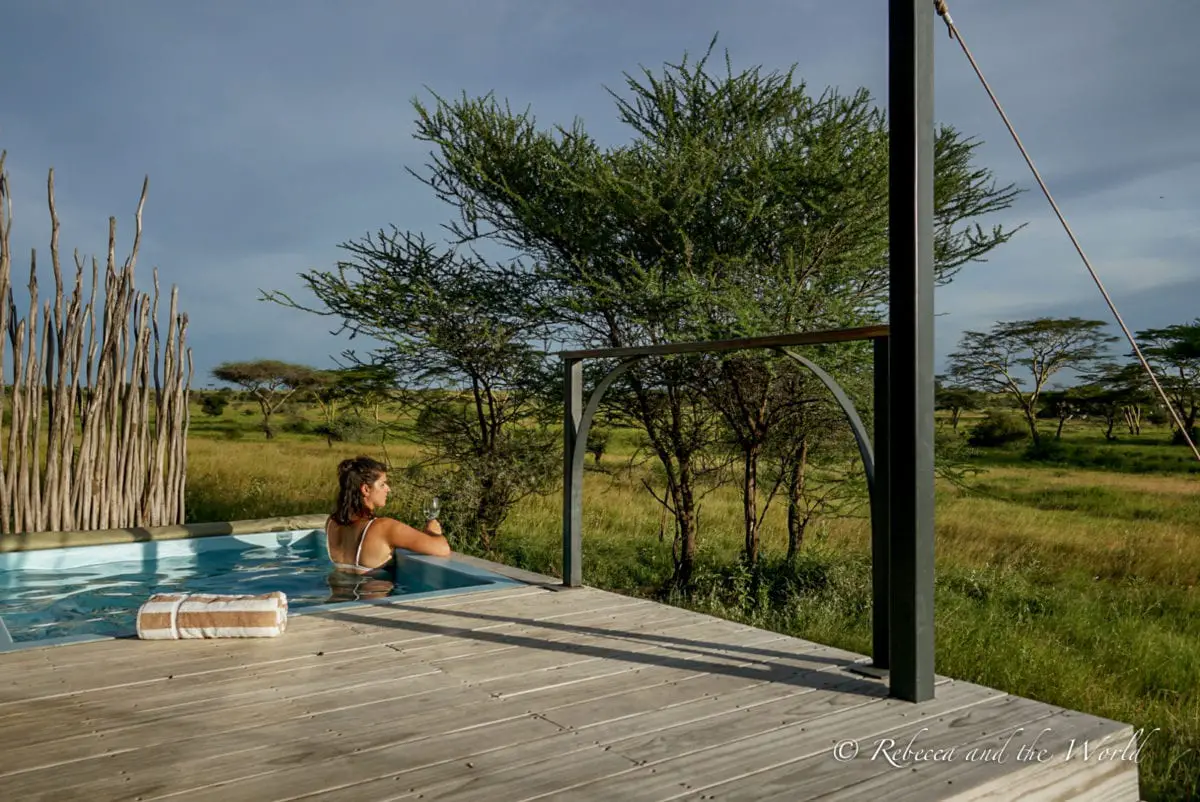
Travel gear for East Africa
Now we’ve gone through what to wear on safari (and beyond), here’s the other gear I packed to make my trip to East Africa comfortable.
Reusable water bottle – I always pack my Nomader water bottle which handily compresses down when it’s not full. I could fill up at hotels (many have filtration systems to treat water or buy bottled water in large bottles) or from the large, 10-litre water bottles that I asked my safari company in Uganda to buy.
I’ve been thinking of investing in a Grayl water bottle , which also filters the water so you can fill up from taps.

- ONEPRESS GLOBAL PROTECTION. Empowers international travelers and outdoor adventurers to make the world’s sketchiest water sources clean to drink. Ideal for global travel and outdoor adventures (hiking, camping, backpacking, fishing, hunting) and survival
- REMOVES ALL PATHOGENS. 99.9% of viruses (e.g. rotavirus, norovirus, hepatitis A), 99.9999% of bacteria (e.g. E. Coli, salmonella, dysentery), and 99.9% of protozoan cysts (e.g. giardia, cryptosporidium, amoebae)
- FILTERS particulates (e.g. sediment, microplastics) and adsorbs volatile organic compounds (VOCs), PFAS, chemicals, pesticides, herbicides, heavy metals, flavors and odors
Binoculars – I didn’t bring my own binoculars, because the safari companies I worked with carried a pair in their vehicles. However, these are going to be must-have things to take on safari for serious birdwatchers and wildlife lovers . A birdwatching friend recommends these binoculars for entry-level wildlife watching.

- Sophisticated rubber armored exterior design provides shock resistance and a firm comfortable grip
- Locking diopter control maintains your personal setting
- Oil/Water repellent coating – applied to both eyepiece and objective lens surfaces
- Nikon’s Legendary ED (Extra-low Dispersion)Glass Lenses
- Waterproof (up to 1m/3.3ft for 10 minutes) and nitrogen-purged for fog-free performance
Quick dry towel – I packed a quick dry towel but didn’t end up using it at all on the trip. All the lodges and camps I stayed at provided towels. If you’re backpacking in East Africa, however, this would be an essential item.
Head torch – An essential item for dark African nights! I used this when I was camping in Tanzania, but also had it next to my bed when I stayed in lodges and safari camps just in case the power went out.
Eye mask and ear plugs – Necessary for the long plane ride to East Africa (check out my other essential items in my long-haul flight packing list ), and also handy for sleeping in places that may not have great curtains. I also downloaded a white noise app in Rwanda when a party across the lake kept going until 3 a.m.
Drybag – I packed a drybag to keep my camera safe while hiking. Luckily, I didn’t have to use it, but I was glad to have it just in case.
iPhone waterproof case – My iPhone waterproof case is great because it hangs around my neck. This means my phone is easily accessible while hiking, and it stays dry if there’s a sudden downpour.
Combination padlock – A combination padlock is handy if you need to leave your bags somewhere for a few days (like I did when I biked the Congo Nile Trail in Rwanda). Don’t pack a padlock that needs a key just in case you lose the key.

- TSA approved luggage lock enables screeners with the ability to inspect and relock luggage without damaging lock
- Set your own three-digit combination luggage lock; TSA lock is best used as a luggage lock or backpack lock
Bamboo cutlery set and metal straw – Another small item I always pack when I travel is my bamboo cutlery set and a metal straw. Although East Africa is quite progressive when it comes to single-use plastics, this is still a handy item to have.
Water bladder – While hiking, I much prefer to have a water bladder than a water bottle. I can easily slip the tube over my shoulder and drink to my heart’s content rather than having to stop, pull a bottle out of my backpack, drink and then put it back.
Travel pillow – A travel pillow is handy on a plane, and you’re also going to have some long days of driving. Avoid drooling all over your shoulder and waking up with neck cramps by packing a travel pillow like the TRTL pillow , which keeps your head upright as you nap in a seat.
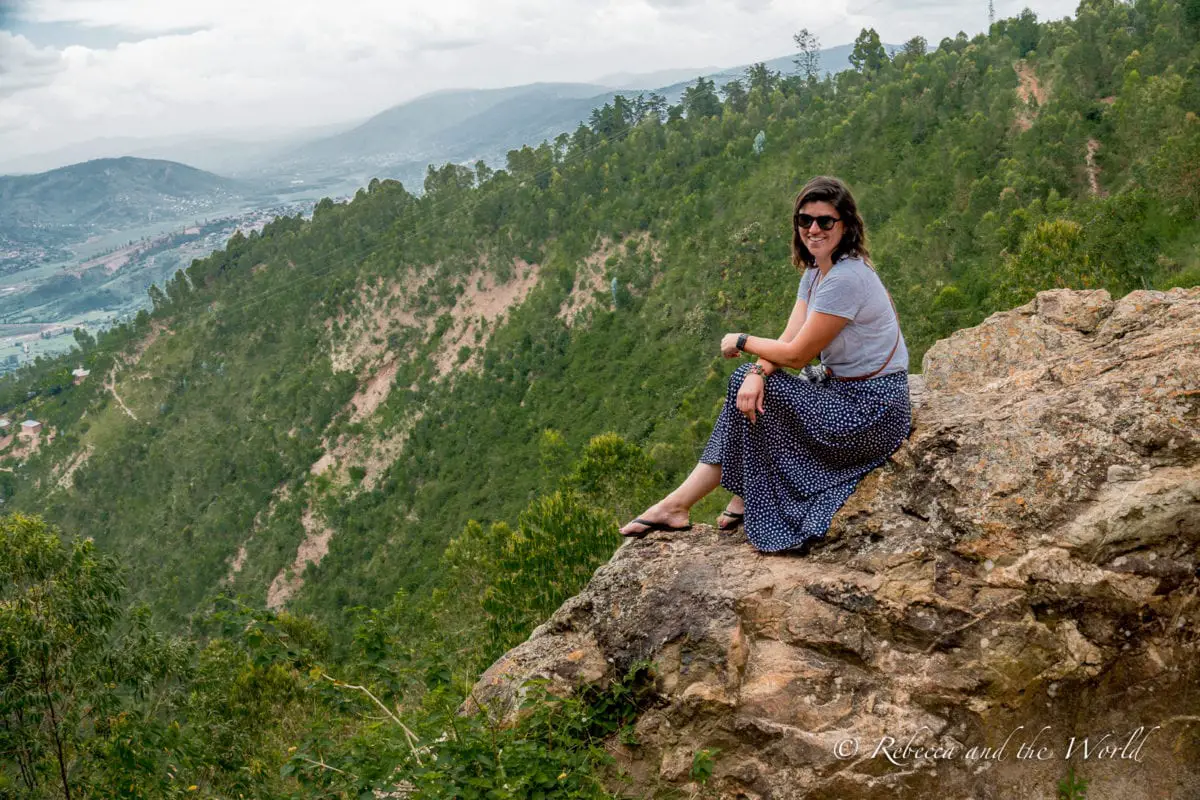
The technology you include in your East Africa packing list will likely be different to mine, but there are a few things I recommend packing even if you aren’t blogging along the way.
Power bank – I packed a power bank just in case my phone or camera ran out of juice while I was on the road. I was glad I did, because many of the camps and lodges I stayed in didn’t have charging stations in the room (because they’re on solar power). However, the safari vehicles did have charging ports which was also handy as a backup!
Adapter with multiple ports – The countries in East Africa have different plugs, so pack a multi-port adapter like this one to cover all bases.
e-Sim card – to stay in touch with people back home (note that Rwanda isn’t covered)
Kindle – I took my Kindle because I didn’t want to have to lug a handful of books with me on my trip. I had some books already downloaded, along with the Lonely Planet East Africa guidebook . Consider downloading some books that are about the countries you’re visiting. These are some of my favourites:
- Kenya – Unbowed by Wangari Maathai or Out of Africa by Isak Dinesen
- Tanzania – The Zanzibar Chest by Aidan Hartley
- Rwanda – We Wish to Inform You that Tomorrow We Will Be Killed with Our Families by Philip Gourevitch
- Uganda – Kintu by Jennifer Nansubuga Makumbi or Abyssinian Chronicles by Moses Isegawa
If you’re a photographer (or a blogger like me!), you’ll also be packing:
- A good camera (I took my Sony A6300 which I love because it’s so light)
- Lenses (I took two lenses, a 18-135mm and a 35mm, but I wish I’d also bought and packed something longer)
- Camera charger and extra batteries
- Lens cleaning kit because it gets dusty on the African roads
- A Gorillapod or a full tripod
- A gimbal if you’re planning to do some video
- Microphone for video
- Plenty of memory cards
- External hard drive so you can download your photos each night
I know everyone’s different when it comes to toiletries, so use this as a guide. I tried to pack the minimum (but despite my efforts my bag was still so heavy!).
- Shampoo and conditioner – I squeezed what I needed for the month into these small silicone bottles
- Dry shampoo
- Moisturiser (with SPF) – Make sure your face moisturiser also has sunscreen
- Sunscreen – Pack plenty of sunscreen – at least SPF50+ – as it’s expensive in East Africa
- Face wipes – It’s nice to wipe off the dust at the end of each day
- Cotton buds
- Makeup – I took minimal makeup, just some eyebrow powder, mascara and highlighter
- Hair ties and bobby pins
- Toothpaste, toothbrush, floss
- Nail clippers/scissors + tweezers
- Body wipes – Great for wiping off after hiking, camping or doing active outdoor activities where you’ll be sweating a lot
- Toilet paper – Snaffle some toilet paper when you arrive, or bring some travel tissues. It’ll come in handy if you need to stop at public toilets (although I found most of them to be quite clean and well stocked)
- Tampons or Diva Cup – If it’s that time of the month
- A SheWee to make peeing on safari a little easier
- Toiletry bag – Pack everything in a toiletry bag, and don’t forget a clear case for your liquids when you’re flying
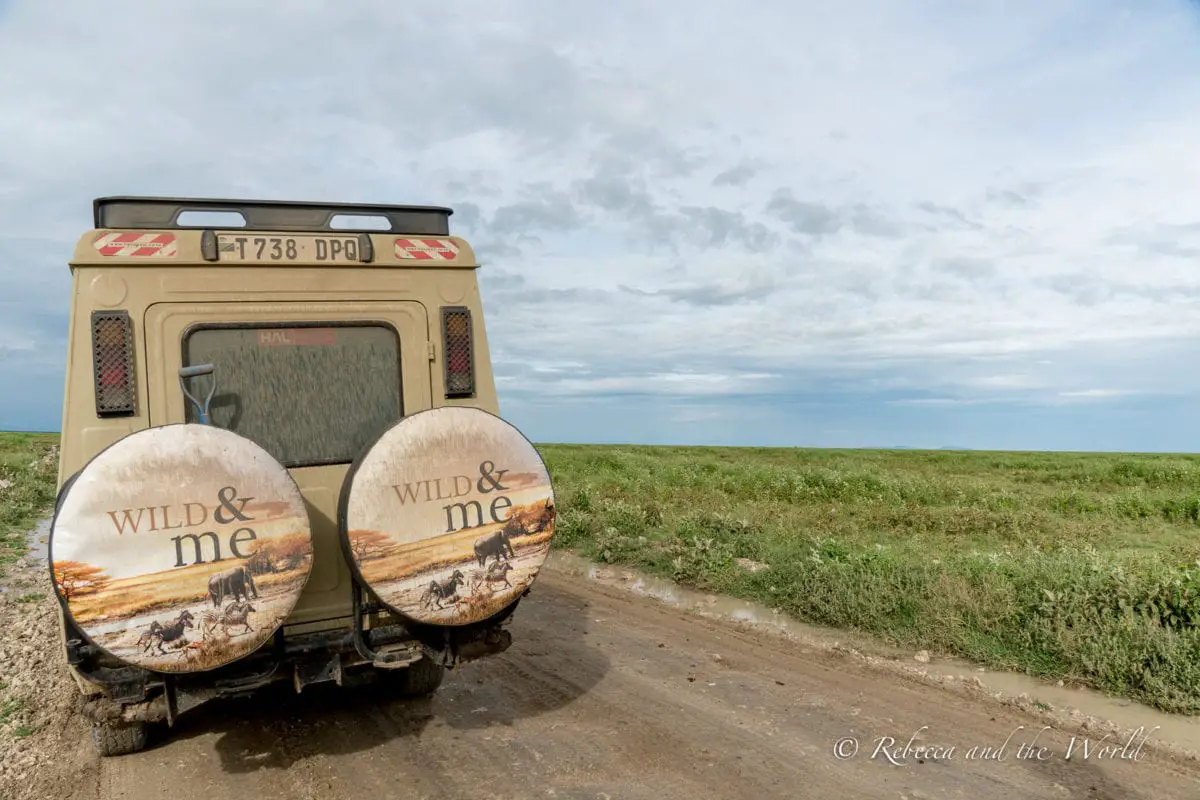
Medications and health items
You may find it harder to get medications while you’re in East Africa, especially outside of major cities. So, pack a good first aid kit with:
- Pepto Bismal or activated charcoal
- Hayfever tablets
- Antiseptic cream
- Antibiotics (get a prescription from your doctor)
- Rehydration sachets if you’re hiking or doing activities that will exert you
- Antiseptic hand gel
- Mosquito/insect repellent
- Aquatabs (or a water filter bottle )
- Cold prevention tables / vitamin C – I was particularly petrified of getting a cold before I visited the gorillas, because if you’re sick you can’t go!
- Antibacterial wipes – Handy for wiping down seat and tray tables on planes
- Other medications you take on a regular basis ( bring the prescription with you)
Documents and other items
Finally, here are the important documents you’ll need, along with a few miscellaneous items.
First up, you will NEED travel insurance. And always print out a copy of your policy certificate so you have the details easily at hand.
World Nomads offers simple and flexible travel insurance. SafetyWing is an excellent option for travel medical insurance when you’re out of your home country, while Travel Insurance Master can help you find the right insurance policy for your trip.
Other important docs and items to pack:
- Travel organiser – Great for keeping your passport and documents together in one place.
- Passport and extra passport photos for visas – Take a copy of your passport photo page and email it to yourself.
- Visa documents – Print out and keep safe any visa documents, including approval letters from governments.
- Yellow fever / vaccination records – Some countries in East Africa require you to have a yellow fever vaccination, so don’t forget to bring the record along with you.
- U.S. dollars – All countries in East Africa accept U.S. dollars. Indeed many hotels, airlines and other tourism businesses will quote you in USD.
- Notebook and pens – If you’re like me, you’ll want to record every aspect of your East Africa trip.
- Snacks – I brought along a variety of small snacks like nuts and bars. To be honest, though, the lodges and camps I stayed at fed me so much that I usually just ended up sharing my snacks with other people.
Wrap up: East Africa packing list
So, that’s everything I packed for East Africa! My key tips are avoid overpacking (learn from my mistake!) and pack lightweight clothes in light colours. You can look stylish while on safari and avoid the full khaki outfits and zip-off hiking pants.
I’ve included a lot of info in this article, so don’t forget that you can download this entire packing list in a simple list form in PDF .
Happy packing and enjoy your time in East Africa!
What to pack for East Africa: FAQ
Can i do laundry while travelling in east africa.
Many accommodations offer laundry services, but it’s a good idea to bring a small supply of laundry detergent and a travel-sized clothesline for washing small items.
Is it necessary to bring a power adapter?
Yes, East Africa uses various plug types. A universal adapter like this one will ensure you can charge your devices everywhere you go.
Are there any items I should leave at home?
There’s no need to bring flashy jewellery and things that will attract attention. Also, leave your hair straightener and hair dryer at home – many lodges run on solar power and can’t support appliances like these.
Do I need malaria medication?
Consult a travel clinic for malaria prevention advice, as it varies by region and season. Insect repellent is something you should definitely pack to protect against mosquitoes.
Do I need any vaccinations before traveling to East Africa?
Yes, certain vaccinations are recommended. Check with your healthcare provider for the latest recommendations.
Did you find this article helpful? Consider buying me a coffee as a way to say thanks!
What else would you add to this East Africa packing list? Help other travellers by leaving a comment below.
Related posts
Before you go… these posts might be of interest:
- A Unique 2-Week Tanzania Itinerary: Adventure, Safaris and Beaches
- A Wildlife-Packed Uganda Itinerary: One Week in the Pearl of Africa
- Gorilla Trekking in Uganda and Rwanda: What You Need to Know
EAST AFRICA PACKING LIST: PIN IT FOR LATER
Save this guide to what to wear in East Africa to Pinterest so you can plan your own packing list later.
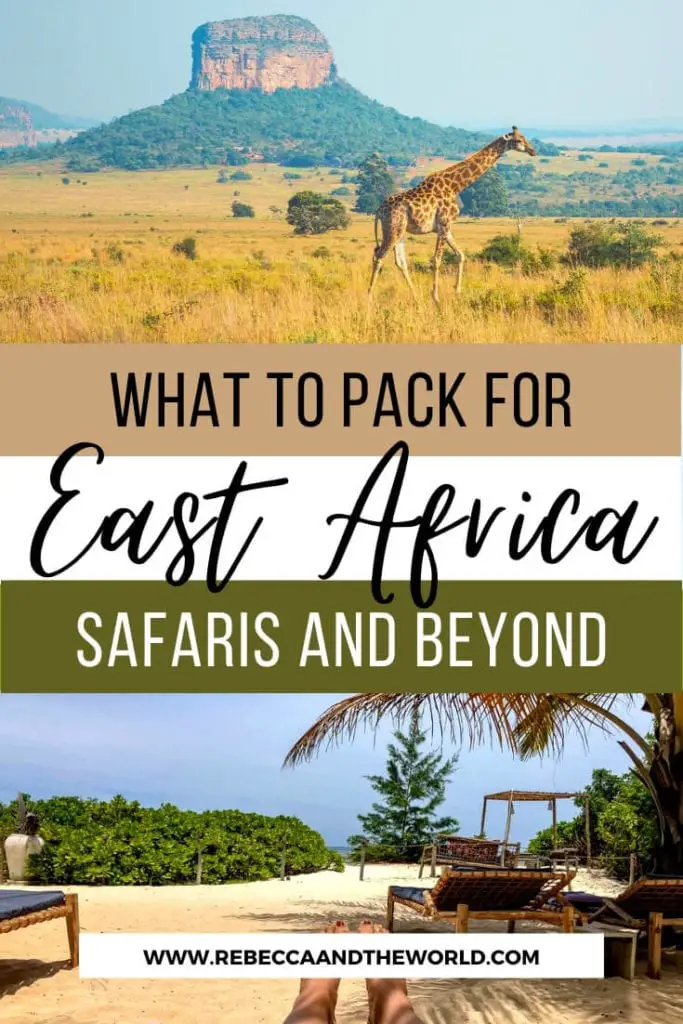
About REBECCA
I'm a travel junkie who started dreaming about seeing the world from a very young age. I've visited more than 40 countries and have a Master of International Sustainable Tourism Management. A former expat, I've lived in Australia, Papua New Guinea, Argentina and the United States. I share travel resources, tips and stories based on my personal experiences, and my goal is to make travel planning just that bit easier.
6 thoughts on “East Africa Packing List: What to Wear on Safari and Beyond in 2024”
hi i see you are wearing black i thought it wasn’t recommended
Hi Jane, I took one black t-shirt (as seen in the pic) but most of my tops were grey or lighter colours (eg. pink or khaki – as you can also see in other photos). Black definitely isn’t recommended but I didn’t have any issues with tsetse flies or similar on the days that I did wear black.
Hi Rebecca. I am leaving in Sept for Rwanda and East Africa. Did you take the 28″ or 32″ bag? Your list is FANtastic! Thank you so much. We are going for a month. So much to take even if thoughtfully packing. Appreciate your feedbaci.
Oh have the most amazing time!! I think I took a bag that was more on the 32″ size… key is to make sure it’s not over the weight limit if you are taking any internal flights on small aircraft.
Fantastic list! And I really appreciated the insight about what you brought and what you really used/needed/wished you had brought or left behind. Thank you for such a thorough and helpful list!
Glad it helped! It’s confusing to know what you do and don’t need on a safari trip!
Leave a Comment Cancel reply
MORE INFORMATION
ABOUT WORK WITH ME CONTACT PUBLISHED WORK
AFFILIATE DISCLOSURE
AS AN AMAZON ASSOCIATE I EARN FROM QUALIFYING PURCHASES
© 2024 REBECCA AND THE WORLD
Privacy Policy
I ACKNOWLEDGE THE WURUNDJERI AND BOON WURRUNG PEOPLE OF THE KULIN NATION AS THE TRADITIONAL OWNERS OF THE LANDS AND WATERWAYS OF THE AREA I LIVE ON. I PAY MY RESPECTS TO ELDERS PAST AND PRESENT AND CELEBRATE THE STORIES, CULTURE AND TRADITIONS OF ALL ABORIGINAL AND TORRES STRAIT ISLANDER PEOPLE ACROSS AUSTRALIA.

- Privacy Overview
- Strictly Necessary Cookies
This website uses cookies so that we can provide you with the best user experience possible. Cookie information is stored in your browser and performs functions such as recognising you when you return to our website and helping our team to understand which sections of the website you find most interesting and useful.
Strictly Necessary Cookie should be enabled at all times so that we can save your preferences for cookie settings.
If you disable this cookie, we will not be able to save your preferences. This means that every time you visit this website you will need to enable or disable cookies again.

What To Wear On Safari
What clothes to pack for your safari.
The type of safari clothing you decide to pack for your safari will depend on a number of things, including the destination, time of year and what type of safari you’re going on. However, there are a number of universal principles when it comes to deciding what to wear on safari.
Click below to go straight to the most relevant section, or scroll down to read the full safari clothing article:
Safari wear basics | Safari shirts | Trousers | Footwear | Safari hats | What not to wear
Safari wear basics
What’s the best colour to wear on safari.
The basic rule of suitable colours for safari clothes is to go neutral . When trying to spot wildlife you’ll have the best chance if you blend in as much as possible with your surroundings, and bright colours will make you conspicuous to animals – particularly if you’re on a walking safari .
Ideal colours for safari wear are natural, such as:
- Light Browns
Whilst any other neutral colours are fine too, there are a number of colours you should definitely make sure you don’t wear on safari wear:
Camouflage clothing is a big no-no, and in some African countries it’s actually illegal , so leave the camouflage safari clothing at home!
White and very pale coloured clothes show up the dust, so are best kept for evening wear.
Dark blue and black colours attract insects and mosquitos, which can carry malaria, yellow fever and dengue fever – some of the most serious health risks you might encounter on safari.
Ideal safari clothing material
The ideal material for safari clothing is something that’s lightweight & breathable and makes minimal noise whilst you’re moving. Simple cotton works best for safari shirts and trousers, though there are increasing numbers of quality modern man-made materials that work just as well as cotton and are even more durable.
Think layers for safari wear
Packing lightweight safari wear has the benefit of enabling you to layer up or down according to need. Africa is a continent of extremes – it can be extremely cold through the night into the early morning and swelteringly hot by the middle of the day.
As such it’s a good idea to take multiple layers of safari clothing so you can add and remove layers as required – including at least one warm layer like a sweatshirt, fleece, or safari jacket . This is particularly important if you’re going to be doing any early morning safaris in an open-sided vehicle (though your lodge will likely provide blankets for early morning game drives).
What to wear on safari – the essentials
When it comes to safari clothing less is more, and most camps and lodges have same-day laundry services, so bear this in mind before packing a huge suitcase full of safari clothes! At a minimum you will need:
Safari shirts
A few comfortable long-sleeved shirts and long-sleeved t-shirts. Long-sleeved safari shirts have the advantage of offering protection from the sun and insects, but also being able to roll the sleeves up if it gets too hot.
Shirts with a collar to protect the neck from the harsh sun are advisable, as are shirts with pockets to store your bits and pieces (see our article on top things to take on safari if you’re after useful things to fill your pockets with!).
Our favourite men’s safari shirts:
[amazon box=”B07427LJG9,B00EO32DCW,B06XD5V6D9″ grid=”3″]
Our favourite women’s safari shirts:
[amazon box=”B0868LGBCY,B07115T7MB,B07M8BCYYK” grid=”3″]
Trousers & shorts
A pair of comfortable long trousers or two, and a pair of shorts. Combat style trousers and shorts are ideal safari gear as they have several pockets, great for storing compact binoculars, suncream, camera etc.
Long trousers have the benefit of keeping you warm and protecting you from the sun in the day and mosquito bites on evening and night game drives. Here are some good safari trouser options:
[amazon box=”B01D60XBVK,B08DTW3F7W,B00DQ5244G” grid=”3″]
The type of footwear required to wear on safari really depends on what type of safari you’re planning. For a standard game drive or self-drive safaris , special safari footwear isn’t necessary. You’ll be climbing in and out of safari jeeps and maybe a little walking around the bush, so comfortable trainers will work fine.
For more specialist safaris such as gorilla trekking you’ll be trudging through thick, uneven rainforest, so rugged Gortex boots are ideal. For any kind of walking safari, it’s advisable to have some sort of hiking boots that cover your ankles – for protection from both bush and snakes. It’s also worth considering a small investment in some hiking specialist insoles to provide extra comfort.
[amazon box=”B0779Q9G9B,B081P5WBQV,B01HFPP89A” grid=”3″]
Whilst not essential safari wear, any hat or cap is better than none at all. It will give you protection from the sun, and also shield your eyes from the glare – meaning potentially better wildlife spotting opportunities. The ideal hat is a wide-brimmed safari hat to offer maximum protection.
Read our take here on the very best safari hats , or check out these great options from Amazon:
[amazon box=”B06XH2JSK7,B072J5JS25,B07K447FF5″ grid=”3″]
The African sun can offer a surprising amount of harsh glare, so you won’t want to forget sunglasses as part of your safari attire. A pair of polarized wrap-around sunglasses will give you protection from both the glare and the dust that’s a feature of many game drives, meaning more chance of spotting that hiding leopard!
Evening wear
When considering evening safari wear, bear in mind that the days of jackets and ties at the dinner table are long gone. Most safari lodges have relaxed dress codes for dinner so there’s no need to take any formal safari clothes with you.
You’ll want to wash and change after a hard and dusty day’s game viewing, but a pair of jeans or trousers and a long-sleeved shirt will suffice, perhaps along with a warm fleece or safari jacket to ward off the night-time chill. Light colours are recommended for evenings so you don’t attract mosquitoes.
Be sure to check out whether your lodge has a swimming pool and if so, don’t forget to pack some safari-chic swimwear. A dip between game drives during the middle of the day is a great way to contemplate your wildlife viewings (past and future!) whilst working the tan.
What not to wear on safari
The above information should give you a good overview of what safari clothes to take with you, but just in case you’re still in any doubt, here’s a list of the clothes you should absolutely not take with you on safari:
A camouflage safari outfit . In a number of African countries, you can actually be arrested for wearing army-style camouflage clothes that could be confused with military wear. Best to avoid at all costs.
Overly thick fleeces and jackets . Temperatures on safari change depending on the time of day, where you are, and what altitude you’re at… so layered clothing is ideal to add or remove as the temperature requires.
Heavy walking boots . Unless you’re planning to do some serious hiking a pair of trainers will do for walking around camp and hopping in and out of your jeep.
Black and blue clothing . East Africa is home to the tsetse fly which is attracted to dark colors and packs a nasty bite – best avoided by wearing lighter colours.
Bright clothing. Don’t draw attention to yourself if you want the best chance of spotting wildlife .
Tuxedos & ballgowns. Yes, people do! Most safari lodges have a very relaxed dress code for dinner, and whilst you will want to wash and change after a hard day game viewing you won’t need to dress over-formally for any evening activities.
And one last ‘don’t do’ tip for packing your safari wear:
Packing it all in one large suitcase . Limit the risk of all of your luggage going missing or being stolen on the flight by packing some essentials – and one safari outfit – in your hand luggage.

Hawaiian shirts are a classic no-no as safari clothing
Have you been on safari lately and have some tips on what to wear on safari? Please let us know by getting involved in the comments section below!
Have a sneak preview at http://www.youtube.com/watch?v=glO-rRsPBIo&feature=youtu.be All authentic gear – made close to the Kruger National PArk in South Africa – available here in the UK
We are travelling to South Africa to do a safari adjacent to the Krugar. Is that right that Camouflage is completely no allowed? Only I have just purc hased Shorts and a Hat. Please advise
Hi Colleen, as far as I’m aware there are no restrictions on camflage wear in South Africa, so you should be fine. That said, to be sure you should drop your safari lodge a line as they may have their own rules.
This is suitable for safaris! http://www.cafepress.com/guaxinim/9341456
Do you consider light to medium gray to be ok for colors
Hi Aggie, medium grey is a good colour for safari clothes, so long as it’s not too dark and not too light!
I would be interested in specific suggestions of brands to check out for women’s safari wear. Thanks, Barbara
An item I found extremely useful for gamedrives in open vehicles during winter is my large olive rain poncho. It works fine as a wind spiele and easily fits over the extra set of blankets you might wrap around you.
Excellent idea Birgit, I’ve never used a poncho, but I’d imagine they’re ideal for game drives – lightweight, and quick and easy to get on and off according to the weather.
Sounds like a great idea Birgit. We’ve been on a few high-end safaris where they’ve provided ponchos on bad weather game drives… but taking your own means you’ll be sure to stay dry!
Top countries for safaris
- Botswana safaris
- Kenya safaris
- Namibia safaris
- South Africa safaris
- Tanzania safaris
- Uganda safaris
Safari basics
- Safari animals
- How to find the right safari company
- When to go on safari
- What to take on safari
- Safari clothing – what to wear
- Safari rules & etiquette
- Wildlife spotting tips
Most read articles
- All about the ‘big five’ animals
- Collective nouns for animals
- Safari movies to watch before you go
- The world’s fastest land animals
- Apex predators
- 10 Fascinating African tribes
- The biggest animals in the world
- 17 Epic hybrid animals
- The world’s ugliest animals
- Why are flamingos pink?
Africa’s best game reserves
- Chobe National Park, Botswana
- Etosha National Park, Namibia
- Kruger National Park, South Africa
- Masai Mara National Reserve, Kenya
- Moremi Game Reserve, Botswana
- Okavango Delta, Botswana
- Serengeti National Park, Tanzania

Session expired
Please log in again. The login page will open in a new tab. After logging in you can close it and return to this page.

Stylish Safari Clothes & Complete Kenya Safari Packing Guide
November 13, 2019

About a month before I was to leave for my Kenya safari holidays , I realized I didn’t have any of the safari clothes that were recommended by the Elewana Collection , my travel host.
Khaki, tan, gray, beige, olive green? Um, no. My wardrobe has always consisted of bright colors, vivid florals, and crazy patterns. Perhaps you’ll have it better than me, but I had to put my personal preferences aside and buy some new safari clothes so that I could blend in with the bush, comply with safari PC, and yet….still look cute. 🙂
Packing for a safari isn’t as easy as other trips where I’m a master at traveling light and taking only a roll-aboard suitcase. There are many limitations and restrictions that you don’t run into on other trips. Added to that challenge is the fact that because I’m a travel blogger, I also had to maintain my branding image for social media. I was able to accomplish both, so I’m sharing these tips as well as other important info on what to pack, as well as places to buy everything to save you days of searching online and/or weeks of shopping at brick-and-mortar stores. Trust me, I did both.

When spending time at your camp, you can wear sandals and brighter clothing if you like.
It’s important to check with your lodge to see what they provide because the luggage weight limit is tight.
Also, a lot will depend on whether you are on a luxury or budget safari. I was on a luxury safari that supplied a lot of extras that I did not have to pack. They also provided free daily laundry service which enabled me to get away with bringing just two pairs of shorts, one pair of safari pants, one pair of leggings, and one pair of PJs. I did bring quite a few tops but they didn’t take up much room in my luggage.
ENTRY REQUIREMENTS
The word safari means “journey” in Swahili. Don’t forget these important items for your journey!
Naturally, you need a passport. Make sure that it is valid for at least six months prior to your arrival and it also must contain a minimum of two blank pages for stamps. It’s easy to overlook this requirement, but I can tell you first-hand, Africa is a stickler on this. Earlier in the year, I was on a cruise from the Seychelles –> Madagascar –> Reunion –> Mauritius. When I left home, I had three blank pages. However, because there were so many ports in Madagascar, they stamped the heck out of my passport and I did not have a single blank page left when I tried to leave Mauritius. They detained me for a short time but were able to get a special transport allowance only because I was going home.
Americans need a visa to enter Kenya. This can be obtained at the original point of entry, or you can obtain an e-visa online to save time. A single entry visa costs $50 per person.
Immunizations
A Yellow Fever immunization is required if you will be traveling from Kenya to Tanzania or South Africa. An official (yellow) card should be kept with your passport and presented along with your visa.
It’s also a good idea to make sure you are up to date on immunizations for Hepatitis A and B, tetanus, and meningitis.
While not required, the Center for Disease Control suggests that you consider getting a prophylactic prescription for malaria. My go-to for malaria prevention is always Malarone because there are no side effects for me (some of the other malaria drugs are reported to have some bad side effects). Dosage begins two days before you enter the country and continues for one week after you return.
Travel Insurance
DO NOT TRAVEL TO AFRICA WITHOUT TRAVEL AND/OR EVACUATION INSURANCE. You never know what can happen – of this I have first-hand knowledge having survived a devasting car crash in South Africa in 2014.
Click here to find travel insurance that fits your needs.
BEST TIME TO GO
Our Kenya safari was in October, which turned out to be a fantastic time to go. It was warm during the day and cool in the evenings. It was sunny every day, although there was an occasional shower during the night.
If you are going to the Maasai Mara, June to October is the best time to see the migration of the massive herds of wildebeest.
Mosquitos and tsetse flies can be a big problem in Africa. Tsetse flies are reportedly not deterred by bug spray, even DEET, and their bites are painful and itchy. However, we did not see a single one of either.
Soft Duffel
A medium-sized soft duffel will usually be required because it can be manipulated into the small luggage holds in the bottom of the plane. While some recommend against wheels, that’s a nonstarter for me. I’m not that strong, and the thought of carrying a 33 lb. duffel from airport to airport, lodge to lodge, isn’t even an option. Yes, the weight limit for the small commuter planes was a maximum of 33 lbs. which included both your duffel and any other carryon, backpack, or purse.
The small commuter planes that you will take if you’re traveling from one camp to another also require your bags to be soft-sided.
Packing Cubes
I never go on a trip without using packing cubes . Never. They allow me to keep my clothing organized by color, type, day/night, etc. And don’t forget to tightly roll your safari clothes to save room and avoid wrinkling.
The number one item you’ll need on a day-to-day basis is a daypack (small, lightweight backpack). In it, you can easily stash your camera bag, reusable water bottle, smartphone, sunblock, mosquito repellent wipes, camera lens wipe, and journal.
Jostling is the normal ride of the jeep on the very bumpy paths around the national parks and conservancies. Having your camera stowed in a padded camera bag inside your daypack when not using it will protect it from getting bumped and damaged. The type to get is dependent on the size of your camera, but I’d opt for the smallest, tightest one for best protection as well as to take up less of the valuable space in your daypack.
There should be something in your daypack to protect your technical equipment if it starts raining. You can pack a small dry bag or clear stadium-style plastic bag . In a pinch, use a Ziploc.
Crossbody Purse
I always bring a lightweight (fabric) crossbody purse that I can stick in my daypack, drape over my shoulder at night, or wear crossbody (anti-theft) when visiting markets. It contains such things as my phone, medications, reading glasses and cash.

Shorts with a long-sleeved shirt layered over my tank top worked out great on sunny morning game drives.
To a certain extent, the colors you wear while seated in the jeep during game drives is not as important as when walking in the bush. Having said that, here’s the rule of thumb on colors:
- Blue and Black – attract tsetse flies that have a painful bite. Plus dark colors attract heat so it’s best to avoid them.
- Red – predators identify red with wounded animals.
- White – the dust of the savanna and on game drives will turn these brown in no time.
- Camouflage – it’s associated with the military; Kenya banned the sale and wearing of clothes resembling military or police uniform in 2006.
- Bright colors – can distract the game.
It’s also notable that you don’t want to be THAT person, you know, the one in the jeep that is annoying to everyone else because your neon colors seep into and ruin their “authentic” experience and/or photos. I decided to let the animals be the center of attention… just this one time.
After giving it a great deal of thought and infinite research, I decided that all my safari clothes would coordinate with dark olive green as my base color. With the weight limit on luggage, this would allow me the highest number of outfit changes because I could switch out tops and bottoms.
Pack things that you can mix and match. You can create a good number of outfits just from pairing a handful of safari clothes in different sequences. Just adding a scarf or jewelry can transform your game drive clothing into a suitable casual dinner ensemble.
You’ll want to pack safari clothes that are comfortable and fairly loose. While you won’t exert much physical exercise on game drives, it can get hot as it gets closer at midday, so breathable fabrics work great. Leave your tight skinny jeans and leather jacket at home.
Contrary to popular belief, Africa is not hot 24/7. Temperatures change throughout the day. It was pretty chilly when I woke up in the morning, and also as soon as the sun went down. You won’t always be able to go back to your tent, so dressing in or having layers with you is best.
This was the hardest for me because all the so-called safari pants I found were so ugly, especially those cargo zip-off shorts types. I finally found a pair that combined both form and function. These cute genie-style pants were also comfortable and had pockets where I could stash my glasses or phone in a pinch and then easily accessed. I like the closed-in ankles for style purposes, but they’re also good to keep out bugs like mosquitos and tsetse flies which some have reported are not repelled by bug spray.
I also brought a couple of pairs of olive green leggings which I wore on transportation days – flights, driving between camps, etc., and also on a sunrise hike in Meru National Park.
Shorts and Sleeveless Shirts
It was hot during the day, and with the casual attire of the camps, I was glad to have brought a couple of pairs of shorts, and several sleeveless shirts that I could also pair with my safari pants at night. I found that I was also comfortable wearing shorts on my morning game drives with a long-sleeved shirt and just covered my legs with the jeep blanket if I got cold.
Long Sleeve Shirts
Long-sleeved shirts came in very handy during the chilly mornings, at dinner, and tunic-length ones that I wore with leggings.
The dress code for dinner at the camps is casual, but I brought one lightweight floral silk frilly blouse that looked really cute with my genie safari pants. I was happy to have it and wore it three times during our 10-day safari split between three different camps.

I wore my favorite jumpsuit in many different ways during the safari.
My jumpsuit (or overall-style ) was my favorite piece of safari clothes! I could wear it sleeveless in the warm weather, or pair it with a cropped top underneath when visiting a tribal village or other daytime activity. It was also suitable to wear to dinner at the camps.
Hooded Fleece Jacket
Most game drives are timed to follow the lifestyle of wildlife, so you’ll leave your game drive either at or right after sunrise, and again in the late afternoon and get back a little after sunset. That’s when the animals are most actively looking for food and water, so a warm (olive green, of course) hoodie is a must! You may also have an opportunity to do a night safari, which can get pretty cold. Note also that most jeeps will have blankets (which I used in addition to my fleece).
I didn’t even know what buffs were until someone recommended them. They were so handy! I used them as headbands to give a bit of style; to completely cover my hair in windy jeep rides to avoid horrific tangles; to cover my ears during cold game drives at night; over my nose and mouth when we drove through smelly animal “graveyards.”
Rain can break out at any time in the bush. I packed a compact plastic travel rain jacket into my daypack every day. It didn’t take up much room at all, and in the event of rain, I could just slip the whole thing right over what I was wearing.

I wore a swimsuit, sarong, and sunglasses to lounge by the pool at Elsa’s Kopje.
The afternoons are generally hot, and since the animals are taking a siesta, you have time to lounge at the pool. Each of our Elewana properties had a large infinity pool overlooking the savanna. So gorgeous! They also provided towels, so I didn’t need to pack that bulky item.
I never travel without a sarong . It’s my essential go-to item that I’ve used as a beach cover-up, sundress, head covering for religious sites, scarf, wind shawl, towel, pillow or seat covers, makeshift purse, privacy curtain, window shade, and packing padding.
God forbid, but it could also be used as a bandage, sling, tourniquet, or to tie a splint until you can get proper medical attention.
I love my sarongs so much I probably have at least 20. Don’t judge.
You really don’t need to wear hiking boots in Kenya unless you really want to. Even bushwalks are not extreme. Sneakers are perfectly fine and more versatile. Even if it’s warm during the game drives, you’ll want to wear closed-toe, comfortable sneakers or walking shoes. Often our guide would stop the jeep and we got out to investigate animal tracks, skulls in an elephant graveyard, and unique flora. You won’t want to get your feet soiled with dirt or worse, or hurt by thorns or sharp stones.
Eureka! I found a pair of very comfy, breathable, olive green sneakers that looked good (not clunky) with my safari clothes.
You may also want to bring a pair of good walking sandals for exploring tribal villages, lounging around the pool, or dinner at the camp which may be a little dressier. I swear by my brown leather Teva’s which I’ve had for at least 10 years and are still as comfortable and look as good as the day I bought them.
Bring socks that cover your ankles if you plan on doing bushwalks or to wear with your sneakers if you get cold easily. I even found these olive green ones!
Undergarments
Even if the safari camp will do your laundry, there is a cultural rule that forbids them from washing undies. I packed three of these ExOfficio breathable, quick-dry low-rise bikini undies and washed by hand in the sink every few days with dry detergent (provided by our camp). If you don’t like bikini panties, no worries, they also have thongs, hipsters, and full coverage styles.
Sports bras are also a good idea – the jeep rides are VERY bumpy. I don’t like sports bras (not a fan of the uni-boob) so I wore this comfy yet cute bralette – sort of a cross between a regular bra and a sports bra.

A cup of coffee in my pj’s just after sunset at Loisiba Starbeds.
It was downright chilly at night, plus there was the ever-present threat of mosquitos, so I wanted to be both comfortable and covered. I brought a pair of soft leggings and soft long-sleeved T-shirt and they were perfect as they also did not take up much room in my luggage. Also, a loose-fitting pair of pj’s would also work. We also got a wake-up call every morning where our porter would deliver coffee and cookies to our tent at around 6 a.m., so keep in mind you should be appropriately modest as not to embarrass him.

ACCESSORIES
Wide brim hat.

I donned my stylish safari hat for a safari on camel-back in Lewa Wildlife Conservancy.
You’ll need a hat as protection from the strong sun. I’m not a baseball hat kind of girl, but they might be okay in the jeep (your guide will wear one) as would a Panama-style hat.
However, I would recommend a wide brim hat with a tie under the chin that doesn’t fly away in the open-air jeep, or on bushwalks or camel safaris. Plus, they just plain look better than a baseball hat. I found one that looked cute, coordinated with all my outfits, folded in half for packing, and had the fastener under the chin.
The bright and intense UV sun rays on the savanna can be damaging for your eyes. Sunglasses are both beneficial plus can add a touch of sophistication to your safari look. I always make sure I wear stylish sunglasses since you can see them in basically every photo that I’m in.
Lightweight Scarf
A lightweight scarf serves two purposes – it can be used against the cold night, and it’s also an easy way to add a little bit of style and color to what can otherwise be a drab safari wardrobe.
Reading Glasses
I started requiring reading glasses about ten years ago. Shortly after getting my first pair, I lost them during a trip to Costa Rica. Ever since then, I leave my expensive prescription glasses at home. Instead, I buy an inexpensive package of five pairs of readers to bring with me. Inevitably, I lose or break nearly all of them, but who cares?

These earrings weighed practically nothing and really enhanced my colorful outfit for visiting the Samburu village.
Many, perhaps even most, women can do without jewelry. I’m not one of those and didn’t need to be. Naturally, I never bring expensive jewelry on any trip, but because I’d coordinated my wardrobe to be olive green, my favorite olive green crystal earrings and two other pairs sufficed. My travel buddy brought just one pair of earrings and wore them every day and looked great. And to be honest, I’m the only one who knew she’d worn the same pair since we moved around so much.
Make sure that you lock up or at least hide your jewelry back in your accommodations – I understand that monkeys like shiny objects!
Also, if you have the option of visiting a tribal village or market during your safari, I highly recommend buying some of their exquisite hand-beaded jewelry that serves as jewelry to wear on your trip as well as a memento of your visit.
I also wore a large-faced inexpensive watch daily, so I didn’t have to dig out my cell phone every time I wanted to check the time. It’s my absolute favorite — I’ve had it for around 30 years, no lie. The face is large enough to read without glasses, has plain-looking numbers, and a band that I can slide on and off without having to buckle.
Smart Phone
Never leave home without it, right? My Samsung Galaxy smartphone takes exceptionally great photos and it’s become my go-to camera. After many years, and many models of iPhones, I switched to Samsung after seeing how much better the photos were and I wouldn’t go back.
So many travel “experts” will tell you that only the best, high-end camera equipment and expensive zoom lenses will suffice. Hogwash! Unless you’re a professional photographer, that über-heavy equipment will take up half your luggage weight.
For me, bulky camera gear is a thing of the past. Just this year, I gave up using my big Nikon DLSR and purchased a Canon mirrorless 35mm camera . I love it! It’s so much lighter and easier to use. And because the animals came so close to the jeep , there was only one occasion in the entire ten days where I wished I’d had a more powerful zoom; and for that spontaneous wildlife spectacle, I was content to just live in the moment and observe the action with my guide’s binoculars.
Note, you can also get zoom lenses for the Canon if you so desire.
I re-charged my camera and phone batteries every night to ensure that I would never miss capturing a thing during the game drives.
If you’re traveling with someone else, a combination selfie stick/tripod is a great way to capture memories with both of you (and perhaps your guide) in it.
Adapter/Converter
Electricity in Kenya is 240 V, 50 Hz. square pin, English standard plugs; Americans need an adapter/converter .
I always have a high-capacity SD card in my camera, and one extra one in case the first gets filled or damaged.
Insider’s Tip: I download the photos from both my camera and my phone to my laptop’s hard drive every night. You never know when your equipment will malfunction or get stolen and you’ll lose precious photos.
It’s so dusty out on the savanna and bush! In order to obtain the best-quality photos, clean your camera and phone lenses intermittently throughout the day. Why be boring? Check out this artsy lens cloth !
The lights in the tented camps are very dim at night, enough to see your way to the bathroom, but not bright enough to read so a headlamp is a must if you need light at night.
HEALTH & BEAUTY
I love getting my dose of Vitamin D but do not like staying in direct sunlight for long periods of time. During my sun exposure, I use an eco-friendly sunscreen that does not pollute the water or harm marine life. Win/win scenario.
Mosquito Repellent
Malaria is known to be a big risk in Kenya as well as the dread tsetse flies. Wear long sleeves and pants at night and pack at least 30% DEET spray or wipes. I prefer the wipes on my skin because the scent is not as strong as an involuntary inhalant. It’s easier to get full coverage with the wipes. Alternatively, the spray works on clothing or your tent. I brought both with me.
Malaria Medication
I use Malarone (see Entry Requirements above). There are several others to consider — please consult with your own physician.
Diarrhea Medication
If you’ve ever had Traveler’s Diarrhea (aka Montezuma’s Revenge), you know it’s terrible and can lay you up for a day or more. Over-the-counter medications like Imodium can help stop diarrhea, but I always travel with a prescription of Cipro, an antibiotic that stops the root cause.
“There’s no way, and probably no good reason, to be subtle about it — diarrhea, parasites, and other gastrointestinal unpleasantries can be part of the price travelers pay for trying to see the world. Fortunately, this frank, witty guide lets world-explorers fight back against their invisible assailants. How to Shit Around the World is the perfect, if not the most polite, traveling companion. ” ~ Dr. Wilson-Howarth
Compile a first aid kit with Band-Aids, antibiotic cream, ibuprofen, cream for bites, and any medications you normally take.
All of my Elewana camps provided complimentary shampoo, conditioner, soaps, and lotions, but if yours does not, you’ll have to bring them. You might want to consider dry shampoo and a bar of soap if getting liquids through airport security screening is a problem.
Toothbrush and toothpaste are not provided at the camps.
Water Filter Bottle
First of all, disposable plastic is illegal in Kenya so plastic water bottles will be unavailable. We received a stainless steel water bottle at our first camp to take with us throughout our journey, refillable at each Elewana camp’s purified water station in the lodge’s common area.
If your camp doesn’t have that benefit, then I recommend you bring a water filtration bottle to make sure you have safe hydration. I like this one because it’s light and when empty it doesn’t take up much room in your luggage.
Certainly, makeup is not a necessity for most, but for my own personal branding (Luggage and Lipstick, remember?) lipstick is a must, as well as mascara. They don’t take up much room in my luggage, and for me, it has a positive impact on my public appearance as well as on my psyche.
Regardless of whether or not you wear makeup, do put sunscreen on your face every day on safari. I absolutely love Neutrogena Dry Touch Sunscreen . It doesn’t feel greasy, is water/sweat resistant, and is SPF 100+. I actually use it every day.
Most of the camps will not have a hairdryer in your hut or tent, as you’d probably guess. You can usually find one for public use in the spa (if your camp has a spa). I just did without a dryer and did not find it a hardship at all, even with my very long hair.
It’s really windy in the jeep! If you don’t want impossibly tangled hair, cover it up in a buff (see above) or make sure you bring covered elastics to braid it.
MISCELLANEOUS

Our daily “sundowner” cocktail on the savanna with Lomelo, one of our three fabulous guides.
US Dollars were accepted everywhere in Kenya. Take a stash of small bills – $1, $5, and $10. I used up all my cash tipping our well-deserving guides and purchasing souvenirs at the Samburu and Maasai markets.
I can guarantee you will be amazed at the wealth of knowledge your guide has about the flora and fauna of Kenya. And the personal stories of their encounters with wildlife are incredible! Make sure you have a safari journal and pen to jot down the names and tales that you will want to relate back home. Believe it or not, the details are easy to forget, but writing them down will help transport you back to your journey in Africa.
You’ll have around six hours during the middle of the day for free time. In addition to exploring your camp, taking a nap, or lounging by the pool, there’s time to read. With a kindle , you don’t have to bring multiple books in your luggage. You can load your Africa guide books to educate yourself about your surroundings, animals, and culture, or favorite fiction all on one device.
Hot Water Bottle
This will depend on what time of year you go, but even so, the temperature does plummet after sundown. I didn’t need one at Meru National Park, but at Lewa Wildlife Conservancy and Loisaba Wildlife Conservancy, it was colder at night. When we returned to our tented camps at night, we discovered hot water bottles in our beds. I have to admit, I was concerned about the drop in temperature at night because I get (and stay) cold really, really easily and was anxious that I wouldn’t be able to sleep. But this old-school remedy was amazing! I sleep on my side so I curled my legs around it and I stayed warm and toasty all night. If your camp doesn’t have them, I highly recommend that you bring one.
I can’t sleep unless it’s pitch black, and the camps have solar powered outdoor night lights around the tents and paths. Plus we were on safari during the full moon. I only enjoyed good nights’ sleep because I wore my sleep mask which blocks all light as well as keeps my eyes closed.
If your travel companion snores, these are irreplaceable.
There will likely only be WiFi in the common area in your camp, not in your tent/hut and certainly not on the game drives. Guide books can come in really handy for quick research. Also, a Swahili translation book can be a fun addition to enhance your experience.
WHAT NOT TO BRING
I didn’t bring these they would have put my luggage over the weight limit, but our guide always had a pair for me to use. However, if your lodge/camp doesn’t supply them, here’s a compact and lightweight pair of binoculars you might want to consider.
Some camps, like Elewana, have a solar-powered flashlight in every tent. But if not, no need to bring an extra piece of equipment – there’s a flashlight function on most smartphones.
Fancy Dresses
It can be a challenge to hoist yourself into and out of the high safari vehicles. Dresses are just impractical and even a tripping hazard. If you have room in your luggage and want to bring a dress or two to lounge around the pool or dinner at night (although it gets chilly), you can certainly do that.
Flowy dresses look great in Instagram photos such as exploring old towns and ancient ruins. But in a safari setting, that would just look silly. IMHO.
You can wear your walking sandals at the pool. If you have extra room in your luggage, pack a pair of pretty flip flops if you feel you can’t live without them.
Plastic Bags
Plastic bags are illegal in Kenya. We were advised of this as we were arriving into Nairobi International Airport and the flight attendants went through the aisles accepting bags people wanted to get rid of rather than have them confiscated at customs.
I panicked and emptied six Ziploc bags that I had in my carryon which organized a lot of my smaller things, e.g. chargers, medications, snacks, jewelry, etc. and disposed of them. I needn’t have though! Shame on the flight attendants for not being more specific! Ziploc bags are okay, it’s the disposable shopping bags that are not.
During your safari, you will see virtually no plastic at the camps – no plastic water bottles and shampoo and conditioner are in glass dispensers, etc. You can use these reusable shopping bags .
ADDITIONAL CONSIDERATIONS
We had the extra complication of traveling to tropical Zanzibar after our safari – which would require 100% different apparel than safari clothes. How did we do it with the strict baggage weight allowances?
I packed everything I needed for Zanzibar in a separate packing cube which I took out and left at Wilson Airport. After the safari, when we returned to Wilson to fly to Zanzibar, I simply retrieved my extra packing cube and stuffed it back in my duffel.
Note: our Elewana representative took our packing cubes and then returned them back to us, but Wilson also has lockers you can rent.
When in doubt, follow this advice from Susan Heller:
“When preparing to travel, lay out all your clothes and all your money. Then take half the clothes and twice the money.”
Hakuna Matata! Enjoy your Kenya safari!
Click on the image below to PIN so you can find stylish Kenya safari clothes again:

Disclosure: The author was honored to be the guest of The Elewana Collection during her stay in Zanzibar, but as always, the opinions, reviews, and experiences are her own.
This article may contain affiliate/compensated links. For full information, please see our disclaimer .
About the Author

- Share on Facebook
- Pin this item
- Tweet this item
- Google Plus this item
- Share on LinkedIn
- Email a friend
- by luggageandlipstick
- Filed under Africa , Kenya .
- Tagged kenya , safari clothes .
Comment by Wendy
Wendy Reply November 21, 2019 at 9:21 am
I have tons of safari clothes, but all typical ones and no fashionable ones. I know from all of our travels that light colors, never white for me, are best in buggy places – so light grey and tan. Funny that you dislike safari pants so much; I love their versatility and all the pockets!
Interesting tidbit that monkeys like shiny objects so they need to be packed in your room when on safari.
Free daily laundry service is awesome, as long as they don’t shrink the clothes.
Comment by luggageandlipstick
luggageandlipstick Reply November 25, 2019 at 7:26 am
Wendy – the laundry service was fantastic. They actually hand-wash everything and hang it to dry, so no shrinkage whatsoever. I absolutely dislike the zip-off pants that look like men’s pants. My cute ones had pockets, too, so they were very functional. 🙂
Comment by Carole Terwilliger Meyers
Carole Terwilliger Meyers Reply November 21, 2019 at 10:08 pm
This is a super article! I’ve bookmarked it for when I start preparing for my safari. I really like that you bookmarked the various recommended items on Amazon.
luggageandlipstick Reply November 24, 2019 at 8:35 pm
So glad you found it informative, Carole! Have a great time when you go!
Comment by Jackie K Smith
Jackie K Smith Reply November 24, 2019 at 8:17 am
I’d always wondered why people on safari’s seemed to be wearing a dull, muted safari gear – now I know why. A super article and keeper should I ever take a safari.
Leave a reply Cancel reply
Your email address will not be published. Required fields are marked *
This site uses Akismet to reduce spam. Learn how your comment data is processed .


- Middle East
© 2024 - All rights reserved. Designed and developed by Fork Media Group

Dress Up For A Jungle Safari Like A Pro!

We all know the essentials that need to be carried to a jungle safari. Well, almost all of us. For the unaware, here: Planning To Go Wild? Here’s Everything You Need To Pack For A Jungle Safari Adventure! We’ve got a low-down of everything you should wear to a jungle safari!
While on a jungle safari, you need to go back to the basics and choose comfort over fashion . Why? Because sitting in a jeep for 6 hours straight, in the same position can be a little tiring. Just a little.
Let’s start from the top. It is advisable to tie your tresses up in a ponytail or a bun or even a cute braid, and even if you don’t, 15 minutes into the drive, you will do it automatically. Yes, it is that breezy. If you plan to leave your hair open, make sure you have a hat/cap to keep it in place.
https://www.instagram.com/p/BV9_-PABQXa/?taken-by=starsamor
Tees Or Blouses?
Next up, upper body clothing. Go for a tee that isn’t too tight and gives your skin ample breathing space. Full sleeves t-shirts are preferable as you can get exposed to insect bites. But, it tends to get hotter as the day goes by, so go for sleeveless ones and carry a light jacket! Easy-peasy.
Also read: Here’s How To Choose The Best Jungle Safari In Madhya Pradesh
Shorts or Skirts?
For bottom wear, think track pants, cotton leggings or anything that allows you to sit like you would at home. Again, wearing shorts is up to you. People did tell me it is not a good idea, considering the ‘dangerous bites’ but I am back and alive, sans any wounds. So it is just a myth. Go ahead and show those legs if you want!
On one of the safaris, I wore dungarees and never felt more comfortable. Avoid jeans if you can or anything that requires you to wear a belt.
Also read: 8 Reasons Why Chitwan National Park in Nepal Should Be On Your Bucket List
Before we move on to footwear, please remember to wear earthy hues , clothes that will help you camouflage with your surroundings. Green, beige, brown, orange, light pink shades etc, colours that are in sync with nature. You don’t want to appear too flashy and loud colours will expose you easily. The naturalists, guides, jeep everything will be green, so that gives you enough hint.
Apart from all of the above, shoes are where you have to strike all the brownie points. Of course, the absolute best would be to go for sneakers as they will keep you up and above. If for some reason you cannot arrange for one, flip flops or sandals also work.
99% of the time you will be sitting in the jeep but Taj Safaris will take you for a nice nature walk, so you cannot be strolling around in heels. Suede ones at that. Just please don’t. Also, God forbid if your jeep breaks down and you do have to walk in the jungle, that’s exactly when you will remember me.
Rest, keep your shades on, make Odomos your BFF and get ready to set fashion trends anyway.
LIKE Curly Tales on Facebook | Instagram | Twitter
You can subscribe to our newsletters
Join The # CT Squad!
Sign up for our daily email and get the best delivered straight to your inbox. We pinky promise to make it awesome!

What to Wear on Safari
AFRICA TRAVEL
Stylish outfits for an African safari adventure, using versatile basics
There may be affiliate links within this post that provide me with a commission, at no cost to you. More information at: Privacy & Disclosure .
When I booked a dream trip to Africa , the thought of planning what to wear on safari was daunting. It was my first trip to Africa and I’d be flying between safari camps in Botswana on little bush planes. That meant strict luggage limits — I had no choice but to pack light.
In the past, I’ve traveled light by creating capsule wardrobes — picking clothes in colors that mix and match to create many outfits, but fit in a small bag. I decided to use the same approach for my African safari attire to create simple safari style.
What to Wear on an African Safari

African Safari Outfits - Creating a Capsule Wardrobe
My safari was a 6-day adventure in Botswana and I visited in March, toward the end of the Southern Africa summer, also known as green season. At this time of year, the nights weren’t as cold as during winter, but still chilly. And daytime temps went as high as 100 Fahrenheit! So I had to dress for both hot and chilly temps.
If you’re like me, the 5:30 am wake-up for the morning game drive will feel very early. You’ll want getting dressed to be as simple as possible. So I chose a palette of neutrals — green, tan, beige and brown. That made it simple to get dressed because everything worked with everything else. My only patterned piece was a little scarf.
Deciding what to pack was also dictated by luggage limits — mine was 20 kg. In East Africa the weight limit can be as low as 15 kg; check luggage limits with your safari outfitter. Also, luggage should be a soft-sided bag. More on that below.

TIP: Bring a daypack – it allows you to pack away your warm layer when temps rise. I also kept sunscreen, bug spray, camera, binoculars, and a water bottle in my pack.
An African Safari Packing List
A safari packing list will vary depending on the destination and time of year. East Africa is closer to the equator, so it is warmer year-round, while temperatures vary more widely in Southern Africa where their winter brings cold nights.
In Botswana in March mornings were cold and we did have some rain so I was grateful for my layers: a cotton utility jacket, a raincoat, a light puffer jacket and a wool scarf-wrap.
The length of your trip is less of an issue as most safari lodges have laundry facilities. Inquire about laundry access with your travel agent or safari outfitter. I had laundry done once on my safari.
This safari attire packing list may be more than you need. But it covers everything you may want. You can tailor it to your trip.
- 2 pants (green and beige)
- 1 short utility-style dress
- 1 one-piece shorts romper
- 1 long-sleeved linen shirt
- 1 short-sleeved shirt
- 2 tank tops (beige & white)
- Cotton Utility Jacket
- Light puffer coat
- Swimsuit & Cover-Up
- Socks & underwear
- 1 accent scarf
- 1 light wool scarf wrap
- 1 wide-brim hat
- Camera Equipment

What Shoes to pack for a Safari
For footwear I took two pairs: a pair of boots and sandals. I wasn’t sure about my decision to go with boots instead of runners but it was the right call. We had beautiful sunny days but also heavy rain and mud. Sandals were ideal for hot afternoons (up to 100 degrees Fahrenheit) and I wore them on game drives a couple of afternoons. Sunglasses, a hat, and a daypack were my other safari essentials.

Is There a Safari Dress Code?
Helpful Guidelines for Safari Style
- Although game lodges don’t tend to have official dress codes, many lodges prohibit any clothing with a camouflage pattern. Also, avoid blue as it can attract tsetse flies.
- Neutrals are ideal — they are easy to mix, match, and you’ll blend with the landscape.
- Bright colors can scare animals away, so leave it to the zebras and giraffes to make the design statement.
- With temperatures fluctuating dramatically, you will need layers, including warm layers. This is more the case in Southern Africa in winter. I brought a down jacket and I needed it. Don’t think Africa will only be hot.
- Safari lodges typically have rain ponchos for all guests, but I suggest you bring your own lightweight raincoat. It’s a convenient layer to have.
- Bring long pants! They are ideal for early morning drives and to protect against bugs. I also wore pants to dinner.
- Some vehicles have open tops so you will want a wide-brimmed hat and sunglasses. A chin strap is helpful to keep hats from blowing off.
- Most safari lodges have a swimming pool, so bring a swimsuit and coverup.
- There is no need to bring anything fancy for evenings as African safari lodges tend to be casual. That said, it’s nice to change out of what you’ve worn all day.
- Suggested safari footwear: Boots or closed-toe shoes for protecting your feet, and sandals for when it’s hot.

African Safari Outfits- Daytime
During my 6-days on safari, I wore pants and at least two layers on top for the morning game drive then changed into shorts in the afternoon when temps jumped into the high 90’s Fahrenheit. Especially if you are lounging in a swimsuit during your downtime, count on the possibility you’ll change a few times during the day.
For this reason, I traveled with packing cubes which I loved. They act like drawers to keep things organized, which is especially helpful if you stay at multiple game lodges, as I did. You won’t have to unpack and pack up everything with each new lodge.

What to Wear on Safari in Evenings
Safaris are casual, so bringing fancy items to wear to dinner is unnecessary. Still, I like to change into something a little nicer for the evening. Because it was chilly and I was trying to avoid bug bites, I always wore long pants in the evening, typically pairing those with a long-sleeved shirt and my sweater wrap. I also had a cute linen utility jacket that I wore to dinner. I simply added a necklace to jazz up my outfit.
Everything I brought had to work well with multiple pieces. A long-sleeved cashmere sweater would also be a nice option for the evening, especially if you are on safari in the Southern Africa winter.

African Safari Wardrobe: Start With What You Have
My number one tip for creating any capsule wardrobe is to try everything on ahead of time. That’s the only way to know what works with what. And start with what you already have. With the pieces I already had in my closet, I bought just a few new items for my safari wardrobe. Below, I include all the key clothing items I brought. If they are no longer available, I’ve listed something similar from a brand I own, even if I don’t have that exact piece.
I try to focus on brands that are striving toward sustainability and I prefer to buy clothes that will last and I’ll enjoy for years to come. Because I travel often, things need to hold up well and easily mix and match in capsule wardrobes. I focus on well-made essentials rather than trendy items. I’d rather spend a little more and purchase less.

Pants to Wear on Safari
I recommend choosing two neutral-colored pants for a safari wardrobe — tan, brown and khaki green are all great choices. I brought three pairs of pants and in hindsight, could have managed with two, especially given I had access to laundry services.
I took quick-dry travel pants from Athleta which I love (pictured above). They are lightweight and don’t wrinkle — ideal when it was hot but I wanted my legs covered. Mine are from a few years ago. The Endless High Rise Pant in green and the Endless High Rise Cargo Pants in tan are similar to mine.
I also like Everlane and their cotton utility pant, the Utility Barrel Pant . The cocoa color would be a great safari pant. Or the Refined Utility Pant by Banana Republic.
Safari Shorts
Because it was so hot in the afternoons, I was grateful to have packed shorts. I wore them on an afternoon game drive and lounging around the lodge between game drives. Comfort is crucial on safari, as you sit for long periods in the jeep. Mine are a few years old and so I suggest the Cascade Cargo Short. I t’s lightweight N and I love that it has zippered pockets. Available in sizes XXS to XL.
If you prefer a shorter style look at the Easy Short by Everlane or for a great price, the European Linen Shorts by Quince.

One-Piece Romper
A one-piece romper can equal easy safari style on a hot day. I found mine in South Africa just before I left for Botswana. It was great for hot weather, lightweight and I could keep the waist loosely tied to allow air flow.
Mine is by a small brand Iin South Africa, but here are some options: The Lookout Gauze Romper by Z Supply is a similar style and color. If you like a khaki green, Levi’s Heritage Short-sleeved Romper or Anthropologie’s Kit Utility Romper in Moss. And for a splurge and classic Out of Africa vibes, look at Frame’s Utility Short Jumpsuit in Khaki Tan .
You could choose this instead of the shorts if you want to pack one less item.

Safari Style Shirtdress
Yes, I could have managed without a shirtdress, but I wore it on two very hot travel days in Africa. Its classic safari style was nice for the photos we took while enjoying our sundowners. ( Sundowners are a highlight of any day on safari; a classic refreshment such as a gin and tonic is enjoyed while marveling at the beauty of the landscape, and reflecting on the day’s adventures. )
My dress is from Banana Republic; I’d had it for a while. I am trying to support more diverse brands that prioritize responsible manufacturing, and Banana Republic isn’t there yet. But they do an excellent job of safari style. This similar style, the Twill Utility Shirtdress , captures the same look that says I take exploring seriously. I also like the safari style of the Khaki Hugo Dress by Tuckernuck .

Long-sleeved Shirt
A lightweight long-sleeved shirt is a cornerstone of your African safari outfits; either cotton or linen work well. I wore my linen shirt (pictured here) day and night, on its own and layered. I chose a dark brown, but a khaki green or tan would also be the perfect safari staple.
This is a classic piece you will wear again and again, not just on safari. You may well already have one in your closet. If you don’t, mine is by the Gap, similar to this Linen Boyfriend Shirt. For an investment piece, I love the Britt Linen Shirts at J. McLaughlin.
For a budget-friendly option look at the Quince European Linen . I own it in white and can attest to its great quality. It comes in 14 colors, several would be great for a safari. Everlane’s Relaxed Linen Shirt is another mid-priced option.

Short-sleeved Shirt
Some people will say to avoid wearing white on safari as it can appear bright and startling to animals. And this is good advice. But I already owned a short-sleeved utility shirt in white, so I decided to bring it rather than buy another one. Mine is a few years old but any comfortable cotton short-sleeved shirt will work well to create your safari outfits. Quince’s Vintage Wash Tencel Camp Shirt comes in a nice olive, is lightweight and wrinkle resistant — great for travel.

Safari-Style Utility Jacket
I bought my linen utility jacket fifteen years ago and it had sat quietly at the back of my closet for the last ten. I rediscovered it when I went through everything I had that might be considered “safari attire”.
Eureka! That’s why I always recommend looking through your closet, before you buy anything. You may find some gems, which then allows you to invest in a few quality pieces, instead of having to spread your budget across an entirely new wardrobe.
I love utility jackets — they can be styled with jeans, trousers, and skirts, and work long after you return home from your safari.
My current favorite is this one from Quince, The Chore Jacket. It’s lightweight and only $60. The colors tobacco or olive would both work really well for safari style.
L.L. Bean has a nice selection of women’s jackets that could work for African safari outfits. In particular, you might consider the BeanFlex Short Utility Jacket .
Another cute option would be a bomber-style jacket.

Lightweight Wool Scarf/Wrap
A wool wrap is one of my favorite travel essentials. Even if I am going somewhere warm, you never know when you might need a layer on a chilly evening, or in air conditioning. And they are perfect to carry on the plane which is usually, brrrr. Mine is several years old, but this wardrobe staple is available from many brands at various price points.
I love the Mongolian Cashmere Wrap by Quince and it’s well-priced. I own their cashmere crewneck sweater and the quality is great. It comes in nine colors. J. Crew also has a nice option (and it often goes on sale) the Cashmere Wool-Blend Poncho.

Rain Jacket
I’d say a rain jacket is not entirely necessary because safari lodges will have ponchos available for your use, as I mentioned. That said, I was happy that I brought one. It was the perfect lightweight layer on an early morning walking safari (pictured above) and was less cumbersome than a poncho.
My raincoat was lightweight enough to keep in my daypack, so I had it if needed. Mine is by Sierra Designs and several years old. REI has a similar style that’s well priced, the Trailmade Rain Jacket.
For a cute bomber style I suggest Athleta’s Jetset Bomber. I own many Athleta pieces and am a huge fan of this brand! I love the hood on it.

Wide-Brimmed Hat
I both own and wear many hats 😉 but I did purchase a new hat to wear on safari. I chose the Laguna Drover Hat from Tommy Bahama. (The brand is Kooringle of Australia.) It was perfect. Our safari jeeps always had a roof that offered some sun protection, but note that this is not always the case. Because I was using a large DSLR camera, a slightly smaller brim was more practical. Technically this is a men’s hat, but the smaller of the two sizes (M/L) fit perfectly. Tommy Bahama has a great online selection of women’s hats .

If you wear corrective lenses, I recommend investing in prescription sunglasses for your African safari. Not having to put my contact lenses in at 5 am was a dream. My go-to for prescription glasses is Warby Parker and the style I purchased is The Beale , in the color Rosemary Crystal — a very pretty green.
My prescription sunglasses are single-vision, but you can also get them with progressive lenses. And all their sunglasses can be purchased without a prescription as well.
If you don’t have a Warby Parker near you, the website has virtual try-on technology using your computer camera, or you can order several pairs online to be shipped to you, and decide which you like. I own three pairs of prescription glasses from Warby Parker, two eyeglasses and my “safari sunglasses”. I highly recommend them — great quality products and service.

Boots for an African Safari
I almost didn’t bring these boots and they turned out to be the most essential thing I wore in Africa. Keeping my feet protected and dry was crucial. We had rain, and lots of mud. If I had been wearing runners they would have been a mess. My boots are the Betsy by Born, purchased last year. As of now they are sold out but I will watch for a similar style by them.
Meanwhile here are some great options: The Teva Rowena Boot has a sturdy sole and is waterproof. The honey brown is similar to mine.
And you can never go wrong with a pair of Blundstones. They offer safari style with a substantial sole — Blundstone Lace-Up Boots.

My sandals are by Nisolo, they are the Go-To Flatform Sandal in almond and come in several other colors. They were perfect to wear on safari — comfy and lightweight to pack. And I liked that the platform kept my feet a little elevated from the ground. They work equally well with shorts and a sundress. Note, these run small, I sized up half a size.
Nisolo is an environmentally conscious brand and a Certified B Corp. Their artisanal shoemakers in Peru are paid a living wage.

Soft-Sided Luggage for Safari
For my safari, I borrowed a soft-sided bag that dates to the 80’s; I can’t even find the brand. But I own another travel bag by Eagle Creek and it’s terrific, so I can recommend them if you need soft-sided luggage. The Eagle Creek No Matter What Duffle would be great for a safari; it’s lightweight and water-resistant. Choose between the 60 and 90-liter capacity, depending on your weight limit and how much you intend to bring. Available in several colors.
Join Midlife Globetrotter
If you found this story useful, please signup for the monthly Midlife Globetrotter newsletter with travel ideas, packing guides, Susan's updates and more.

And just like that, we are all packed for an African safari. Well, at least we have a better idea what to wear on safari — from there, packing should be a snap. I hope you have a truly magical time on your African adventure, or embracing safari style at home — almost as fun! You might enjoy reading about my Botswana Safari Adventure in Leroo La Tau Safari Lodge .
More Travel Style

Travel Essentials for Women
Autumn Travel Capsule Wardrobe
Spring Travel Capsule Wardrobe
French Wardrobe Basics
Shoes for a Trip to Paris
Affordable French Clothing Brands -Shopping in Paris
Packing Guide for Overpackers
16 Responses
Thank you SO much for this post, it was exactly what I was looking for! I’m a solo 52yo Aussie living in Canada & heading to Kenya in Jan 2025 (meeting up with a group of strangers for the safari) & so I’m trying to learn as much as I can & prep. So thank! Especially for giving links too, makes life so much easier.
Now I will also read some of your other content.
Hi there! Thanks so much for reading. Have an incredible trip to Kenya!
Love your safari style! I’m going on safari in Kenya/Tanzania in late June/July 2024 and this was extremely helpful. The visuals and recommendations are great.
Thanks Dani. Have an incredble trip to East Africa!!
I love your safari style! Thank you for all of the helpful tips! I am going on two day trip safari’s in Kenya. I wanted to ask if you have a recommendation of a crossbody bag to bring on my day trips. I’m not sure how much stuff I will need to bring for the day. Also which jacket would I bring for the day. I see you packed a few different ones for your trip.
Hi Krystal. How exciting! Kenya will be incredible. I used a small backpack as my day bag as I wanted it to hold a coat, hat, suscreen and jacket. As for what coat it depended on time of day. Mornings were cold so I brought my down-filled jacket. It was a lightweight one that packed up in a small bag, but was quite warm. In the afternoon I brought my raincoat in my bag (just in case as it was rainy season) and I usually wore my light cotton utility jacket with a tee underneath in case I got hot. With most safaris, you go back to the lodge midday to relax, so you can change your clothes and your jacket. For example, I always wore long pants in the morning but wore shorts in the warmer afternoon. Hope that helps ! Have a marvelous trip!
Hi Susan. I stumbled upon you and so glad I did! Thank you for all the info and detail and putting in the links for some of the items, really helps understand what you are recommending. Going in August, Kenya/Tanzania, so will be hotter than your trip. Trying to decide if Bludstones still needed (?) or if a hiking shoe/sneaker type could work since won’t be too muddy. And, you are brave in dresses and shorts! I am already anticipating all the bug bites coming my way!
Hi Jackie. Yes, bug spray is necessary although I didn’t find it too bad. I would definitely bring shorts to change in to between game drives. Based on what you are saying I think a sturdy sneaker with a good sole or hiking shoes will be fine. Have an incredible trip to East Africa!
Thank you so much! I am heading to Kenya and Tanzania in August/September— also spending a week in Nairobi before the safari starts. I worry about bug bites and wearing shorts/dresses. Also, wanting to be comfortable style wise prior to safari as well— with weight limitations on what to pack. How do you decide between boots/trainers? 🌼
You might bring just one pair of shorts for daytime and otherwise lightweight pants. And then one versatile cotton or linen dress for your time in Nairobi before. I didn’t find bugs a problem during the day but can’t say for sure as it depends where, the seasons etc. As for boots, I was going at the end of rainy season so knew there might be rain and mud. Which there was! Boots seemed a better option for that season. Also, they cover ankles to protect from bug bites. And I thought boots complimented my safari style, more so than trainers. Have a fantastic trip! 🦒
Hello, Thank you for your great post. You say that luggage should be soft sided, but never say why; is this a requirement of airlines, or safari providers, or just more practical? Thank you, Suzanna.
Hi Suzanna. Yes, the safari operators prefer it because it usually gets placed directly inside the little planes, rather than a luggage hold, so it can more easily fit with the other luggage when it’s soft-sided.
What a wonderful narrative information about packing list. This is very helpful. Thank you for sharing such a great information.
Hi Suzanna – Your blog is a gem. So useful. Thank you for your thoughtful work. For those, going to Kenya; just got back from there, been to three different locations. Close to no bugs. No malaria in that area either, according to our guides. Just FYI. Maybe continue bug spray and malaria pills, but, really, just for the peace of mind. Also, we were surprised to be offered an e-bike ride through savannah on one of our safari outings. My sneakers came in rather handy. Otherwise, I wore boots most of the time to feel cozy. Hope this helps!
Thanks so much Anya! An e-bike ride through the Savannah sounds marvelous! What an adventure. Great to hear you used boots and sneakers — helpful advice. Susan
Thank you for the informative content you shared.
Leave a Reply Cancel reply
Your email address will not be published. Required fields are marked *
FOR UPDATES & MIDLIFE INSPIRATION
Please check your email for confirmation.
I’m glad you’re here. Can we talk about midlife? I reached my late 40’s, realized my kids were growing up, and adventure began calling in a new way: big travel adventures as well as everyday ones. I want Midlife Globetrotter to be a place where we explore how to add a sense of fun, freedom and meaning to these precious years. Let’s celebrate how far we’ve come, and all that’s ahead.
LET'S CONNECT!
- Destinations
- Travel Planning
- Solo Travel
- Make Travel Matter
More to Explore

Susan’s Beach Vacation Essentials

Creating a French Wardrobe

Shoes for Paris Travel

Autumn Capsule Wardrobe for Travel
Quick links.
© COPYRIGHT Midlife Globetrotter 2020-2024
Privacy & Disclosures

- Safari Stories
- What To Wear On Safari
Stories: ALL | ADVICE | EXPEDITIONS | DESTINATIONS | NEWS | PROJECTS
What to Wear on Safari
This is our infographic cheat sheet for packing for a safari. it is a visual - & quick - guide on men's and women's safari clothing advice and what to wear on safari - an additional visual travel resource as you prepare for your safari.
⊙ Use our safari clothing packing advice cheat sheet below for handy tips on what to wear on safari and the safari clothing to pack in advance.
⊙ Use this infographic together with our full safari clothing advice for the full picture on what safari clothes to pack for Africa.
⊙ Please also read our comprehensive guidelines for packing for a safari by visiting our expert safari packing advice pages too. Specifically, get detailed information on safari binoculars , safari luggage advice for bush planes and overland safaris, and advice on essential safari accessories for your African travels.
⊙ Please also go to our best-in-the-business safari packing list for your comprehensive, tailor-made travel checklist.
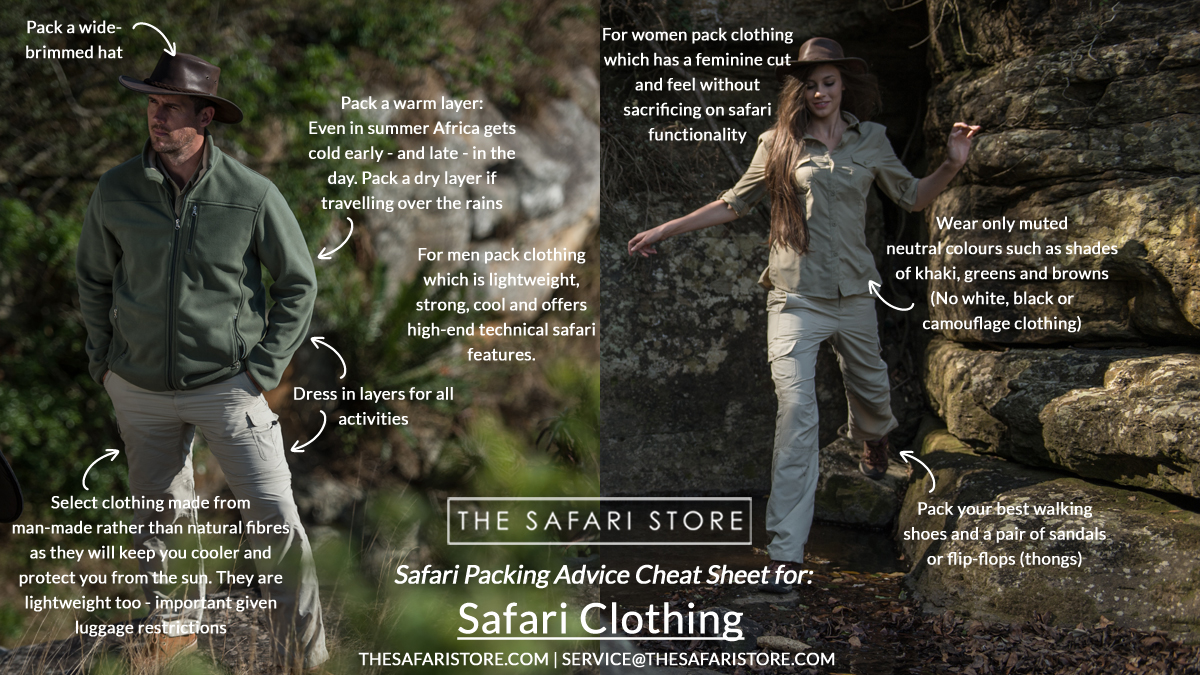
Women's Safari Clothing >
More Stories

Swarovski Optik

Safari Clothing Packing Advice: What clothing to pack for your safari.
This website uses cookies for it's shopping basket, you must have cookies enabled in order to use this site.

What To Wear On a Luxury Safari to Kruger National Park
Sharing is caring!
I was invited to visit Johannesburg, Kruger National Park, and Cape Town by South African Tourism, and when I found out I was going on a safari in Kruger National Park I immediately began researching clothes for a safari and what to pack for a safari.
After I read dozens of packing list articles on what to pack, what to bring, and what to leave at home I was still confused about what to wear to a safari.
I decided I needed to create a very detailed guide for what to pack for a safari depending on the season and time of year you visit South Africa.
Y’all know I had to be cute for those Instagram-worthy photos!
Deciding what to wear on safari really depends on the time of year and the weather.
The weather in Africa was nothing as I expected. I was under the impression it was going to be hot but NO, it was freezing!
Freezing! Freezing!
South Africa gets extremely cold and thank Gawd I checked the weather app because I would have been up a creek.
This was my first time visiting the continent so I am not sure what I expected but it definitely was not frigid temps. I will take the guesswork out of what you need to pack for this epic adventure.
The links in this post may be affiliate links. That means that if you click them and make a purchase, this site makes a commission. It will have no impact on the price you pay or the experience of your purchase.
I will cover what to wear on safari, what to bring on safari, what colors are appropriate for safari, as well as what you can probably leave behind at home.
Before you begin purchasing clothes for a safari you need to determine what time of the year you will be visiting Africa because that determines what you will need to pack.
Hopefully, I will answer all of your questions and this will be the only safari packing list you will need. Take your time and go through each section as the article is long but extremely thorough.
When is the Best Time to Visit the Kruger National Park?
The best time to visit the Kruger National Park is the dry season from May to September for the best game viewing and walking safari conditions.
Vegetation is low and sparse at this time of year, making animals easier to spot and track, while the permanent water sources offer a rewarding safari experience in the Kruger.
Generally considered a year-round destination, choosing exactly when to go to the Kruger depends on what you want to experience.
Kruger has two distinct seasons, the dry winter from May to October, and the summer rainy season from November to April. However, every day in the Kruger National Park is a one-of-a-kind safari adventure.
The best time to visit Kruger National Park is during the dry winter months from May to September.
At this time, the bush thins out, and animals congregate around waterholes and rivers. Conditions tend to get better as winter progresses, and September is particularly lovely since the mornings are less chilly than in mid-winter.
The best wildlife viewing time also coincides with the low season, making it even more attractive.
May to September (Dry season)
High Season
December to January and July to August (Especially during school holidays)
April to mid-June and September to November (Except for the October school holiday)
Best Weather
April to May and September to October (Mild weather and little rain)
Worst Weather
June to August (Chilly mornings and nights) and December to February (Hot and humid)
Now that we have discussed the weather and you have determined what time of the year is best for you to go on a safari let’s get to discuss what you need to pack.
The 7 Safari Outfits you will Pack for your First Safari
There are plenty of options for what to wear on an African safari but I suggest sticking with primarily khaki or olive colors.
The safari tours in Kruger National Park are viewed from within the confines of an overland truck or 4×4 car.
You will be driving around the bush all day in an open jeep so be prepared to get covered in dust.
With that being said understand that shirts, pants and shoes, and whatever else you may be wearing will get dirty and dusty.
- Note: It is illegal to wear Camouflage in Kruger National Park, so stick to your one-toned khaki clothing
P & G Recommended Safari Packing List
3 short-sleeve tops
2 long-sleeve tops
1 windbreaker jacket
1 fleece or warm jacket
2 bras
5 underwear
1 sunglasses
P & G Recommended Shoe List
1 pair of comfortable sneakers
1 Pair of hiking boots
1 pair sandals
Layers, Layers, and More Layers
As I said earlier if you are under the impression South Africa was warm all year round nothing could be farther from the truth. I realized this as soon as I landed in Johannesburg because it was chilly AF there and it only got colder as we traveled from Jo’Burg to Kruger National Park.
The temperatures dropped to a low of 30 degrees as soon as the sun started to set.
Game drives are timed for when animals are most active . Typically, this means leaving your room for a 2-4 hour game drive beginning at sunrise.
I chose not to do the early morning game drive because I hate being cold and I am not a morning person.
Once you return from the morning game drive you will return to the room for lunch and relaxation, followed by another game drive late in the afternoon.
The temperatures will begin to cool off as soon as the sun sets – it goes from feeling relatively nice out to freezing within a matter of minutes which is why layers are essential to pack for a safari in Kruger National Park.
A good packing list for safari will include both short and long sleeve cotton shirts to wear during the day, warm sweaters, and a light jacket to wear in the early morning hours and in the evenings.
I also recommend bringing a scarf, a hat, and gloves.
Safari Color Guide
Do colors really matter?
Yes, Game-viewing should be done by blending in with your surroundings which will enhance your experience.
Watching wildlife behaving naturally is the best way to see Africa’s spectacular wildlife. The color of your clothing can potentially scare off or disturb your sighting – something you want to avoid.
The best safari color is khaki followed by olive, tans, and browns because they are good at handling dirt.
Remember to keep it casual and comfortable with tee shirts, long-sleeved shirts, shorts, hiking boots, and athletic socks to keep the blisters away.
What Colors you Shouldn’t Wear on Safari
While Black is my favorite color it is not appropriate for a safari because not only does it stand out in the bush i f you are traveling to an area with tsetse flies they are attracted to black and blue colors.
The last thing you want to do is attract this dreaded fly – an insect with a painful bite – so much so that fly traps are made from blue and black fabric.
With the amount of dust in the bush, white is hardly recommended as it gets dirty very easily therefore w hen on a game drive, you are expected to blend in with the bush as much as possible.
Wear neutral colors, such as khaki, beige, taupe, or grey.
Having considered what to wear on safari, here’s a selection of the clothes I recommend for your safari packing list.
1. Cotton Tee’s (Long & Short)
While nights are cold when in the bush, days are actually warm and you will often be wandering around in a t-shirt.
Don’t make the rookie mistake I made on my first safari and only pick t-shirts in neutral colors.
You will want something that is super lightweight that can be washed in the sink and will dry quickly.
Khaki pants
Long pants and long-sleeved tops will keep your skin covered and protect you from the cold and wind, sun, and insect bites.
While many places in Africa can get really hot, remember that some can also get downright chilly and t his is especially true for Kruger National Park.
Long pants are especially useful if you’re going on a walking safari or a game drive where you’re allowed to sometimes exit the vehicle
Even though it was chilly I still decided on short Khaki pants instead of long. I suggest safari shorts that are comfortable, durable, and weather-resistant, and the color of course blends in with the environment .
While many articles I read said don’t wear shorts I decided to take a chance and needless to say I did not get eaten alive by mosquitos or any of the bugs for that matter.
I did spray on a ton of perfume like I was the old dude at the club.
Safari Light sweaters & Layering
As I have stated 5 additional times earlier in this article it gets really cold in South Africa specifically Kruger National Park.
The climate and weather in Africa range from one extreme to another, from extremely cold freezing nights to very hot and dusty afternoons.
Layering is very convenient in these situations. Your layering should include at least one warm layer especially if you plan to go on early morning game drives.
A warm jacket
Multi-functional jackets with various pockets and neutral colors are what you need.
With these, you can safely carry your small safari accessories such as a camera, pair of binoculars, guide books, etc. safari jackets are especially needed on the game drives.
A Scarf, a Hat, and Gloves
I also suggest a wide-brimmed safari hat as it will protect you from the heat and shield your eyes from the glare of the sun and enables you to see animals at a distance.
You may need a chin strap to keep the hat firm on your head. It would even be much better if you got a waterproof hat, it would shield you from both the rain and the sunshine.
If you happen to be traveling during the cold season, from May to August, I suggest packing a set of thermals to put on under your safari clothes so you can stay warm.
I traveled to Kruger in September and it was still quite chilly (Freezing at night).
Comfortable Shoes & Boots for Safari
Footwear is an item that should not be overlooked when packing for your safari. Leave your cute shoes at home for your safari unless you want to be limping by the end of the day.
Once you leave the lodge you will need something comfortable to withstand the African terrain and will not leave your feet blistered.
Safari Socks
The importance of a good quality well fitting sock is imperative on an African safari. Your feet will take a lot of punishment so choose your socks carefully.
Nice Sandals
Once you return to your room you will want to relax and put your feet up so I highly suggest packing a nice pair of sandals that you can also wear to dinner.
Pack a swimsuit and some casual clothing for around camp.
Additional Items you will need:
Mosquito repellent .
I didn’t see or get bit by any mosquitoes in Kruger National Park but I did spray a ton of mosquito repellent, wore the armbands and I lathered on citronella oil for extra precautions.
Sun Screen
You will also want to protect your skin from sun damage so make sure you apply sunscreen generously.
For the same reasons, make sure to also protect your eyes with a good pair of sunglasses.
A power bank
You will need it to charge your smartphone on the go. Make sure to also bring a plug adaptor too.
Jabulani Safari Lodge provided binoculars for its guest so I didn’t even need to purchase any so make sure you check with the lodge before you purchase any to make sure you need them.
If the lodge you are staying at doesn’t provide binoculars you won’t want to miss any hunting scene or any bird watching, so binoculars are another essential item for your safari packing list.
Camera vs iPhone
A safari is a content creator’s dream. I don’t think I have ever taken as many photos on any given day as I did during my safari trips.
I didn’t bring my big fancy camera but instead, I simply used my iPhone and my pictures look like they came out of National Geographic!
I just didn’t find it feasible to carry around a big camera when iPhone photos are equally as amazing. I have an iPhone 14 and the picture quality was excellent so if are eligible for an upgrade this is the time.
Toiletry bag
Last but not least is a toiletry bag because if you are anything like me I don’t leave home without my facial products so pick one that has multiple pockets and zips and that can be easily hung.
Documents you Must Pack
Losing documents is a very common occurrence, especially while traveling. As a result, packing the necessary documents safely should be your first priority before packing the rest of your luggage.
- A passport that has all of the necessary visas for every nation that your safari will visit or pass through.
- A small amount of cash, bank cards, and/or traveler’s checks are recommended. These days, you can also utilize e-wallet apps to avoid lugging around multiple credit cards and cash.
- Air tickets and travel vouchers for any pre-arranged organized safaris that have been purchased.
- Where necessary, vaccination certificates (yellow fever, mumps, etc.) will be provided. Some immunizations must be administered many weeks in advance (see Vaccinations needed for your African Safari).
- Medical treatment may include malaria prevention medications (see Malaria Made Simple) as well as any personal medications (also take your prescription in case of an emergency-your medication gets lost, wet, eaten by a baboon, etc).
- The specifics of your travel insurance policy Your policy number, as well as the contact information for claims and emergencies, will be provided.
- Prepare a copy of all of your important documents, including your airline tickets, travel insurance policy, immunization records, and records of prescriptions and prescriptions.
Where to Stay in Kruger National Park
Jabulani safari lodge – a luxury resort.
Jabulani Safari lodge is just breathtaking, only a short drive away from Hoedspruit Airport and you are literally in the South African Bush!
The style and ambiance of Jabulani exude luxury with hints of home. The main area features an elegant dining room and lounge that lead to an outside wooden deck lying beneath the shade of Leadwood trees.
This is where you will enjoy breakfast, lunch, and dinner daily while overlooking the waterhole.
The signature suspension bridge stretches gracefully over the river bed, connecting to the six Jabulani suites and Zindoga Villa which is how you will get to your room from the main area.
Camp Jabulani is a superbly luxurious safari getaway. It’s all rich wood furniture, crystal glasses, and silver service. The meals are feasts, the wines are fine, the lounge area has wireless internet, and the bushveld views from the wooden deck.
THE ROOM AT JABULANI:
This luxury South African Safari lodge has six suites which are secluded, with canvas walls that roll up to reveal the surrounding wilderness.
Each suite is air-conditioned and has a lounge area and fireplace for cold nights, an en-suite bathroom with a stone tub and glass-walled outdoor shower, and a plunge pool.
The beds are huge, with pure cotton sheets and draped mosquito nets. The larger Zindoga Villa which is the villa I stayed in has two individual suites linked by a lounge and serviced by a private chef, butler, and game ranger.
I have never walked into a building or room and been speechless until I walked into our suite. There were elephant towels on the bed and the attention to detail is just outstanding, even down to the little natural leaf-cut elephants on the flannels.
The view from our room overlooked the reserve where you could see animals walking past. Check out the full-length video of our room on my IG reel.
- Kapama Private Game Reserve supports a wide variety of wildlife
- Plenty of activities including game drives, guided walks, and spa therapy
- Exclusive accommodation consisting of six suites
- Accredited Relais & Châteaux property
- Elephant Experience is a once-in-a-lifetime opportunity
The contact numbers to make a reservation at Jabulani Safari are:
• Cape Town Reservations +27 (0) 21 794 9050 • Durban Reservations: +27 (0) 31 941 5945 • Johannesburg Reservations: +27 (0) 10 446 8045.
CAMP JABULANI RATES & POLICIES
- Rate Policy: Daily in USD
- Standard Room: from $6,489-$6,489 (USD)
- Suite: from $1,675-$1,675 (USD)
- Credit Cards: Credit Cards Are Accepted
- Reservation Policy: Reservations must be guaranteed with a credit card
- Included Meals: Full Breakfast Included
- Deposit Policy: 25% to confirm the reservation, 2nd 25% 60 days prior to arrival. Full prepayment is due within 48 hours of arrival.
- Camp Jabulani Cancellation Policy: 25% 31-60 days prior to arr, 50% 15-30 days, 100% 1-14 days
Alternatively, you can check availability and book online by clicking here.
Remember, there is no schedule at Camp Jabulani, no program with dictated times and activities. Instead, the management team will consult with you prior to your arrival to better understand your needs and schedule activities accordingly.
Some of Camp Jabulani’s amazing include the following:
- Daily elephant back safaris
- Safari drives in the Big Five private Kapama Reserve
- Visits to the Hoedspruit Endangered Species Centre
- Indulgent treatments in the outdoor Therapy Lapa
- Gastronomic delights at the hands of the masterful culinary team
- Hot air balloon excursions over the reserve
The lodge is easily accessible via road, via daily scheduled flights from Johannesburg, or via private charter flights.
Click here to book your stay at Jabulani Game Reserve!
MAKE A RESERVATION
View this post on Instagram A post shared by Tomiko Harvey | 50 + Luxury Travel Influencer (@tomiko.harvey)
DO YOU NEED TRAVEL INSURANCE?
I think most people have questions about where to go for medical care in an emergency. First, I should note that if you’re on spring break, chances are slim that you’ll be needing emergency care.
Still, better safe than sorry!
I can’t say this enough but please get insurance when traveling to South Africa! Even if you are only going on a short trip, you should always travel with insurance.
Have fun while visiting South Africa , but take it from someone who has racked up thousands of bucks on an insurance claim before, you need it.
Make sure to get your insurance before you head off on an adventure! I highly recommend Travelex Insurance.
Ready to plan your trip, grab my FREE Vacation Planner to help you plan your trip in the time it takes to watch your favorite TV show!
If you would like to buy me a coffee click here Passports and Grub click here!

ADDITIONAL ARTICLES FOR TRAVELING
Is Johannesburg Safe for Tourists
Is Cape Town Safe for Tourists
Is South Africa Safe for American Tourists
Have you been on a safari? Did I leave anything out of my packing list? Do you have any further recommendations on clothes for a safari? would love to hear your thoughts so leave me a comment on Facebook , Twitter , or Instagram .
ARE YOU ALSO ON PINTEREST?
Why not save this post to your Pinterest board for later? I am also on Pinterest so feel free to follow Passports and Grub boards and get the latest pin directly.
Similar Posts

How Safe is it to Visit Palermo, Italy?

7 Ways To Achieve Your Travel Goals For 2021

The Unforgettable 7132 Hotel: A Gem in Switzerland

Tigers for Tomorrow: A Walk on the Wild Side of Alabama

Best time to visit Phuket & Krabi Islands

The Best Luxury Picnic at Boschendal Farm
- Pingback: Jabulani Safari Reserve: Luxury Lodge in Kruger National Park
- Pingback: Best Romantic Getaways in South Africa [Updated December 2023]
- Pingback: Is Cape Town Safe for American Tourists (2023 Safety Guide + Tips)
- Pingback: Is Durban Safe for Travel in 2023 - South Africa Travel Advisory
- Pingback: Long Tail vs Short Tail Keywords: Your Guide to SEO Success
Leave a Reply Cancel reply
Your email address will not be published. Required fields are marked *
This site uses Akismet to reduce spam. Learn how your comment data is processed .

23 MUST-HAVE Items on your African Safari Packing List
- Updated on January 15, 2024
- No Comments

This post may contain affiliate links. If you click through and make a purchase, we may receive a commission (at no additional cost to you). As an Amazon Associate, we earn from qualifying purchases. Learn more about disclosures.
First trip to Africa? You’re in luck!
Having recently been on Safari in Tanzania, we can provide you with first-hand, reliable and up-to-date information on how to make your trip stress-free, with this ultimate African safari packing list.

Packing for your first safari can be a daunting task. It is not just about taking the essentials, but also understanding what to expect from this new and exciting experience.
Most people don’t realize that African safaris are not just limited to a few hours in the wild.
You need to be prepared for lots of travel, long drives, and a great deal of time outdoors.
If you want to know exactly what to take and the practical reasons WHY you need them, then you’ll find this safari packing list incredibly helpful!

Safari Clothing Essentials
The following list of safari clothing is based on the assumption that you will be sat in a vehicle for the majority of the day, which makes your safari packing list a tad easier.
Note: We are all for sustainable travel and find no need to splurge on expensive safari gear that will only be used once!
Tips for Safari Clothes Packing
- Material Choose clothing that is easy to pack, dries quickly, and wicks moisture away from the skin. Man-made fabrics (such as polyimide) perform better than natural fabrics (such as cotton) and keep you cooler.
- Laundry Services Laundry services are generally available at camps and lodges, so only pack what you need as luggage space is precious.
- Wear Earth Tones The African Tsetse fly is ferocious and is attracted to dark blue and black colors. With bites similar to horseflies, they can and will make your trip a living nightmare! Choose khaki green and brown colors where possible. It’s best to avoid pale colors as you will get rather dusty and dirty during the day!
- Organize Your Clothing Organizing your safari clothing makes life so much easier, particularly if you have onward travel to another destination. Use packing cubes to place your safari clothes on the top for easier access and less mess.
Read More: Riu Palace Resort Zanzibar – Our Honest Review
Clothing for your African Safari Packing List:
1. safari shirt.

If there is one thing worth investing in, it is a proper safari shirt. We were the only ones in our camp that didn’t get bitten to bits by those relentless tsetse flies!
Tsetse flies can bite through thin or penetrable fabric, and a quality safari shirt will prevent them from doing so.
The best safari shirts will have built-in anti-insect treatment.
You can thank us later…!
2. T-Shirts
Layering is key to keeping warm and/or cool. Wearing t-shirts (under your shirt) also means you only need to fork out on the one expensive safari shirt.
3. Boots or Shoes
You don’t need specific safari boots or shoes and you certainly don’t need to spend a fortune on them. As you’ll be in the vehicle all day, a sturdy pair that you can wear with socks (that you can tuck your pants into) will do just fine.
When you’re walking around camp you won’t want to wear open-toe sandals, especially once you’ve seen all the sunspiders scattering around! Eeeek!
4. Safari Hat

Don’t forget your safari hat! You want full coverage – preferably one with a large brim that keeps your face and neck in the shade. Even with a pop-up roof, the sun will still manage to beat down on you, and it’s one heck of a sun!
Tip: Make sure your safari hat fits you snugly or has a neck cord – your rides will pick up speed and you don’t want to lose it with an unexpected gust of wind!
We love this packable safari hat that always bounces back to life (in featured photo).
5. Safari Pants
Long, lightweight, and enough to cover up those legs but not too hot or bulky. You’ll be sitting for a large proportion of the day so they’ll need to be comfortable.
You probably won’t want to wear shorts after you’ve encountered those tsetse flies.
Read More: The Lodge in Ngorongoro that has Spectacular Views
Lightweight, comfortable, and preferably water-resistant. Early starts can get chilly, so don’t be fooled – even if you’re the hardiest of people!
African Safari Packing List Essentials
7. soft-sided luggage.

If you’re traveling on bush flights you’ll be limited to 15kg on your luggage, plus you’ll need a soft bag (no hard suitcases allowed) that can be stuffed onto small planes. A duffel bag is an essential item to get your safari packing list going!
8. Packing Cubes

If you’ve never used them before, you’re in for a treat! Packing cubes made life so much easier on safari!
These provide the perfect way to organize your clothes and toiletries. Plus, you’ll be able to quickly see what’s in them which makes it easy when you’re looking for something specific without having to unpack everything. A total game-changer for organized travel!
Note: Plastic bags are now banned in many African countries and will be confiscated at airports. Sealable silicone bags are a perfect alternative for your leaky toiletries.
9. Universal Travel Adapter

Be sure to bring the correct travel adapters for Africa so you can charge your essential batteries. There are two types of outlets, European and British – this universal travel adapter will have you covered in any eventuality!
10. Insect Repellent
It’s important to keep biting insects away from you, both during the day and at night. They can carry dangerous diseases such as malaria, so don’t be tempted to leave this out.
The best type to use is one that can be sprayed over clothing. I know this may sound peculiar, but that’s what they all do in the bush!
Choose a natural repellant that does not damage clothing – this is the insect repellent we used and our safari guides absolutely loved it!
11. Tiger Balm

African tsetse flies have a nasty bite on them. This tiger balm will help take the edge off any itchy or swollen skin and should not be missed off your safari packing list. We first discovered this in Thailand and it’s by far the best relief for insect bites
12. First Aid Kit
Remember that you’re a while away from any emergency medical care. A simple first aid kit can take the stress out of any minor accidents along the way. Plus, you won’t have to rely on calling the staff to your tent at night if you have your own kit.
13. Sunscreen
Being so close to the equator means that you’re going to be exposed to a lot of UV radiation. Pack sunscreen and wear it when outdoors, even when you think you don’t need it.
On our first day, we thought the pop-up roof in our vehicle would provide enough protection from the sun – we were very wrong!
Read More: How we found The Best Safari Tour Guides in Tanzania
14. Sunglasses
UV protection is essential in Africa! Protecting yourself from intense sunlight will make your safari experience so much more comfortable. If you want to avoid squinting all day, then sunglasses are a must!
15. Flashlight

It gets pretty dark at night when you’re in an environment with zero light pollution. Most camps should provide you with a flashlight, but we would always err on the side of caution and have one handy.
16. Mosquito Net
It goes without saying that tented camps will lack any air-conditioning that ordinarily keeps mosquitos at bay! Check if your accommodation provides mosquito nets around beds before you book, if not – take one with you.
17. Power Bank

A power bank is essential if you’re on safari for more than a day. It’s always handy to have an external charger that can work anywhere in Africa.
Most safari vehicles will have USB ports that can be used with charging cables, but if you’re staying in tented camps then I wouldn’t rely on charging anything too quickly!
18. Selfie Stick
Wait, I know what you’re thinking… selfie sticks are soooo NOT on-trend!
But when you’re up close to a pack of lions feasting, or that cheetah that’s slowly walking behind your vehicle, you’ll be incredibly pleased you had something that could reach around to capture the all-important moment (rather than hanging your arms out of the jeep!)
19. Anti-Diarrhea Tablets
Being on the go in Africa can result in some stomach upset, so it’s best to have a supply of anti-diarrhea tablets with you. The last thing you need is for your bucket list safari trip to be ruined because you can’t part with the bathroom!
20. Binoculars

Check whether your safari vehicle provides a sufficient number of binoculars for all travelers.
If not, you might want to bring your own as there’s nothing quite like hurrying up the person next to you so you can cop a look at the action!
21. Microfibre Towel

These smart microfibre towels are light and packable for when you’re not staying in a hotel. They dry quickly too and won’t cause a stench when you’re on the go!
22. Toilet Paper/Wipes
Depending on your safari destination, there may not be any bathrooms within a 2-hour radius, so be prepared by packing toilet paper/wipes and hand sanitizer! These are absolutely essential items for your safari packing list!
23. Anti-Malaria Tablets
There is a risk of malaria in most parts of Africa. Speak with your travel clinic about the pros and cons of taking anti-malarial tablets, sometimes the side effects can be off-putting if you have existing medical conditions or a sensitive tummy.
You may decide that taking the tablets is not an option and therefore need to re-evaluate whether an African safari is the right choice for you.
Read More: How Plan an Affordable Serengeti and Ngorongoro Safari
Other Handy Safari Packing Tips:
- Take sufficient cash You may be surprised to hear that there are no ATM machines out on safari! Make sure you bring enough cash for the duration of your safari for souvenirs, additional snacks, drinks at your camp/lodge, and tips for your safari guide
- Drones Drones are not allowed by any camps in East Africa due to the effects they have on wildlife (and also for security reasons)
- Hairdryers Hairdryers and other powerful appliances generally cannot be used if you’re staying in tented camps as electricity is scarce
- Avoid any military/camo clothing It’s a safari, not the SAS! Just kidding. The real reason to avoid military-style clothing is that it may land you into trouble in some territories, especially in Kenya. Governments are wary of anyone posing as a military officer and will question your intentions. A situation we would all just rather avoid!
READ: Zanzibar Travel During Covid-19 – What You Need To Know
Your Safari Packing List Covered!
Packing for a safari can be stressful, especially if you have no idea what to expect.
Hopefully this African safari packing list will help to make your experience as stress-free as possible, so that you can focus on making great memories instead!
You may also be interested in our post about Safari Anxiety: 19 Things That Freak People Out
Further Reads:
- Things People Worry About on Safari
- How to Save $$$ on an African Safari
- 9 Luxury Safari Tented Camps in Serengeti
Related Posts

African Safari Anxiety: 19 Things People Worry About!

Riu Palace Zanzibar Review: Best All-Round Luxury Hotel

Roy Safaris Review: Best Tour Operator in Tanzania?

11 Smart Tips: How to do Affordable Luxury Travel
Luxurious destinations are little to do with how much they cost and everything to do with how they make us feel – long after the journey ends. That’s the essence of Roaming in Luxury. We’re a group of people who have mastered the art of LuxVenturing – a blend of adventure and affordable luxury travel. Our aim is to share our insights, resources, and stories, so you can focus on crafting the best, most affordable luxury experiences on your own travels. Read more about us…

Leave a Comment Cancel Reply
Your email address will not be published. Required fields are marked *
Remember Me
Become a Luxventurer with us!
Don’t miss out on the thrill of luxury adventure! Sign up for our newsletter and get insider tips, exciting destinations, and inspiration for your next luxurious adventure, all delivered straight to your inbox.

Quick Links
- Cookie Policy
- Privacy Policy
- Terms of Service
Search the site
Copyright © 2024 Roaming in Luxury | All Rights Reserved

Unlock the Secrets of Affordable Luxury Travel!
Are you an adventurer with a taste for comfort? Join our newsletter and receive weekly tips on experiencing luxurious destinations without breaking the bank.
JavaScript seems to be disabled in your browser. For the best experience on our site, be sure to turn on Javascript in your browser.

- Quick Order
- Create an Account
Can't find what you are looking for? Please contact Angie McCluskey at [email protected] for your custom needs.

Sign Up for special offers and promotions
Featured Products

Your cart is empty

- Open media 1 in modal
- Open media 2 in modal
- Open media 3 in modal
Let's Trip 6M Safari Jeep Hoodie - Black
Couldn't load pickup availability
Shipping & Returns
As this is a one time release we cannot offer returns or exchanges once ordered, all sales are final. Shipping and taxes are non-refundable.
Please allow 5-18 days for processing before shipping.
- Choosing a selection results in a full page refresh.
- Opens in a new window.
Explore the Jeep® Collections
Get ready for adventures with our t-shirts, jackets, trousers and accessories.
Enhance the adventure. Extend the experience.
Seek and discover everything the great outdoors has to offer with JXP.
Purchase by category
Find the right garment for your next adventure

XTREME XPEDITION
What to Wear for Jeep Safari
Welcome to the Jeep Safari Rajaji National Park blog page. Embarking on a Rajaji National Park promises an exhilarating adventure through untamed wilderness and diverse ecosystems. Amidst the excitement of encountering majestic wildlife and exploring lush forests, one crucial aspect often overlooked is choosing the right attire. Dressing appropriately not only ensures comfort and safety but also enhances your overall safari experience. Here’s a comprehensive guide on what to wear for your jungle safari in Rajaji National Park:

1. Light and Comfortable Clothing
Opt for lightweight and breathable clothing to beat the heat and humidity of the jungle. Cotton and moisture-wicking fabrics are ideal choices as they allow air circulation and help keep you cool and dry throughout the safari. Loose-fitting shirts, t-shirts, and trousers are preferable to tight-fitting garments, allowing freedom of movement during the adventure.
2. Neutral Colors
Blend into the natural surroundings by choosing earthy and neutral-colored clothing. Shades of khaki, olive green, brown, and beige are ideal as they help you camouflage with the environment and reduce the chances of startling wildlife. Avoid bright colors and bold patterns that may attract unnecessary attention or disturb the animals .

3. Long-sleeved Shirts and Pants
Protect your skin from sunburn, insect bites, and scratches by wearing long-sleeved shirts and pants. Lightweight, long-sleeved shirts shield your arms from the sun’s harmful rays and offer protection against pesky mosquitoes and other insects. Similarly, trousers or cargo pants provide coverage for your legs while allowing ample ventilation to prevent overheating.
4. Sturdy Footwear
Choose sturdy and closed-toe footwear suitable for walking on uneven terrain and rugged trails. Comfortable hiking boots or trekking shoes with good traction and ankle support are recommended to navigate through the jungle’s diverse landscapes safely. Avoid open-toe sandals or flip-flops that leave your feet vulnerable to injuries or insect bites.

5. Hat and Sunglasses
Shield yourself from the scorching sun and glare with a wide-brimmed hat and sunglasses. A hat not only protects your face and neck from sunburn but also helps keep you cool by providing shade. Polarized sunglasses with UV protection reduce eye strain and enhance visibility, allowing you to admire the park’s breathtaking scenery without squinting.
6. Rain Gear
Be prepared for sudden downpours or unexpected showers by carrying lightweight rain gear such as a poncho or waterproof jacket. The weather in the jungle can be unpredictable, so having a waterproof layer ensures you stay dry and comfortable throughout the safari. Pack a compact umbrella or a rain cover for your backpack to safeguard your belongings from getting wet.

7. Insect Repellent
Apply insect repellent with DEET or other effective ingredients to deter mosquitoes, ticks, and other biting insects. Mosquitoes are prevalent in humid jungle environments, especially during dawn and dusk, so protecting exposed skin with repellent is essential to prevent insect-borne diseases such as malaria or dengue fever.
8. Layering for Temperature Variations
Rajaji National Park experiences diverse microclimates, with temperatures fluctuating throughout the day. To adapt to these changes, consider layering your clothing for added versatility. Start with a lightweight base layer that wicks moisture away from the skin, followed by insulating layers such as a fleece jacket or sweater. Outer layers like a windproof or waterproof shell protect against wind, rain, or sudden temperature drops. This layering system allows you to adjust your clothing according to the weather conditions, ensuring comfort and warmth during chilly mornings or cooler evenings.

9. Minimalist Accessories
Keep accessories to a minimum to avoid unnecessary distractions or discomfort during the safari. Opt for a small backpack or waist pouch to carry essentials like water, snacks, sunscreen, and a camera. Avoid wearing excessive jewelry or accessories that may get caught on branches or thorns while trekking through the jungle. A lightweight scarf or bandana can come in handy for protecting your neck from the sun or wiping away sweat on hot days.
10. Respectful Attire for Cultural Visits

If your safari includes visits to local villages or cultural sites near Rajaji National Park, dress respectfully to honor local customs and traditions. Modest clothing that covers shoulders, knees, and cleavage is appropriate out of respect for conservative cultural norms. Avoid wearing revealing or provocative attire that may cause offense or discomfort to the local community. By dressing respectfully, you show appreciation for the cultural heritage and values of the region you’re visiting.
By dressing appropriately for your jungle safari in Rajaji National Park, you not only enhance your comfort and safety but also respect the natural environment and wildlife around you. Remember to pack essential items like sunscreen, water bottles, and a camera to capture unforgettable moments amidst the wilderness. With the right attire and preparation, you’re all set to embark on an unforgettable adventure through the heart of Rajaji National Park, where every step brings you closer to nature’s wonders.

FAQs About What to Wear for Jungle Safari
1. what is a jungle safari.
A jungle safari is an adventure activity that involves exploring the wilderness of a national park or wildlife sanctuary in a specially equipped vehicle, such as an open jeep or safari bus. Participants have the opportunity to observe wildlife, birds, and natural landscapes in their natural habitat under the guidance of experienced safari guides.
2. How do I book a jungle safari in Rajaji National Park?
To book a jungle safari in Rajaji National Park, you can either visit the official website of the park or contact the park authorities directly. Online booking portals and travel agencies may also offer safari packages to Rajaji National Park, allowing you to reserve your safari in advance.
3. What types of safaris are available in Rajaji National Park?
Rajaji National Park offers several types of safaris, including jeep safaris, elephant safaris, and nature walks. Jeep safaris are the most popular option, allowing visitors to explore different zones of the park while seated comfortably in an open jeep. Elephant safaris provide a unique vantage point for wildlife viewing, while nature walks offer a more intimate experience of the park’s flora and fauna .
4. What should I bring on a jungle safari?
It’s essential to pack light but carry essential items such as sunscreen, insect repellent, a hat, sunglasses, a water bottle, a camera, binoculars, and a light jacket or raincoat. Wear comfortable clothing and sturdy footwear suitable for walking on uneven terrain.
5. Is it safe to go on a jungle safari in Rajaji National Park?
Yes, jungle safaris in Rajaji National Park are conducted under the supervision of experienced guides and trained naturalists who prioritize visitor safety. However, it’s essential to follow safety guidelines, stay inside the designated safari vehicles, and avoid approaching or disturbing wildlife. Respect park rules and regulations to ensure a safe and enjoyable safari experience.
6. What wildlife can I expect to see during a jungle safari in Rajaji National Park?
Rajaji National Park is home to a diverse range of wildlife, including tigers , elephants , leopards , deer , bears , monkeys , reptiles, and numerous bird species. While wildlife sightings are never guaranteed, the park’s rich biodiversity offers excellent opportunities for spotting various animals and birds in their natural habitat.
Leave a Comment Cancel reply
Save my name, email, and website in this browser for the next time I comment.

Safari Style: What to wear on a safari (without looking like a total nerd)

As soon as I hit ‘book’ on my dream trip to South Africa , a sudden panic set in.
What was I supposed to wear on a safari?!
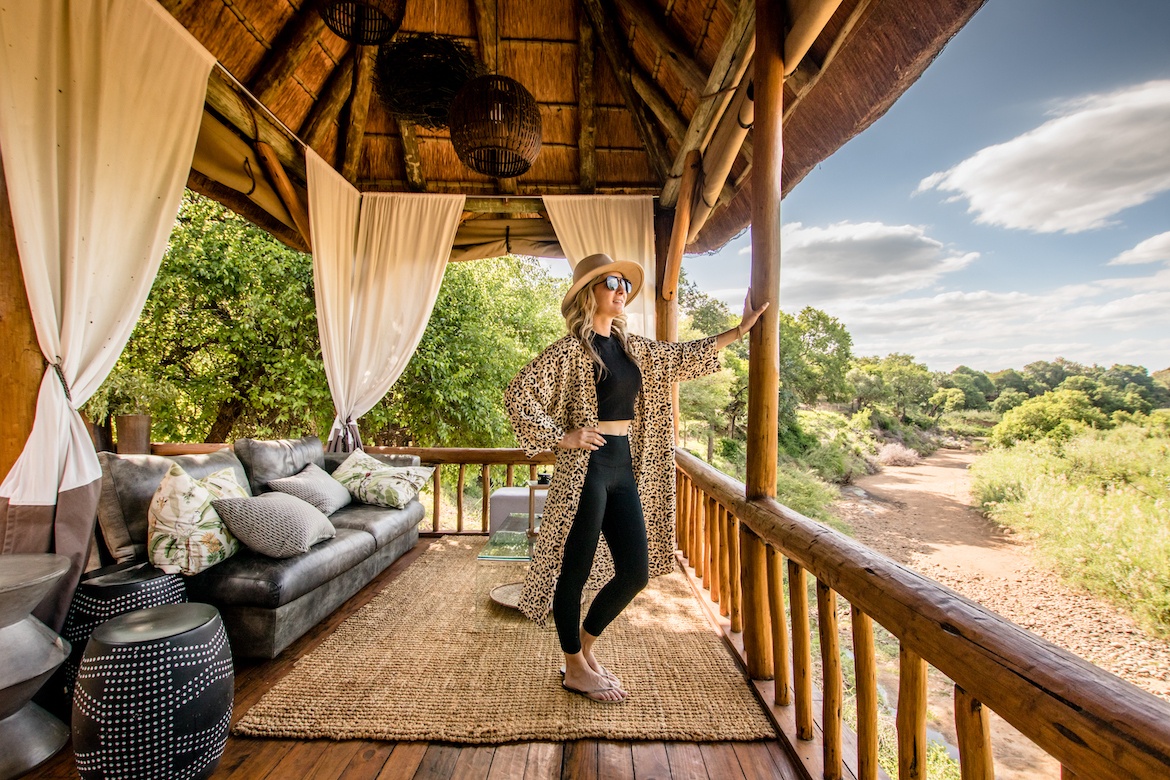
Visions of tourists clad in ill-fitting khakis and cringey bucket hats sprung to mind, and I was determined to try and look somewhat cute during the game drives while still being comfortable and prepared for the elements. And definitely NOT look like a huge nerd who was clearly on their first trip to Africa.
Spoiler alert: it turns out, you don’t need to overthink it.
Here’s everything you need to know about what to pack for an African safari.
Note: This safari packing list is based on your average game drive in a vehicle, and not for more adventurous activities like bush camping and gorilla trekking. Double-check what’s required with your tour operator beforehand if your itinerary includes anything more strenuous.
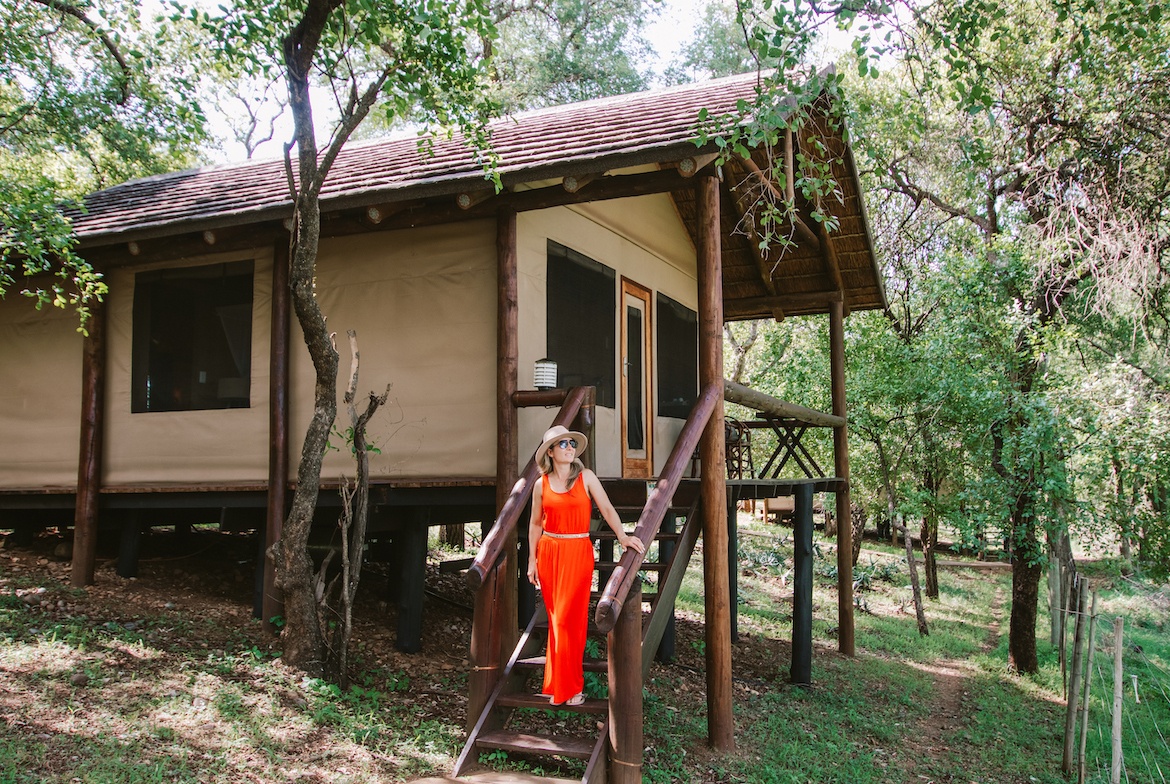
What to pack for a safari: Best clothing
While researching what to wear on an African safari, I came across a few articles that mentioned different reasons for avoiding pretty much every colour other than earth-toned hues like green, brown and khaki.
For example, black and blue can attract tsetse flies, while bright colours like red and white (which reflects in the sun) stand out to the animals and may make them react differently than if you’re blending into the surrounding landscape.
However, once I was actually in South Africa none of our guides ever mentioned a dress code, and let’s be honest: a huge jeep rumbling up with a load of tourists toting cameras is probably way more distracting to the animals than someone’s fuschia scarf.
You can pretty much wear whatever you feel comfortable in…such as this cheetah-print wrap I found at a store in Kruger National Park and obvs had to have:
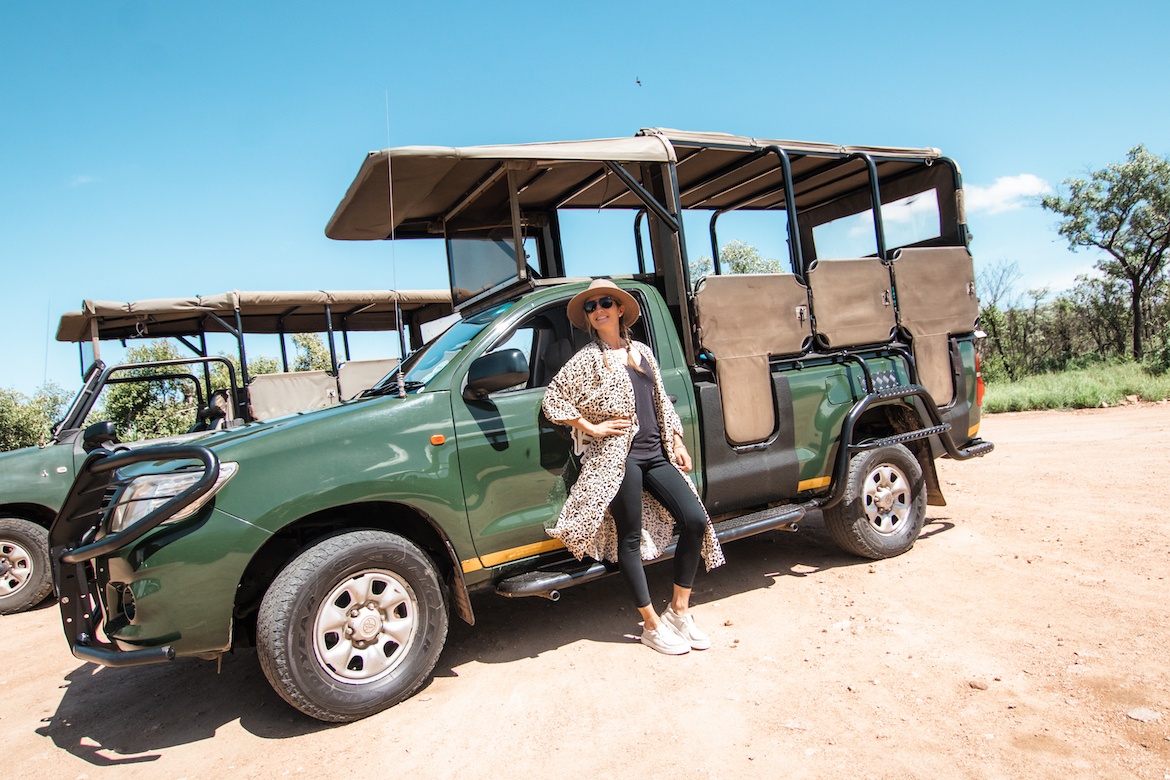
However, in some African countries it’s illegal for civilians to wear camouflage clothing, so it’s best to leave the fatigues at home.
The most important thing is to be prepared for the weather, by bringing layers like a t-shirt, long sleeve and light jacket since the weather can change quickly and you’ll be out for hours. Safari jeeps are mostly open and some don’t even have roofs, so you’re quite exposed to the elements whether it’s the hot sun or a sudden downpour.
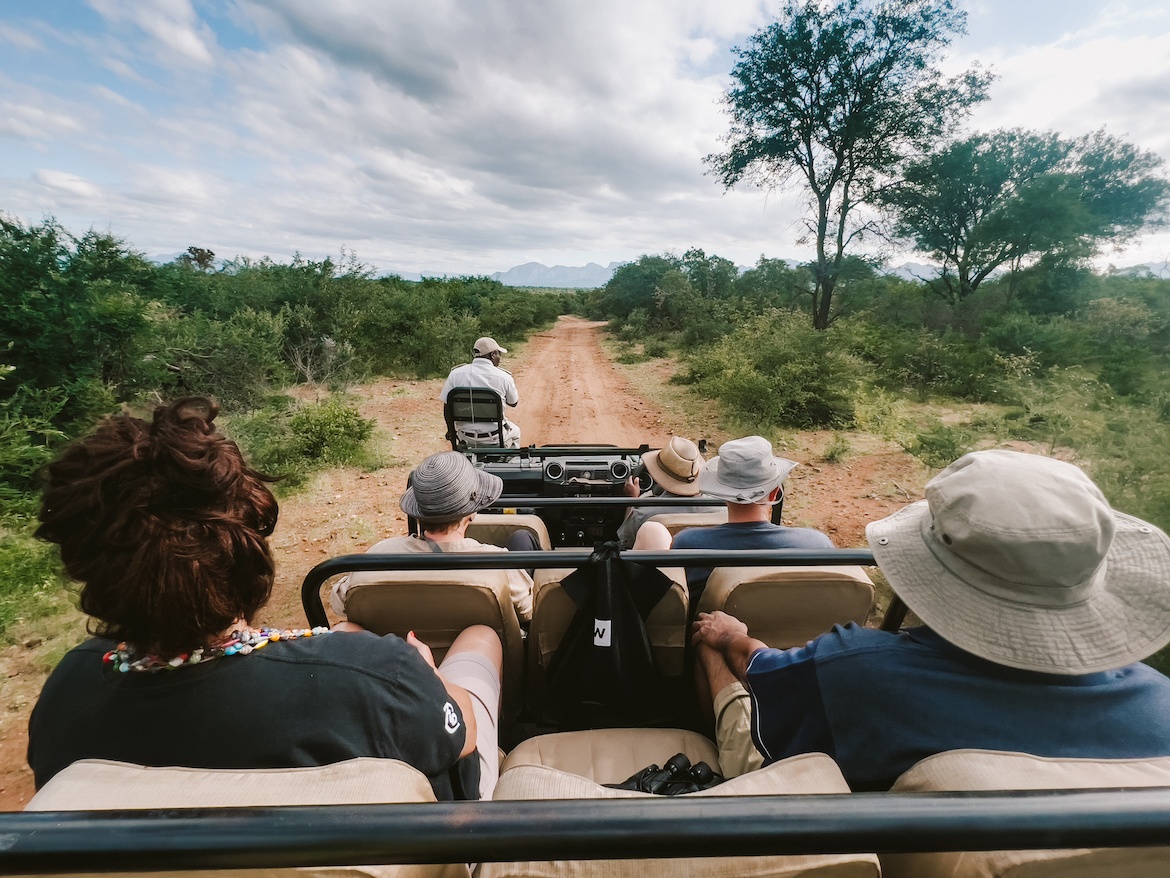
Also, many animals are most active at dawn and dusk, which is why most game drives happen early in the morning or in the early evening–hence, when it’s coldest. Yes, even in Africa. In summer.
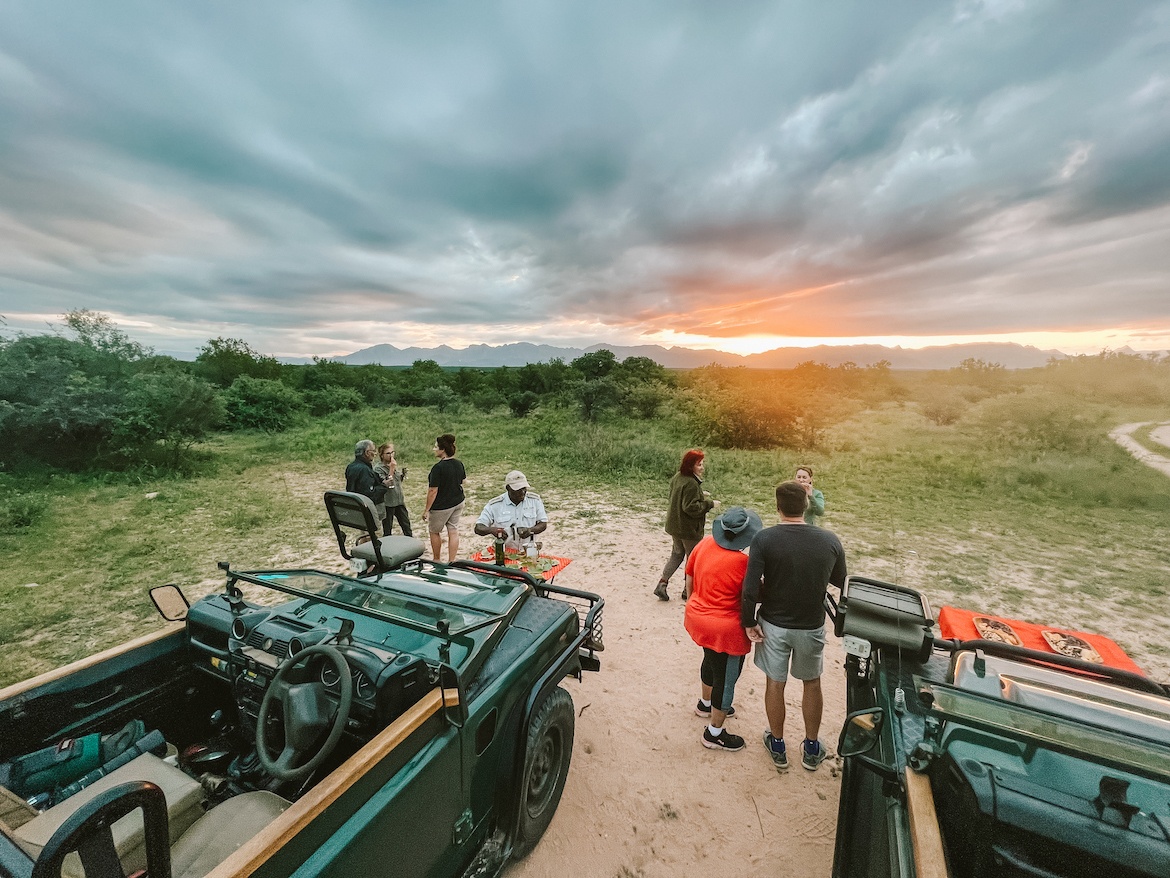
You might get chilled by the wind as your vehicle zips down a dusty road in search of an elusive leopard, then suddenly find yourself starting to overheat as you come to a standstill for several minutes under the blazing sun to watch a herd of elephants trounce through the trees, so layers are key.
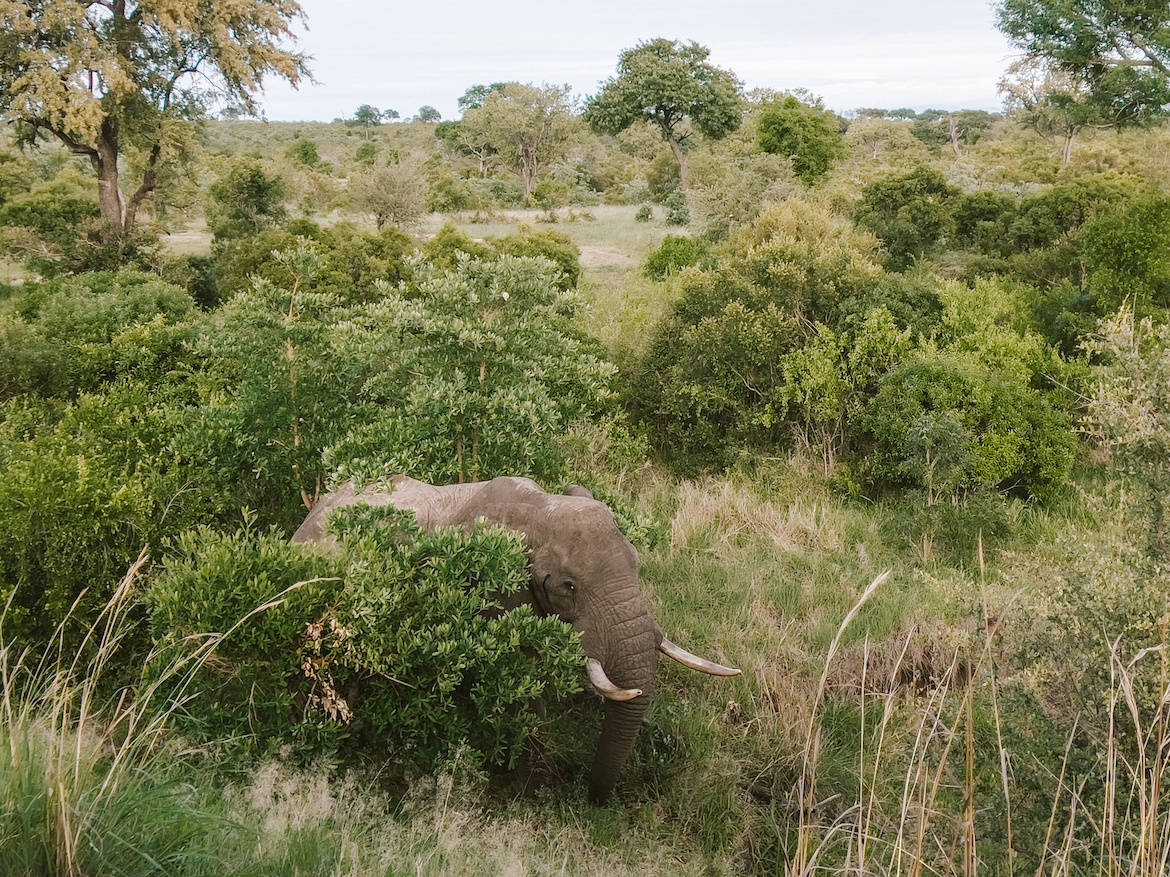
You’ll want shorts, pants or even leggings (again, comfort is crucial when you’re sitting all day), and for footwear runners or closed-toed shoes like Blundstones are best, though some people prefer sandals.
While footwear isn’t usually a big issue since you’ll mostly be confined to a vehicle, it’s best to be prepared for anything; one time, our guides suddenly motioned for us to get out of the jeep and follow them straight into the bush, where a trio of cheetahs were napping!
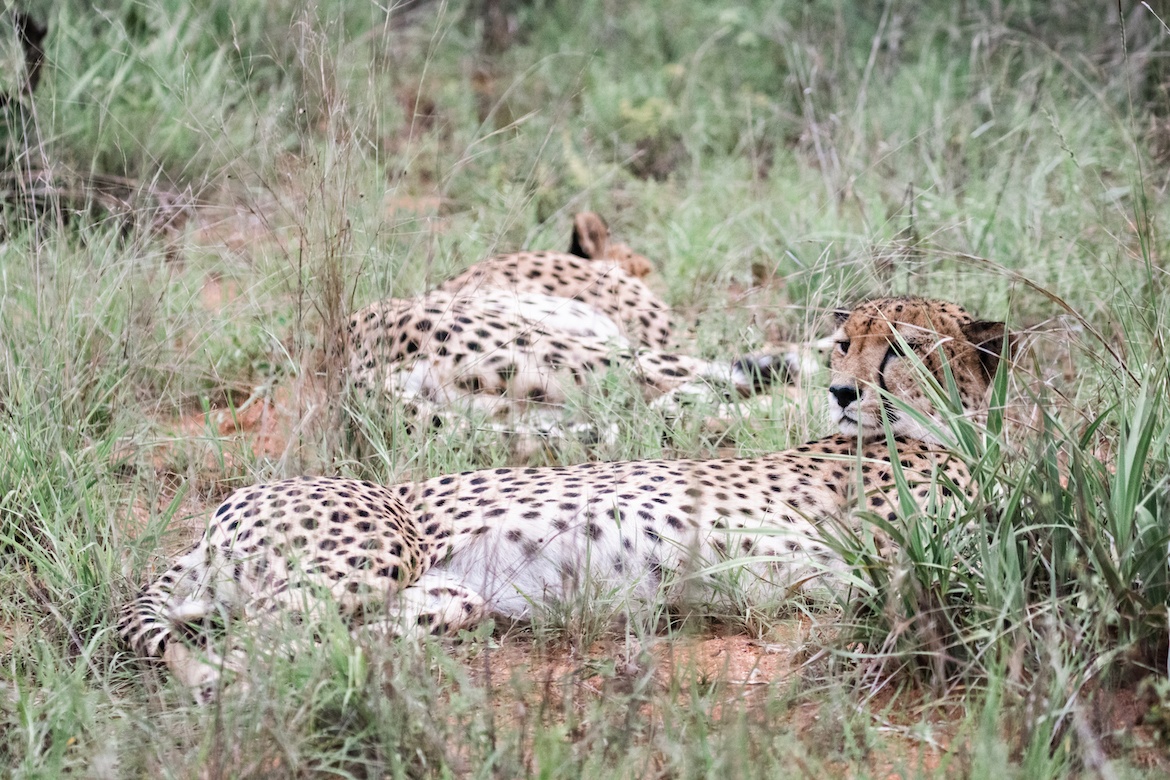
Ultimately, everyone on the trip is likely way more interested in zebra, rhino and giraffe sightings than your attire, so don’t get too stressed about your African safari outfits. In fact, trying too hard to bring the ‘right’ safari clothes can result in fashion fails, as evidenced by this unfortunate get-up I ended up in:
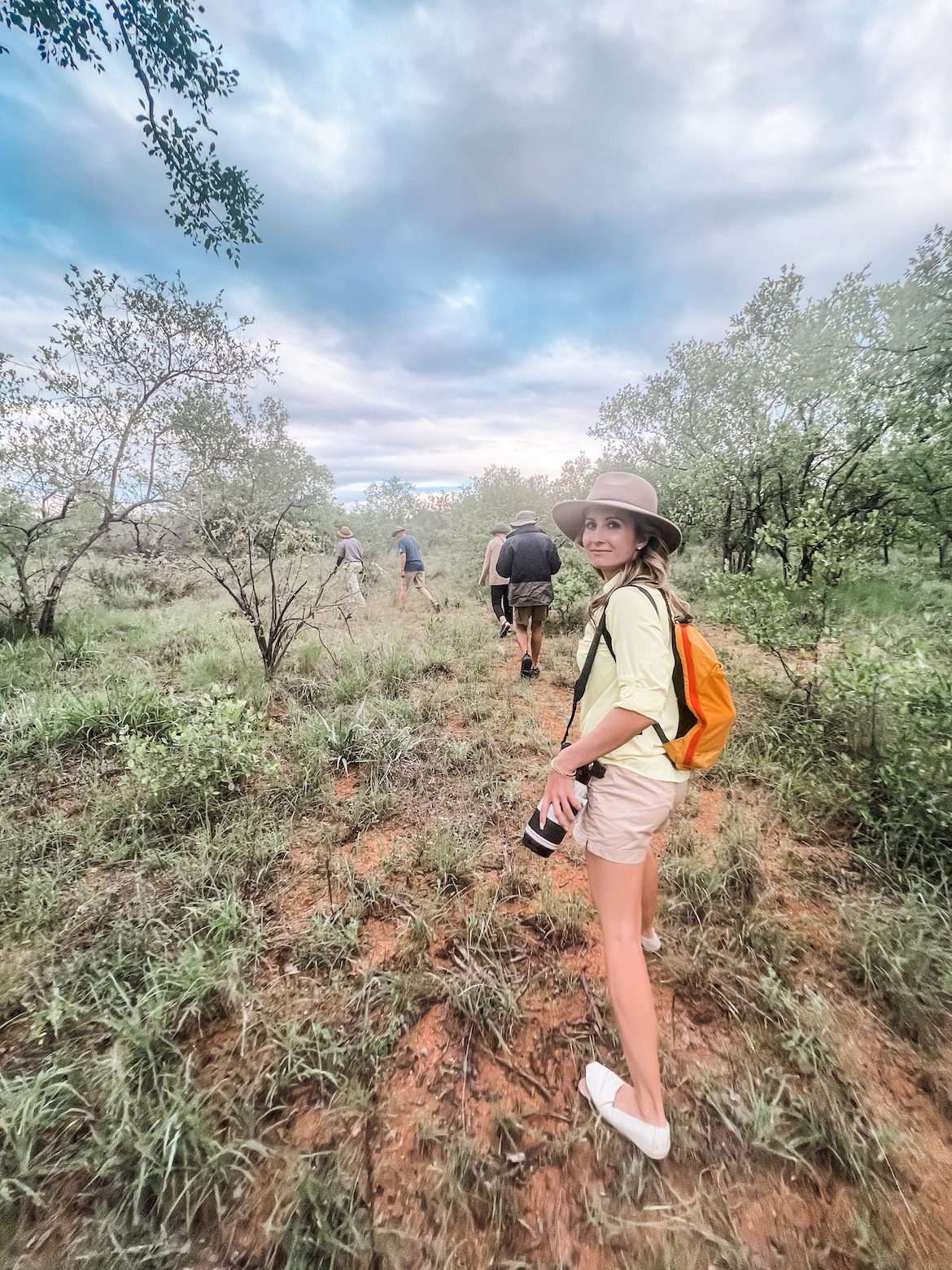
Learn from my mistakes, friends. Forget the super high-tech gear and just stick with the comfortable neutrals already in your closet.
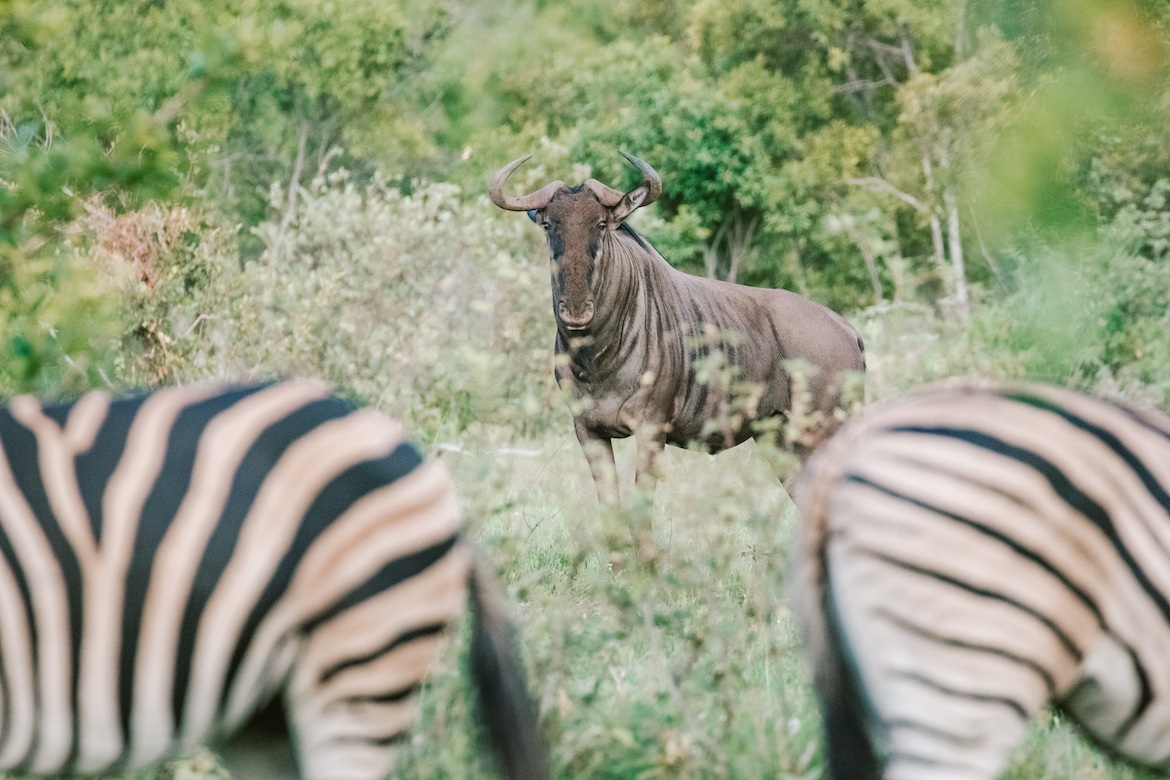
Safari essentials: Accessories
Sunglasses, sunscreen and mosquito repellent (like these carry-on friendly wipes ) are crucial to bring on safari, as well as a wide-brimmed hat. Try to get one with a string to keep it from flying off during drives–otherwise you’ll have to awkwardly hold onto it the entire time like yours-truly.
Because of that, I also brought a ball cap to wear while we were moving, and would throw on the more chic safari-style hat for photos because #Instagram.
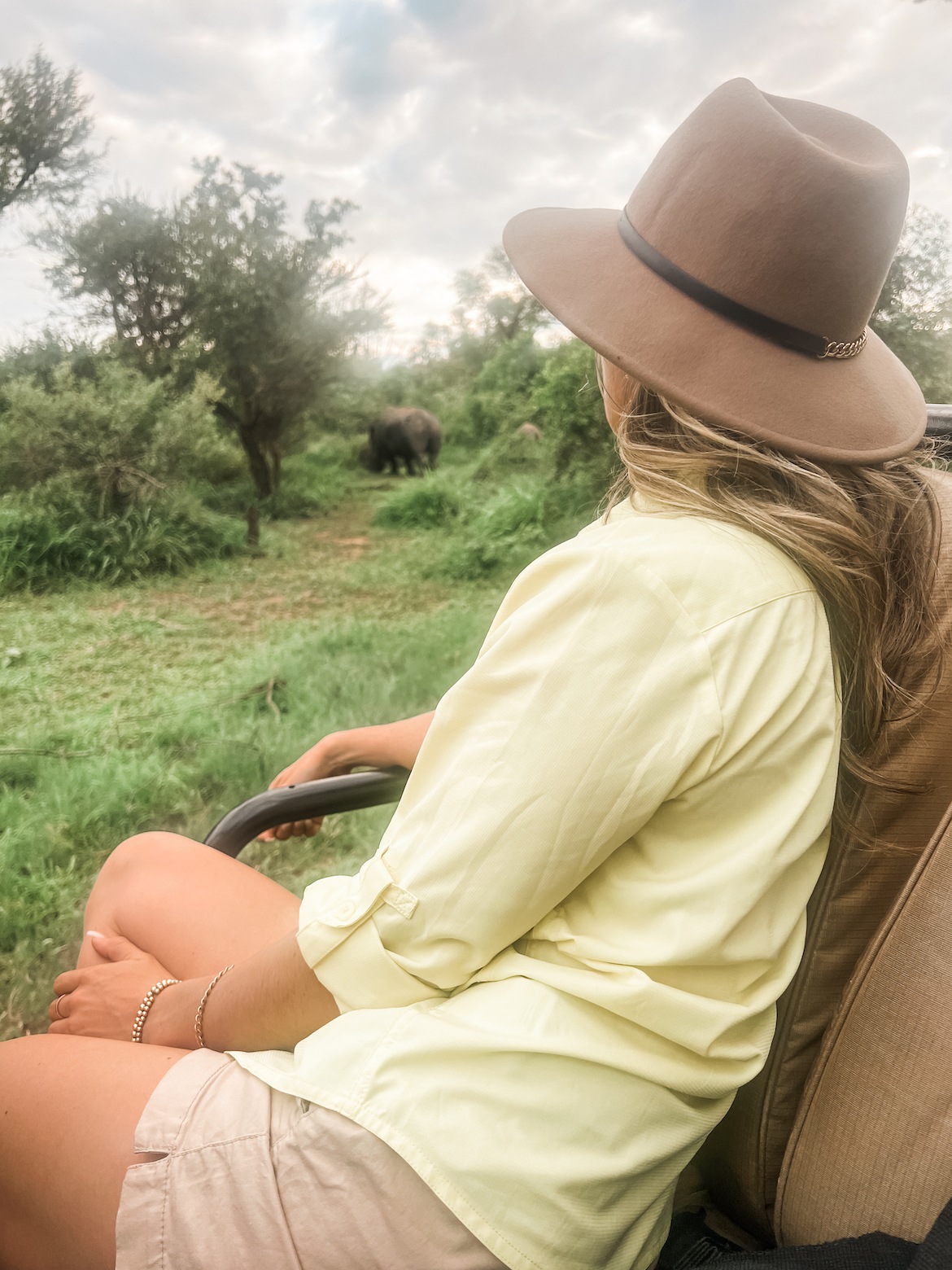
What to pack for an African safari also depends on which season you’re travelling in. A beanie (AKA toque, for my fellow Canadians) comes in handy during chilly morning game drives, and you might want to borrow a light blanket from the lodge or keep the crappy one that you’ll get from the airline on the long-haul flight over to cover your legs.
A scarf does triple-duty as a fashionable accessory, source of warmth, and can also be used to wrap over your face during a dusty drive.
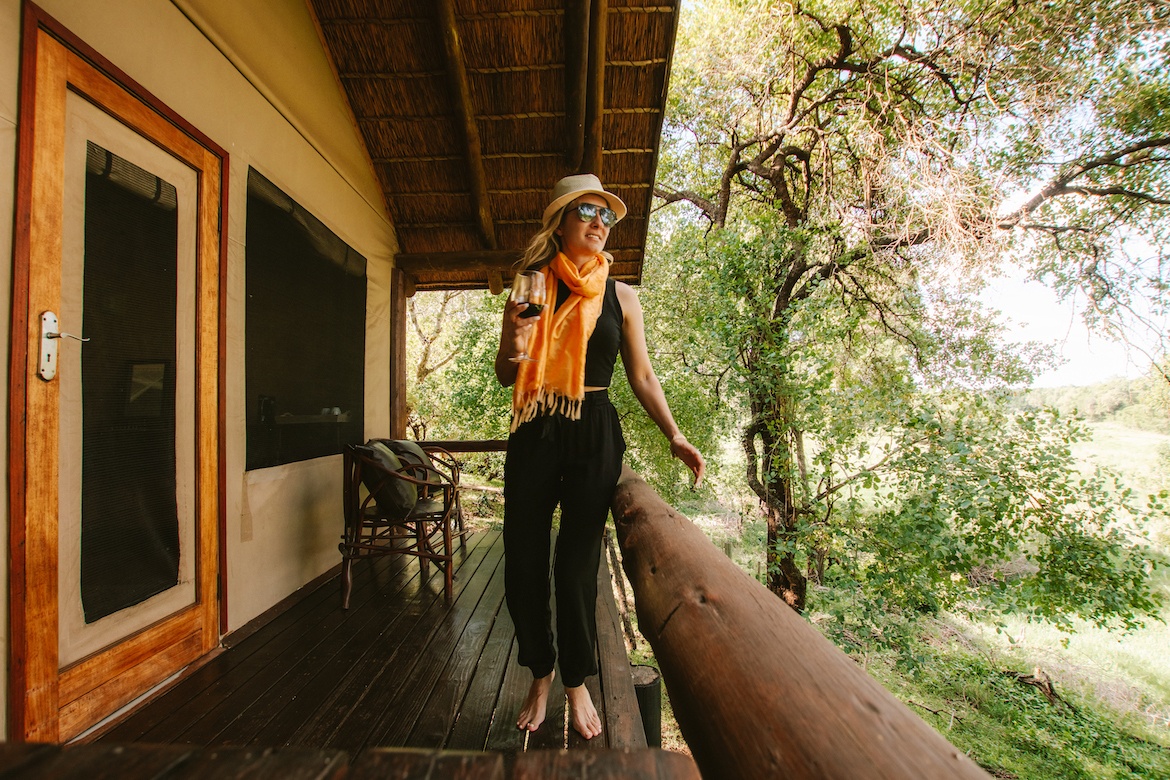
It goes without saying you’ll want a good camera, and ideally a long lens for close ups of leopards and lions hiding in the bush.
I rented a 100-400mm from a local camera store (buying one outright is NOT cheap, so I def recommend this route unless you’re a commercial photographer), and would have actually rented a 100-500 if they’d had one since the 400 sometimes still didn’t zoom in as close as I would have liked.
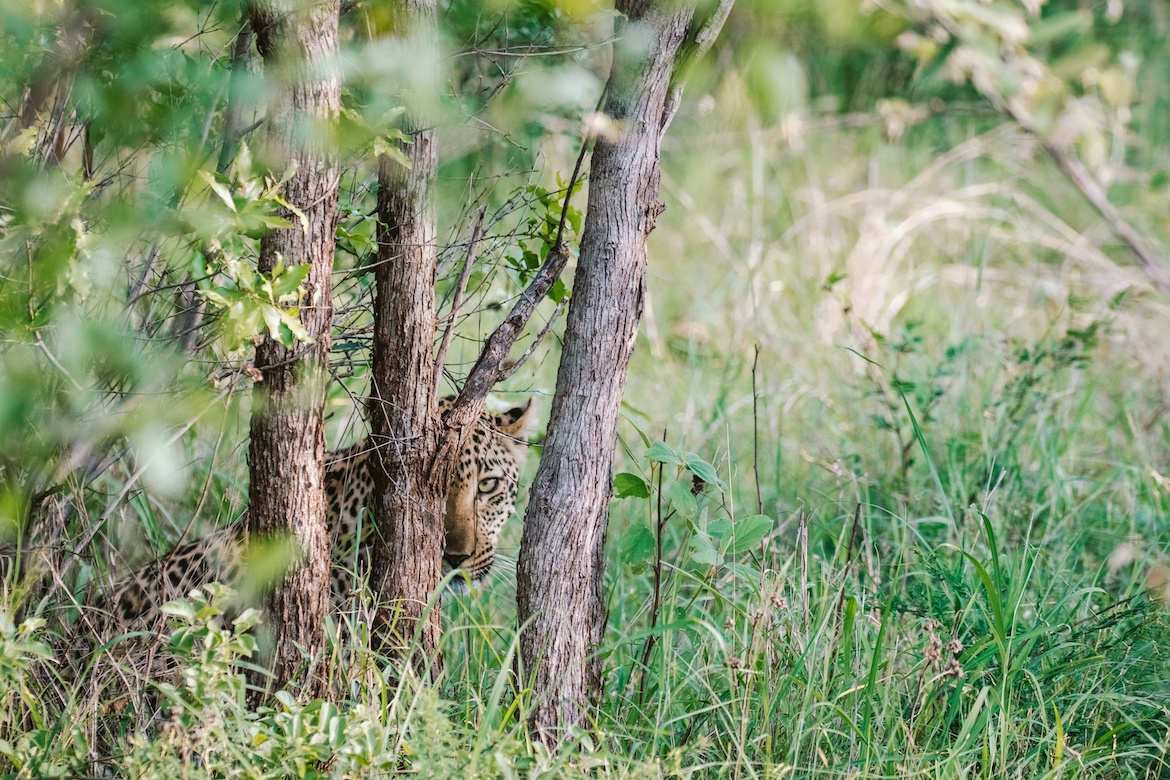
Pack extra camera batteries, as well as a portable charger like this one to keep your smartphone juiced up all day long.
Don’t forget a reusable water bottle to stay hydrated, and a small backpack (I’m obsessed with this clever, compact one ) to store all your gear. I was pleasantly surprised to find both vehicles I safari-d in (is that a word?) had a large seat pocket in front of each passenger to stash items, and I also kept a small bag tucked under the seat.
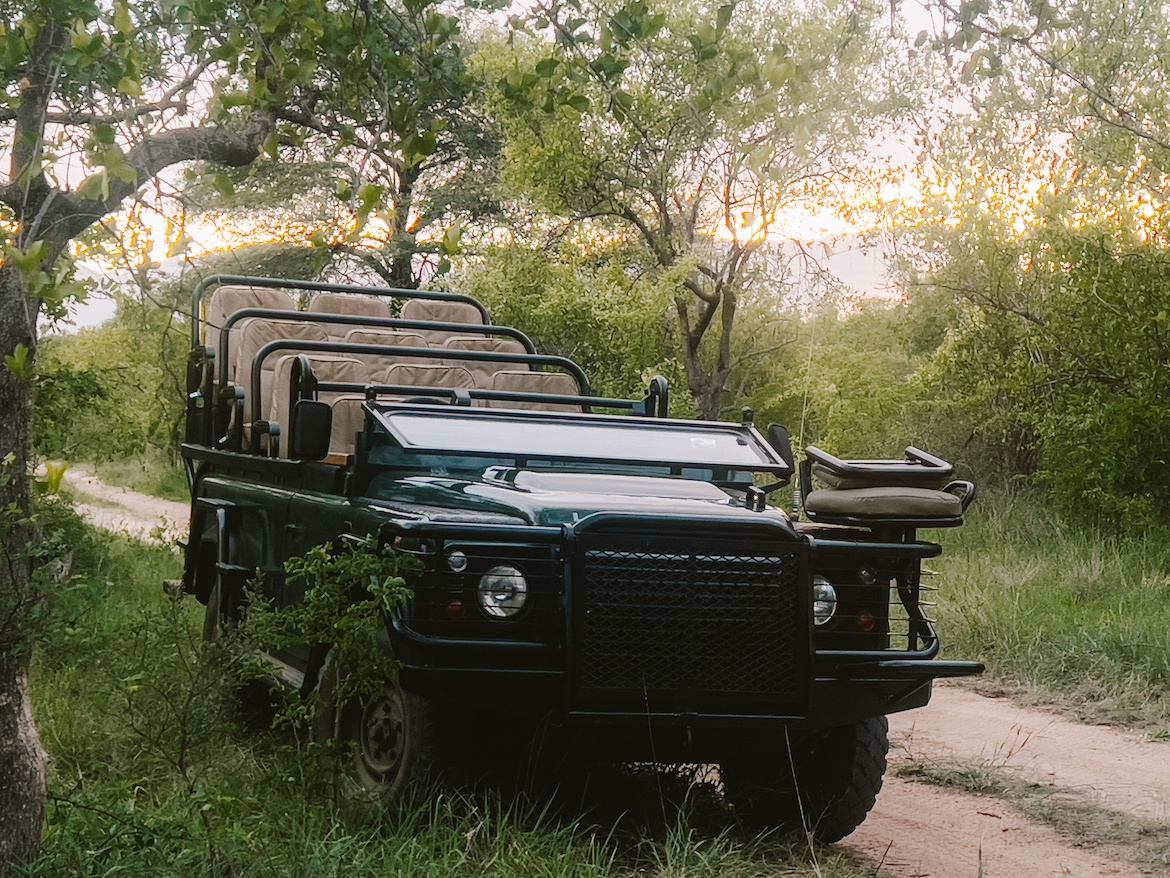
Safari packing list
- T-shirts/tank tops
- Long sleeved shirts/light sweaters
- Light jacket/raincoat
- Walking shoes such as runners
- Flip-flops for back at camp
Accessories:
- Camera (ideally with long lens)
- Small backpack
- Wide-brimmed hat
- Mosquito repellent
- Reusable water bottle
- Portable charger
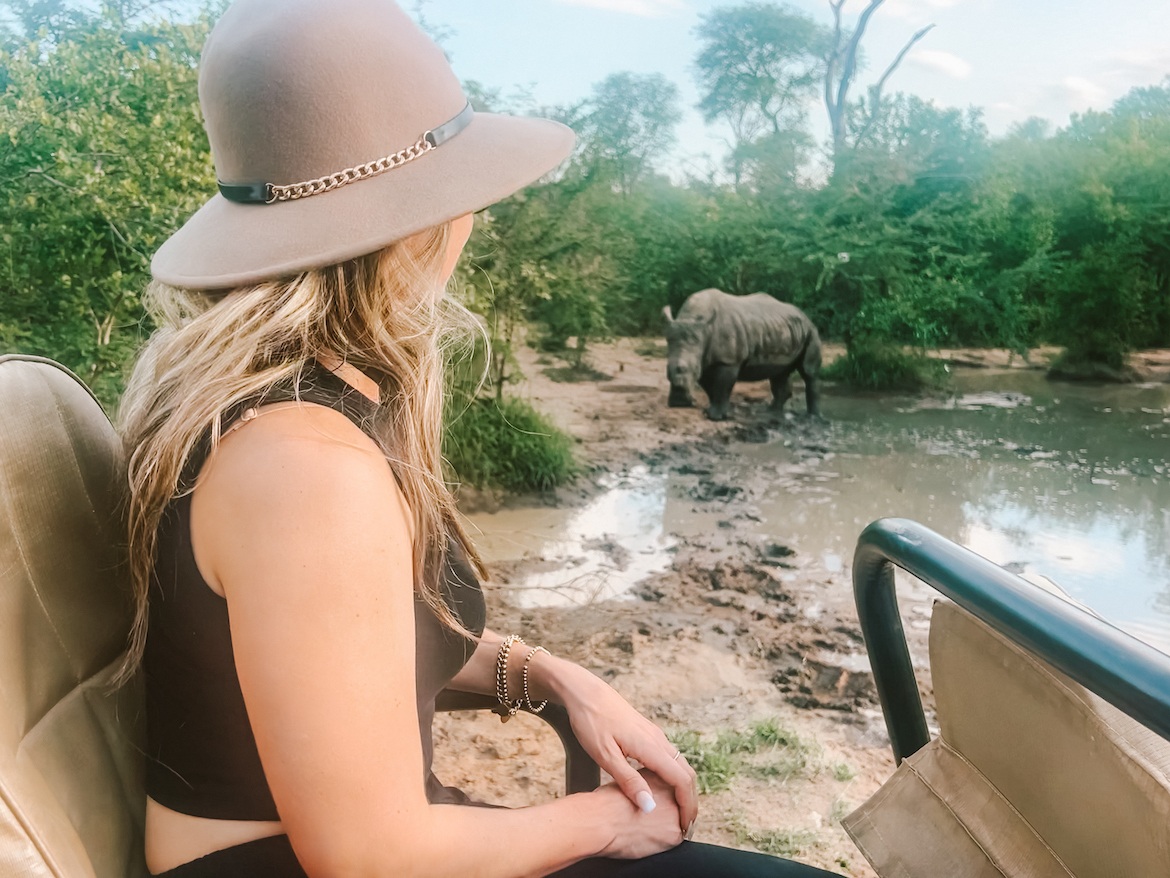
A final note about packing for a safari
While it’s natural to want to be prepared for anything, compact luggage is a must when travelling in some countries like Botswana, Tanzania, Uganda and Kenya where the remote lodges are often only accessible by a small plane. This means weight restrictions, and often only soft-sided bags are allowed so that the pilot can shove your stuff into the cargo hold.
I’m obsessed with my Beis Weekender Bag which holds an obscene amount of things and has a separate shoe compartment, and here are a few other affordable options:

Also, y’all know packing cubes are an absolute game changer, which will help you squeeze more Africa safari clothes into that carry-on.
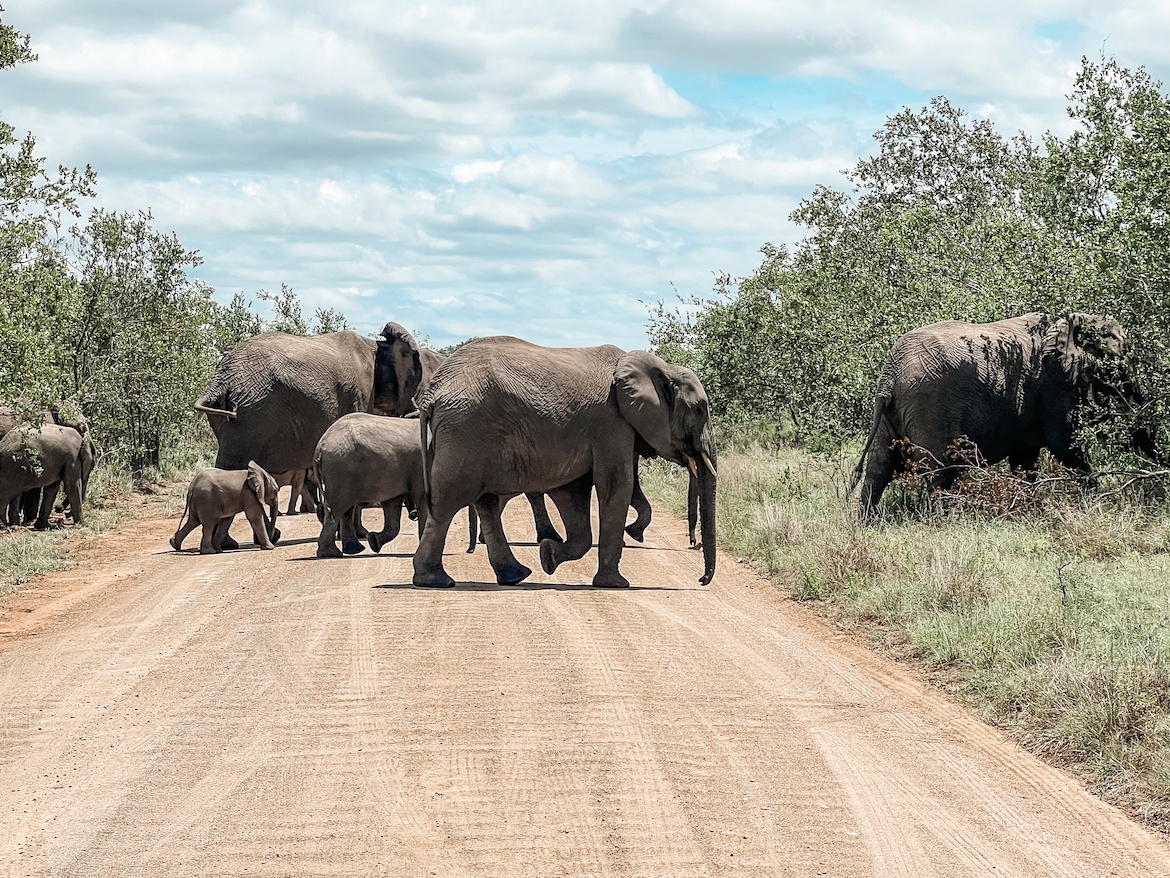
YOU MIGHT ALSO ENJOY:
- Globe Guide’s tried and tested, all-time favourite travel accessories
- A bucket list-worthy, 2 week South Africa itinerary
- Spectacular spots along South Africa’s Cape Peninsula
- Highlights of the stunningly-scenic South Africa Panorama Route
SHARE THE PINSPIRATION! CLICK THE IMAGES BELOW TO PIN:
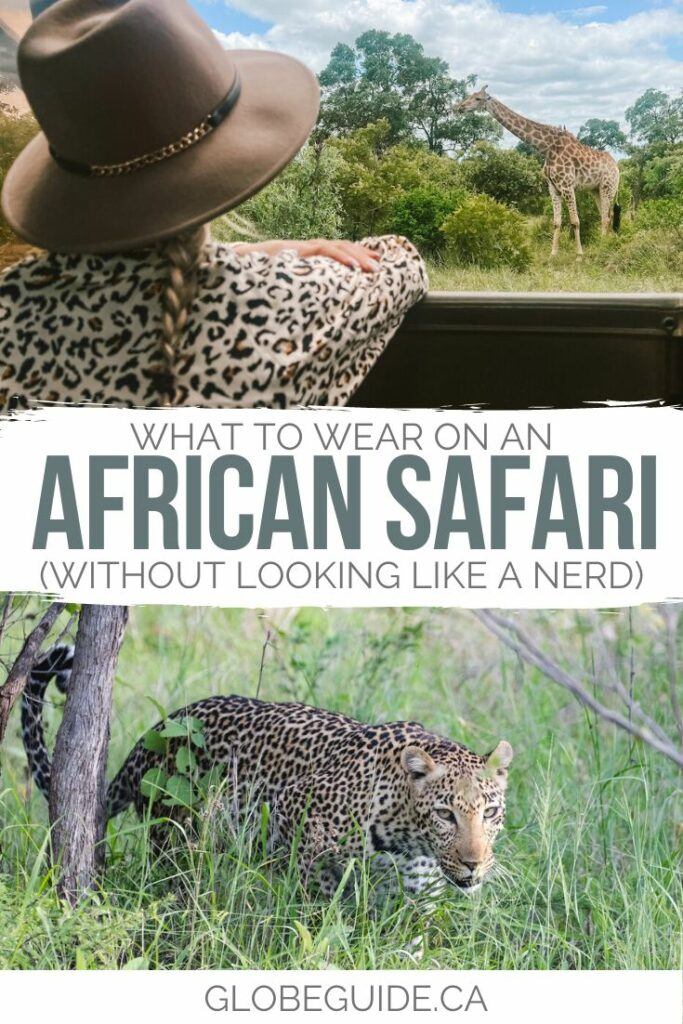
This post may contain affiliate links, which Globe Guide receives compensation for at no additional cost to you.
About The Author
Tamara Elliott
9 thoughts on “safari style: what to wear on a safari (without looking like a total nerd)”.
Where did you find a place you could rent cameras if I may ask? I live in Ontario, Canada and would love to have a good camera for my South Africa trip, but not sure I want to spend the $ buying one.
You can usually rent from local camera stores–that’s what I do for big lenses 🙂
Great post! I completely agree, it’s important to dress appropriately for a safari to blend in with the surroundings and not attract unwanted attention from wildlife. I’m definitely going to keep these tips in mind for my next safari adventure. Thanks for sharing!
Love this post!! We are going to South Africa in June and I’ve been obsessing over what I’ll pack. I’m an over packer by nature. Did you need many vaccinations prior to your trip? We’ll be mainly in South Africa, maybe Zimbabwe. Thanks for the great info! Much appreciated
Awesome! Not too many vaccinations but you should definitely visit a travel doctor/pharmacists to check, since it depends which parks you’re going to (in regards to malaria risk, for example). Enjoy your trip, it’s amazing!
Incredible photos! I wish I had thought to rent a camera for my trip. Great tip!
Great blog post! I completely agree that safari fashion doesn’t have to mean sacrificing style for comfort. I’ve always found that a good pair of neutral-colored pants and a patterned shirt can go a long way in making a stylish and practical outfit for a safari adventure. Thanks for the tips!
Totally, or even just a neutral outfit and then change up your accessories like a scarf or hat!
Hello Tamara Elliott, That’s what outfits every people looking for. Great blog post. Thank you for sharing…
Leave a Comment Cancel Reply
Your email address will not be published. Required fields are marked *
Save my name, email, and website in this browser for the next time I comment.

IMAGES
COMMENTS
Thus, wearing layers is essential. A good packing list for Africa will include plenty of cotton shirts to wear during the day, and a few sweaters and a light jacket to wear in the early morning hours and in the evenings. I also recommend bringing a scarf, a hat and gloves.
The Compass Rose Packing Cubes are now offered in two sizes: slim and medium. The slim size cubes measure 13 x 5 x 2.8, and the medium size cubes measure 2.8 x 13 x 8.5. Both fit an international carry-on suticase and can help you organize and compress clothing items. The medium sizes is great for bulkier items.
The Savvy Traveler's African Safari Packing List
Best Safari Clothing: Brands, Clothes & Tips for African ...
Best Safari Shirts for Women. There are three features you want to look for when selecting a safari shirt: → Lightweight. → Breathable fabrics. → UPF 40+ rating. All these features are discussed more in detail at the end of this blog post. Click here if you want to read more about these features and tips first.
Clothes to Pack for Safari . 5. Fleece Pullover / Rain Jacket. A cozy pullover will be good for the morning game drive. 6. Long Sleeved Tops & Comfortable Long Pants. Layers for chilly mornings and evenings. 7. Shorts & T Shirts . Lightweight summer clothes for the hot afternoons! 8. Swimsuit. Luxury safari camps will have a swimming pool so ...
It's actually illegal to wear camo gear in Ghana, Uganda, Zimbabwe and Zambia. Another group photo to help you decide what to pack for safari. Plastic bags: Disposable plastic bags are banned in Kenya, Uganda, and Rwanda. You should be fine with the little zip-lock one for your liquids on the plane, and I've used reusable plastic packing ...
Packing for an African safari is somewhat different to most other trips you'll take. Navigating rural roads in an open-top jeep means that you'll get covered in dust, so you'll need clothes that hide dirt well. Because temperatures can change dramatically throughout the day, layers are essential (after all, pre-dawn game drives are often chilly even in the height of summer).
Tips for packing for East Africa. Before we get into the details of what was on my ultimate Africa packing list, here are a few tips.. Packing tip #1: Choose comfy clothes. If you're wondering what to wear on safari, it's simple - comfortable clothes.You're going to spend a lot of time sitting in a car, so I think the best clothes to wear on safari are super comfy items.
Safari shirts. A few comfortable long-sleeved shirts and long-sleeved t-shirts. Long-sleeved safari shirts have the advantage of offering protection from the sun and insects, but also being able to roll the sleeves up if it gets too hot. Shirts with a collar to protect the neck from the harsh sun are advisable, as are shirts with pockets to ...
To a certain extent, the colors you wear while seated in the jeep during game drives is not as important as when walking in the bush. Having said that, here's the rule of thumb on colors: Blue and Black - attract tsetse flies that have a painful bite. Plus dark colors attract heat so it's best to avoid them.
Of course, the absolute best would be to go for sneakers as they will keep you up and above. If for some reason you cannot arrange for one, flip flops or sandals also work. 99% of the time you will be sitting in the jeep but Taj Safaris will take you for a nice nature walk, so you cannot be strolling around in heels. Suede ones at that.
What to Wear on Safari
What to Wear on Safari | Colour Guide for Your Safari Outfit
What to Wear on Safari. This is our infographic cheat sheet for packing for a safari. it is a visual - & quick - guide on men's and women's safari clothing advice and what to wear on safari - an additional visual travel resource as you prepare for your safari.
The 7 Safari Outfits you will Pack for your First Safari. There are plenty of options for what to wear on an African safari but I suggest sticking with primarily khaki or olive colors. The safari tours in Kruger National Park are viewed from within the confines of an overland truck or 4×4 car.
Organize Your Clothing Organizing your safari clothing makes life so much easier, particularly if you have onward travel to another destination. Use packing cubes to place your safari clothes on the top for easier access and less mess. Read More: Riu Palace Resort Zanzibar - Our Honest Review. Clothing for your African Safari Packing List: 1.
Jeep apparel and merchandise from the official store
Couple outside safari tent Choosing African Safari Clothes: Material Considerations for Comfort and Safety 💨 Breathable Fabrics. Choose materials like lightweight cotton or linen. They keep you cool and wick away moisture. 🚶♂️ Long Sleeves and Trousers. These are essential to protect you from the sun and bug bites.
Let's Trip 6M Safari Jeep Hoodie - Black. $60.00. Sold out. Shipping calculated at checkout. Pay in 4 interest-free installments of $15.00 with. Learn more. Learn more. Size. XS S M L XL 2XL 3XL 4XL.
Jeep Official Apparel and Outdoor Clothing
what to wear for Jeep Safari what to wear for Jeep Safari 1. Light and Comfortable Clothing. Opt for lightweight and breathable clothing to beat the heat and humidity of the jungle. Cotton and moisture-wicking fabrics are ideal choices as they allow air circulation and help keep you cool and dry throughout the safari. Loose-fitting shirts, t ...
Safari packing list. Clothing: T-shirts/tank tops. Long sleeved shirts/light sweaters. Light jacket/raincoat. Shorts. Long pants. Walking shoes such as runners. Flip-flops for back at camp.